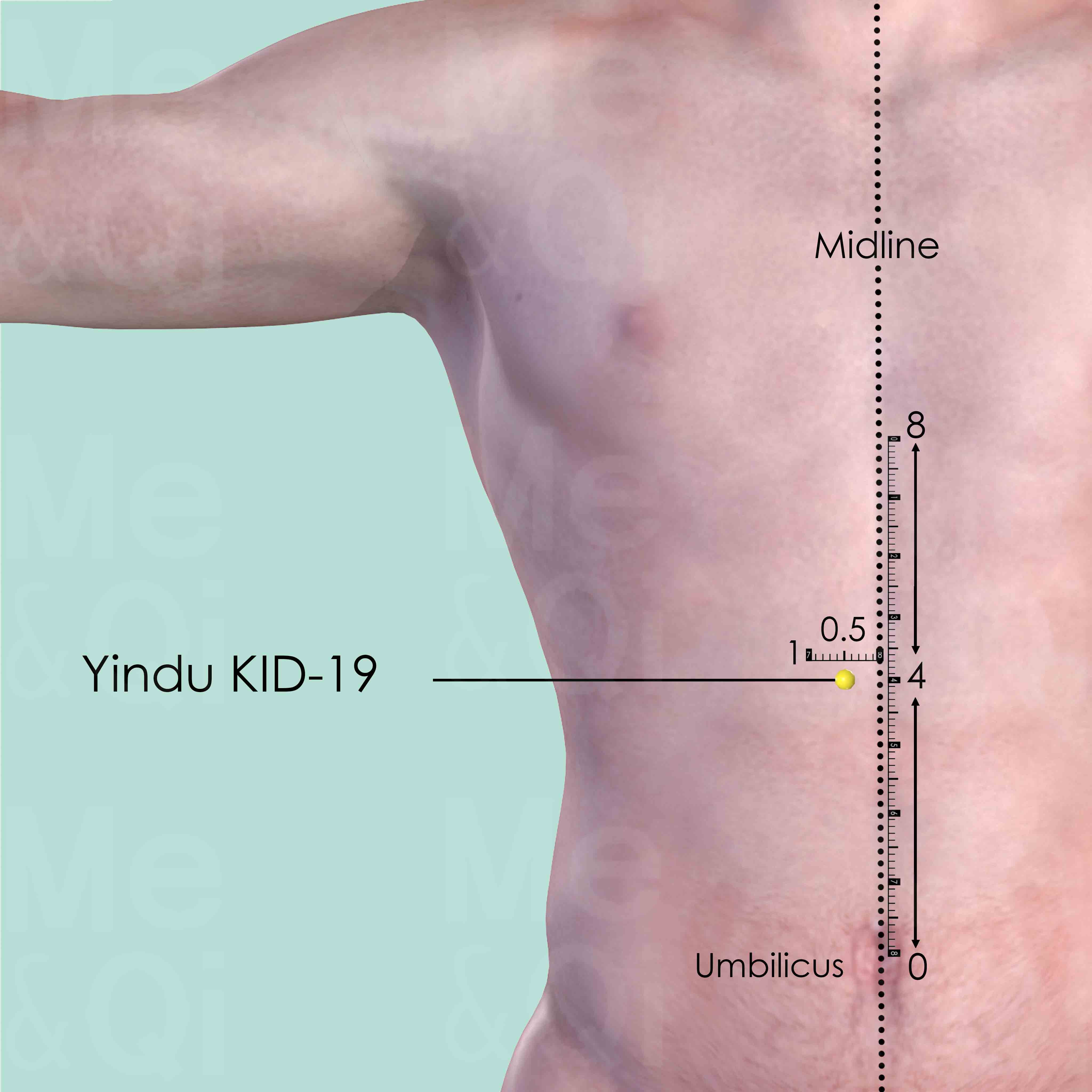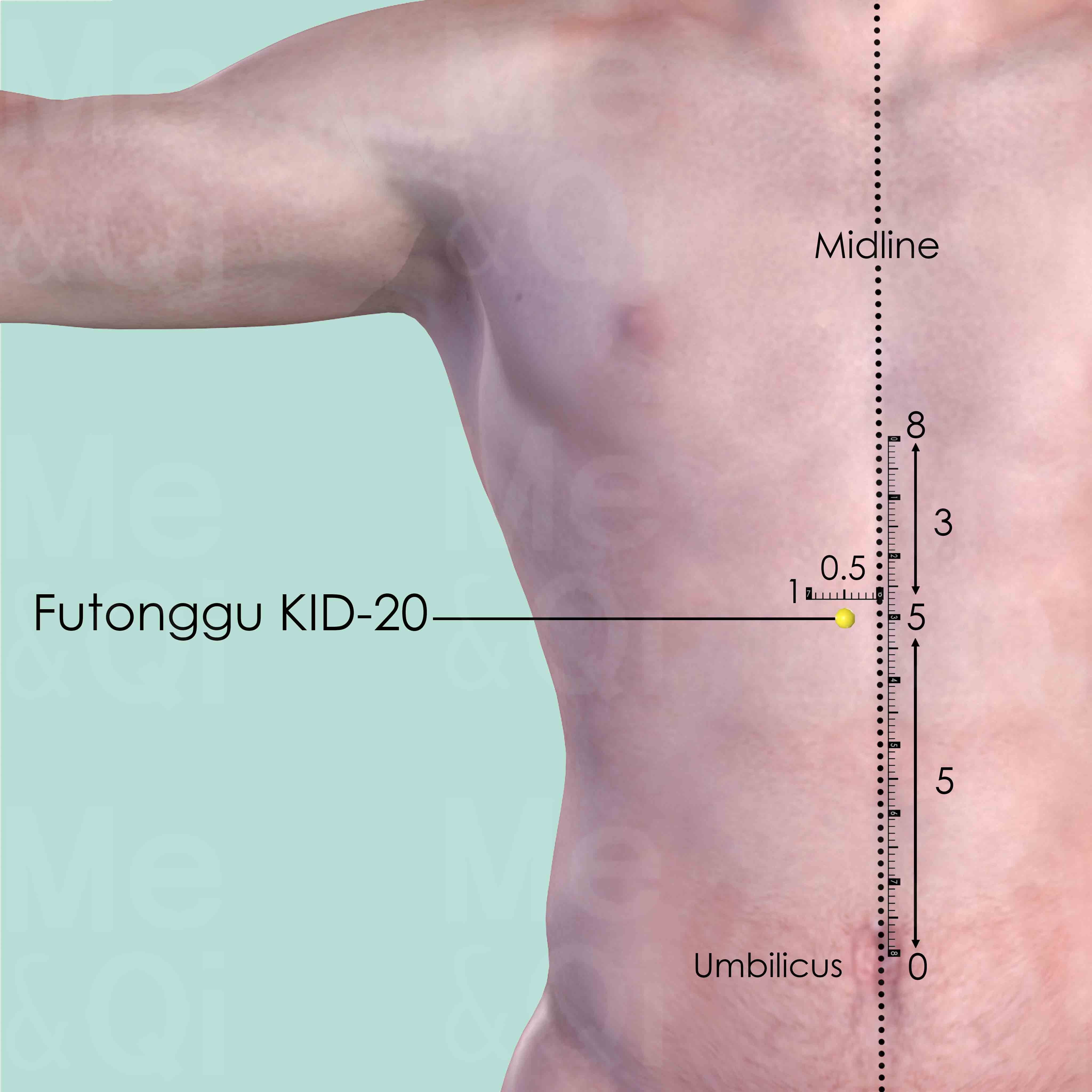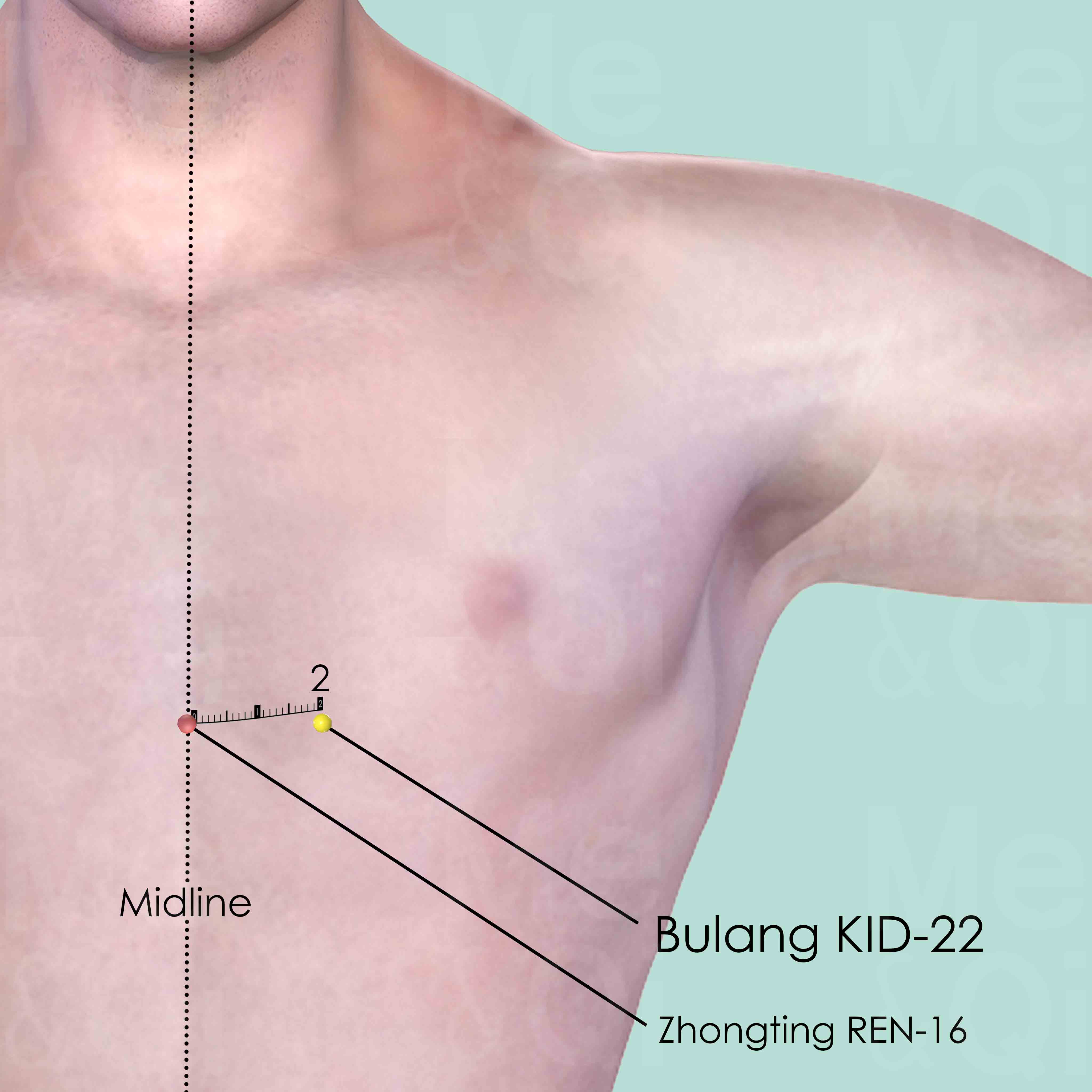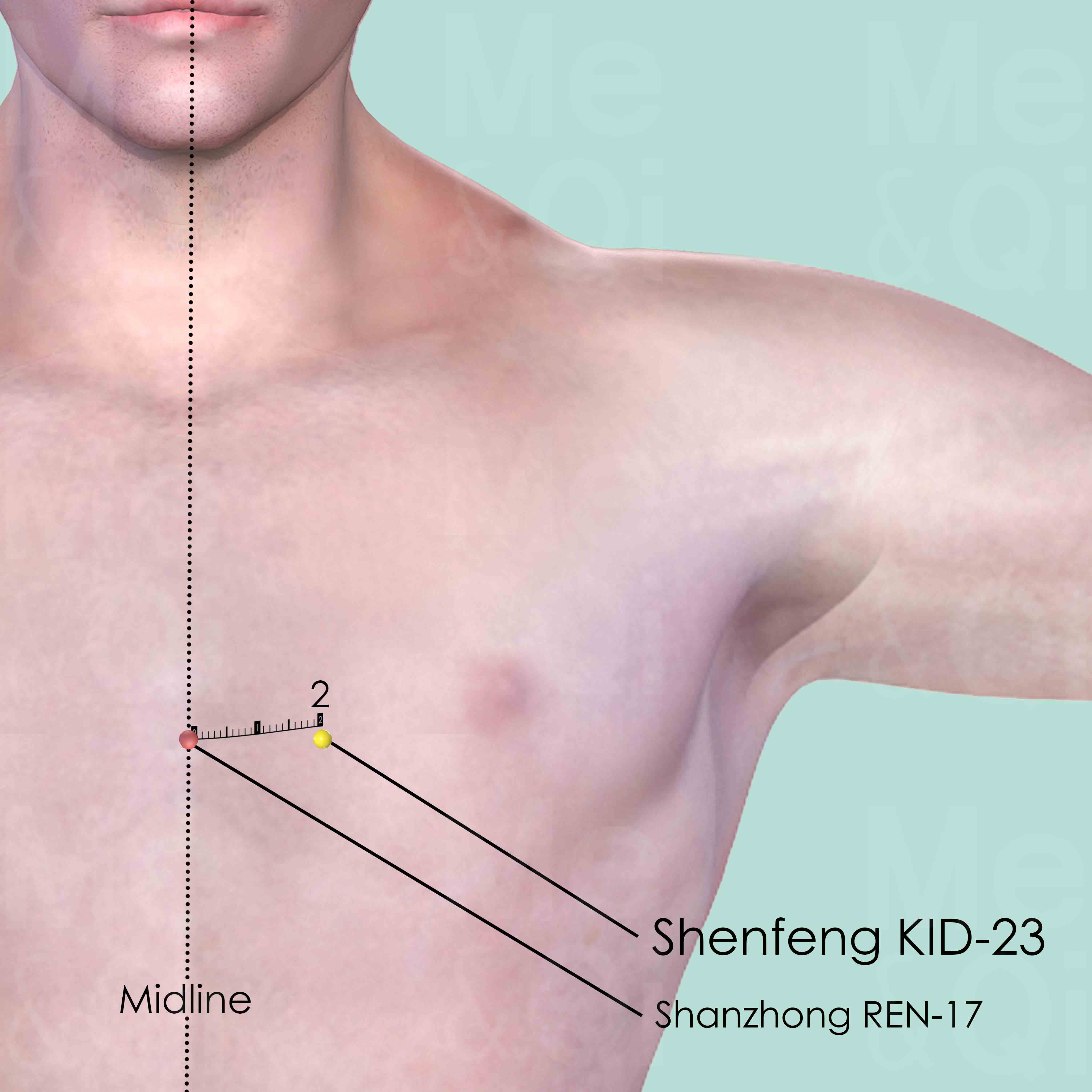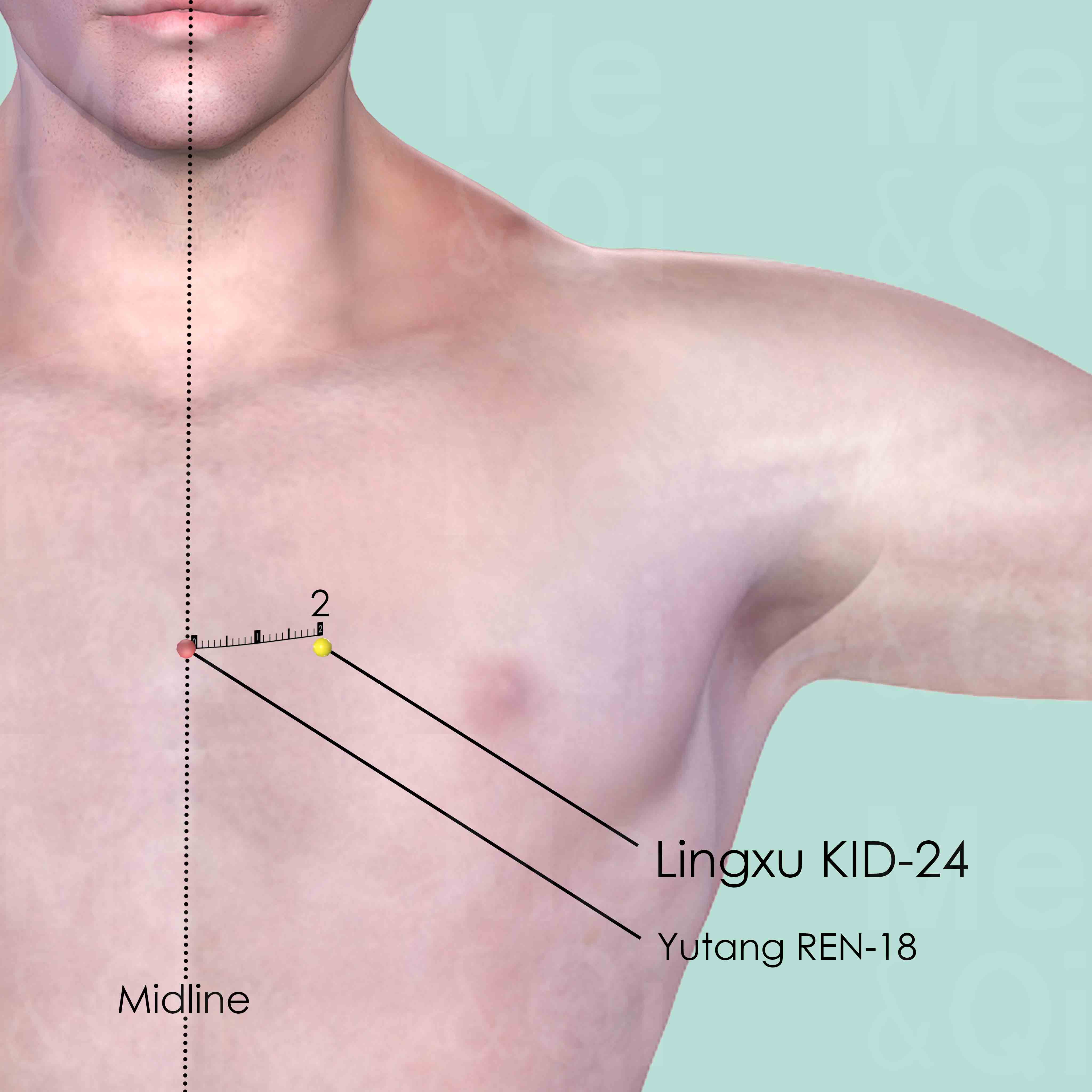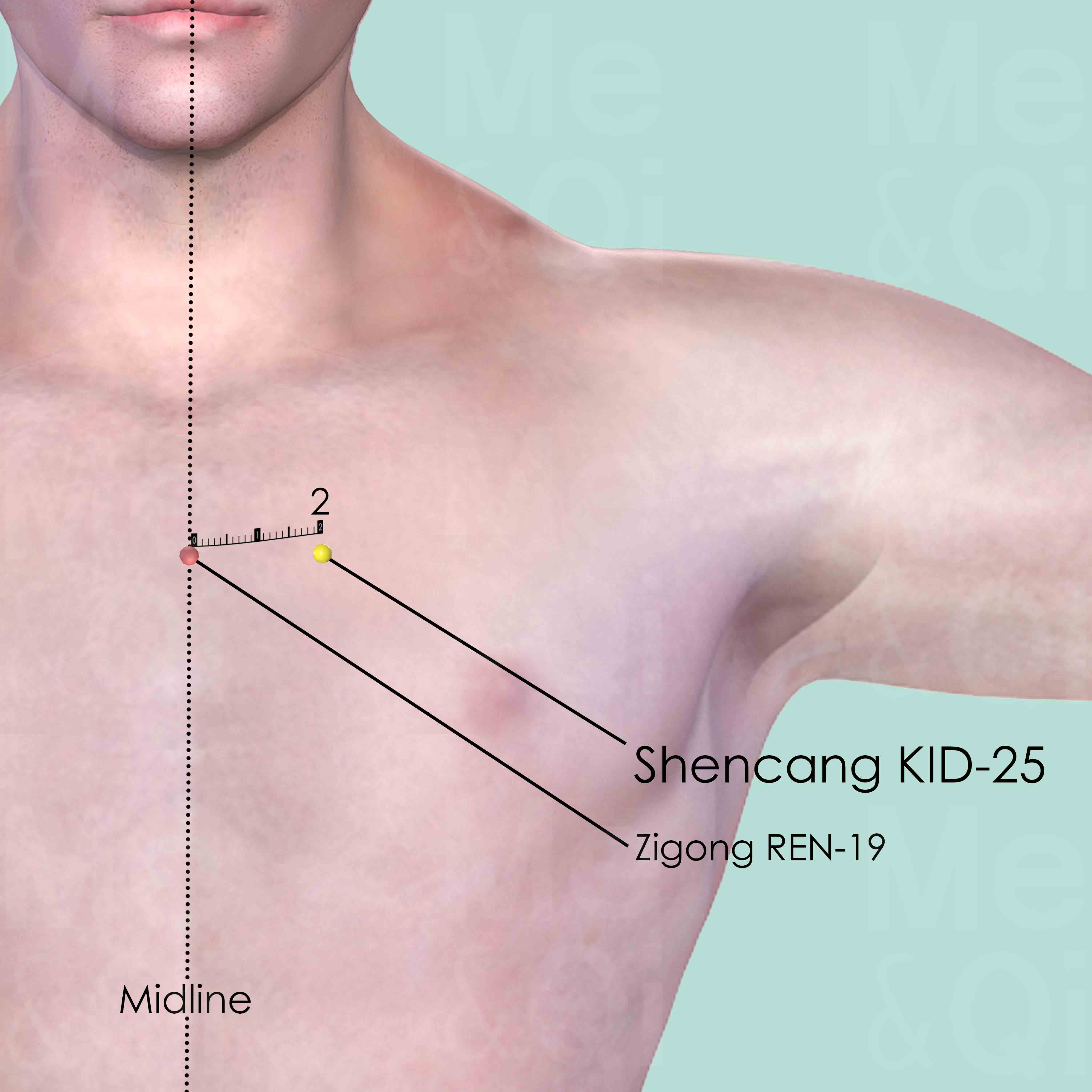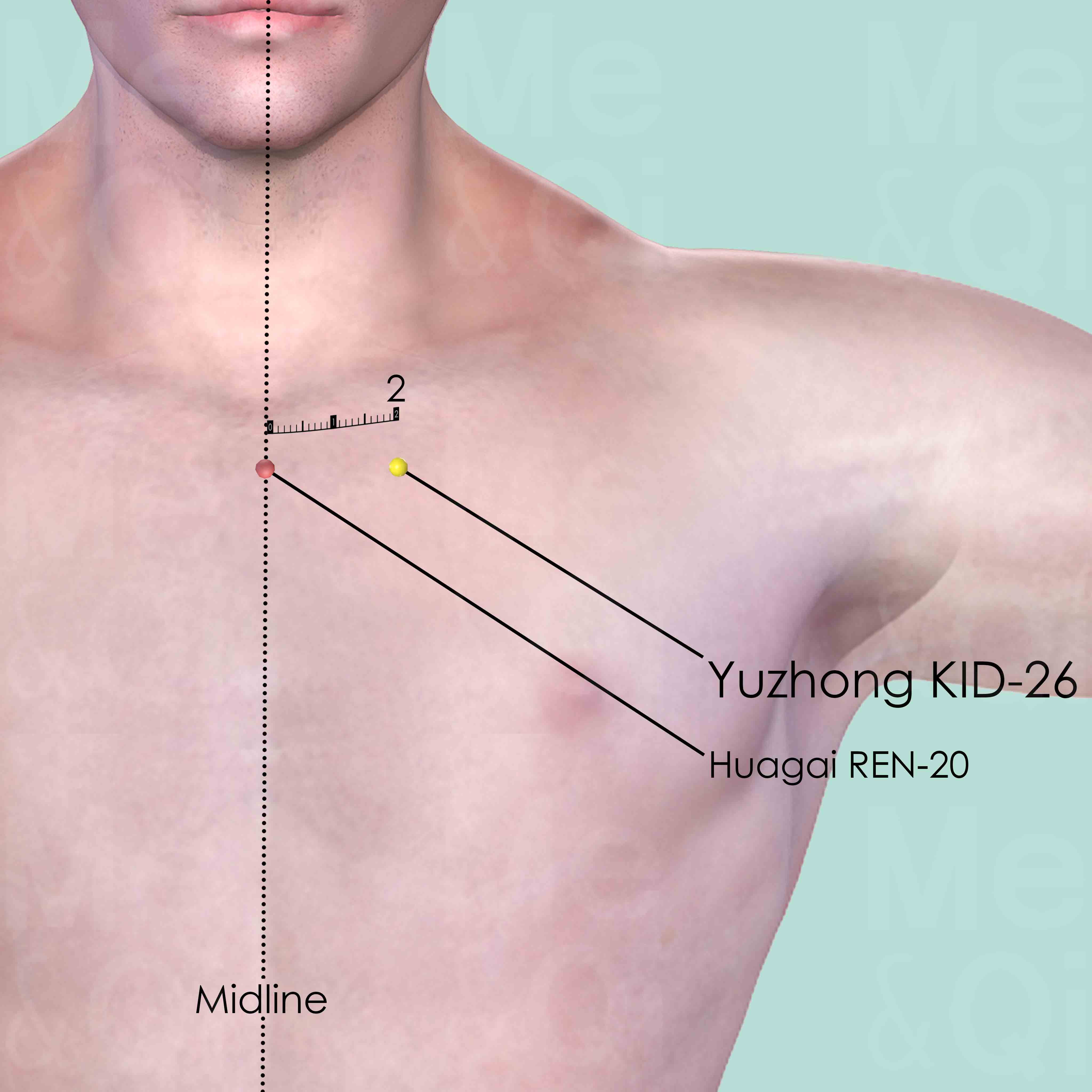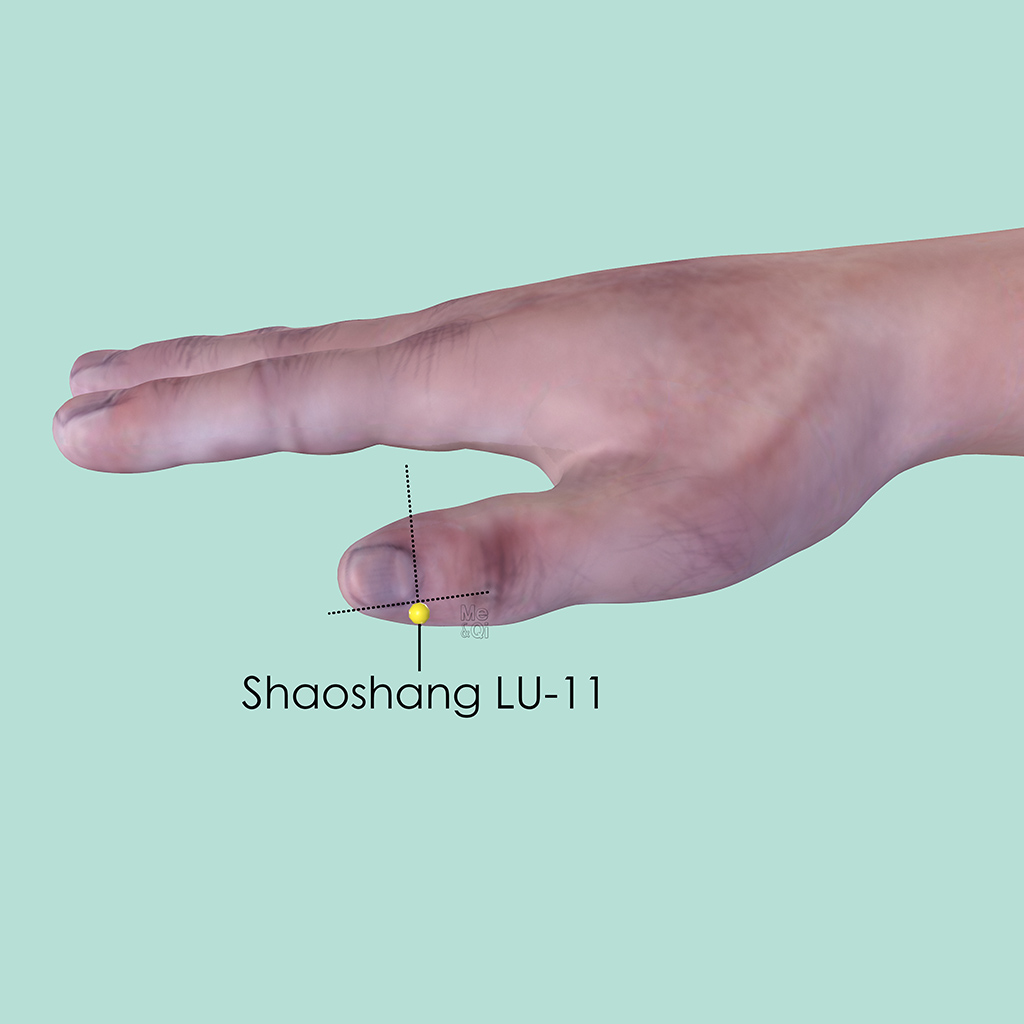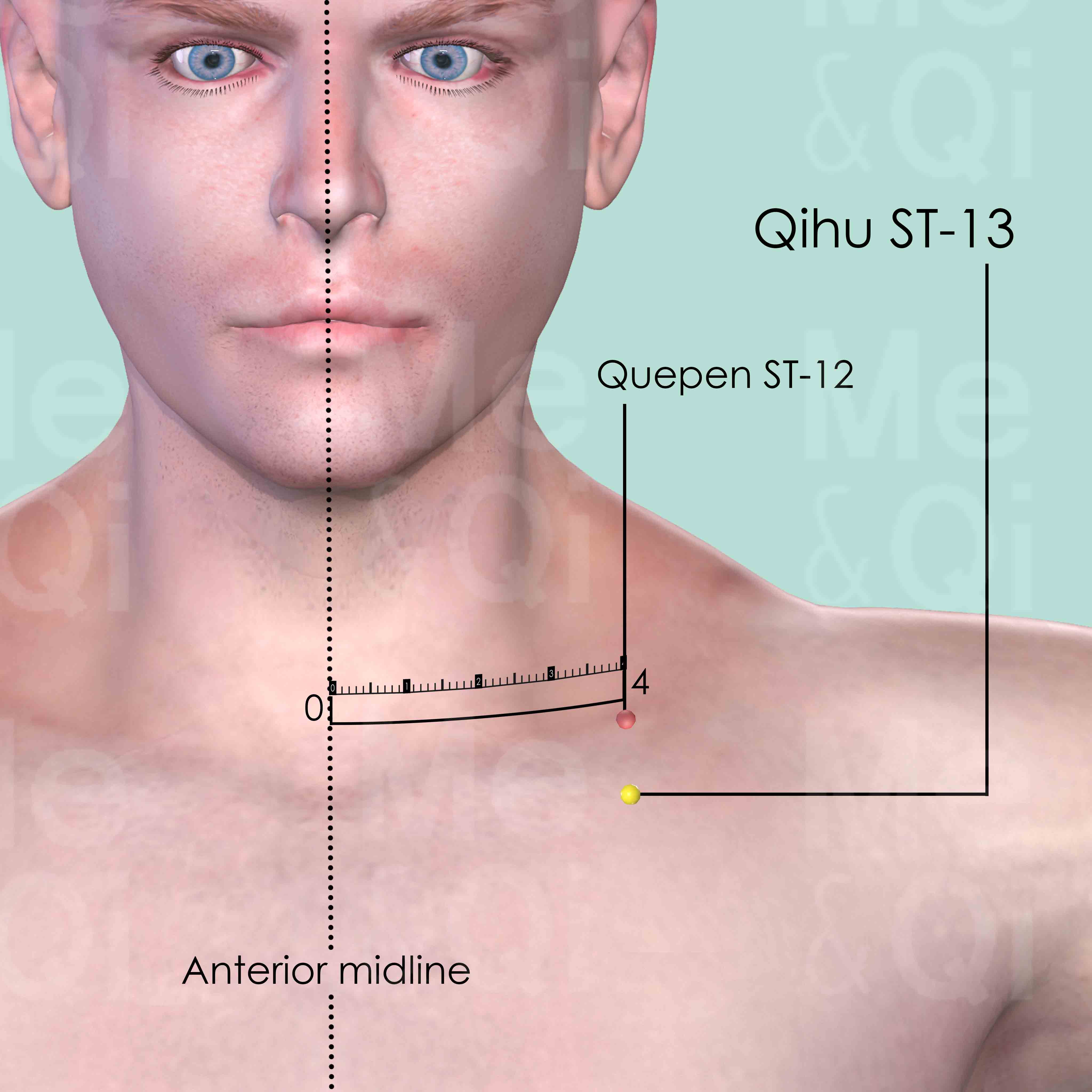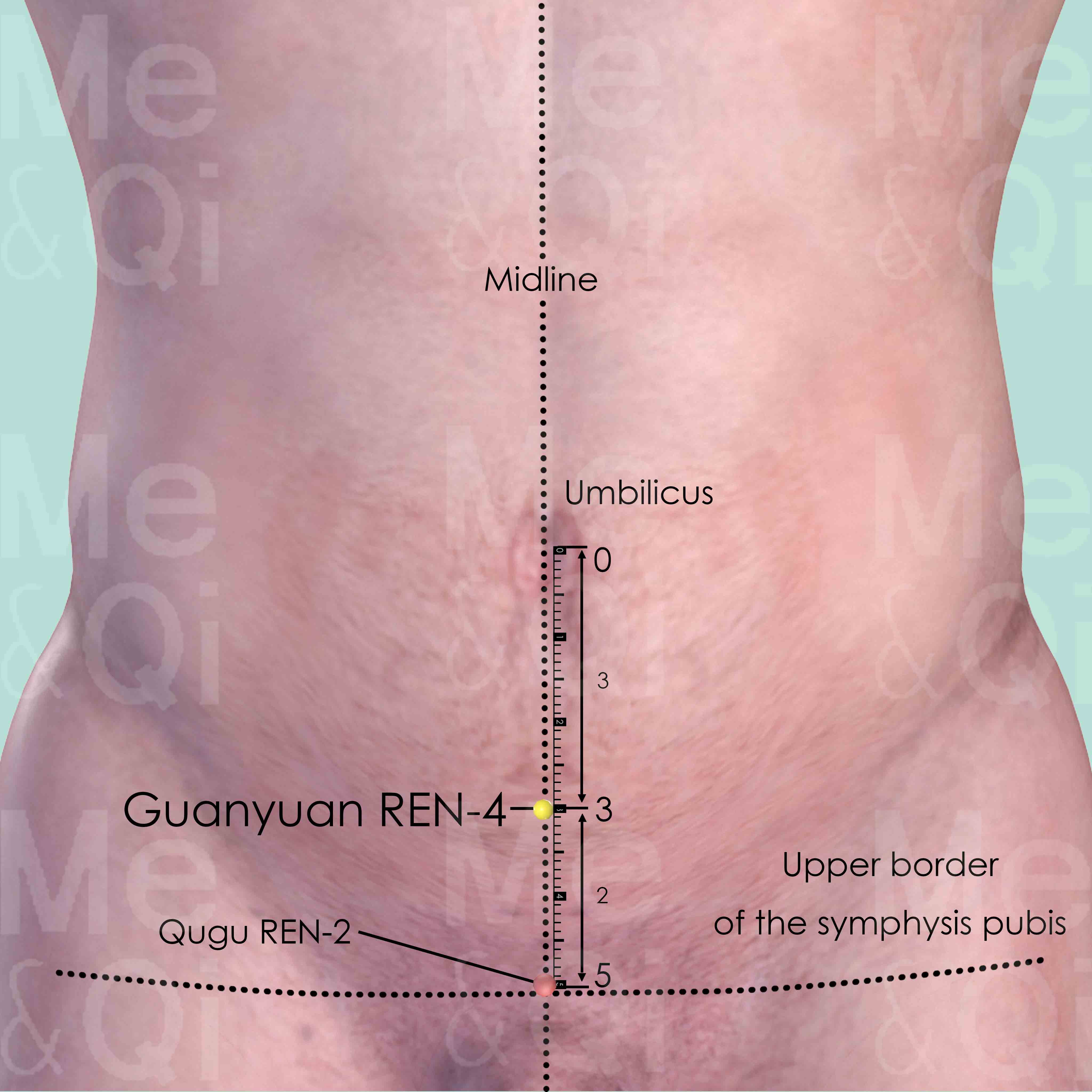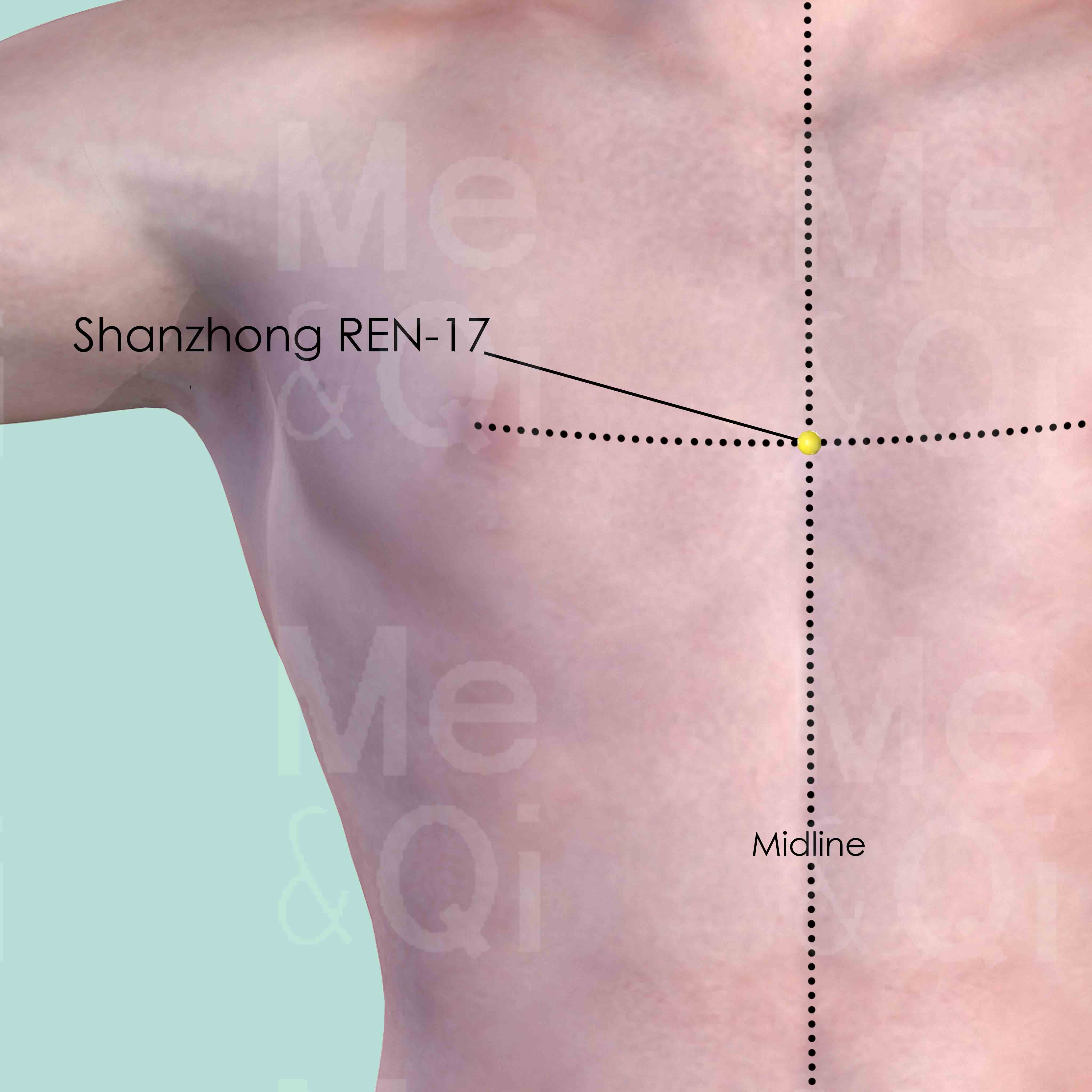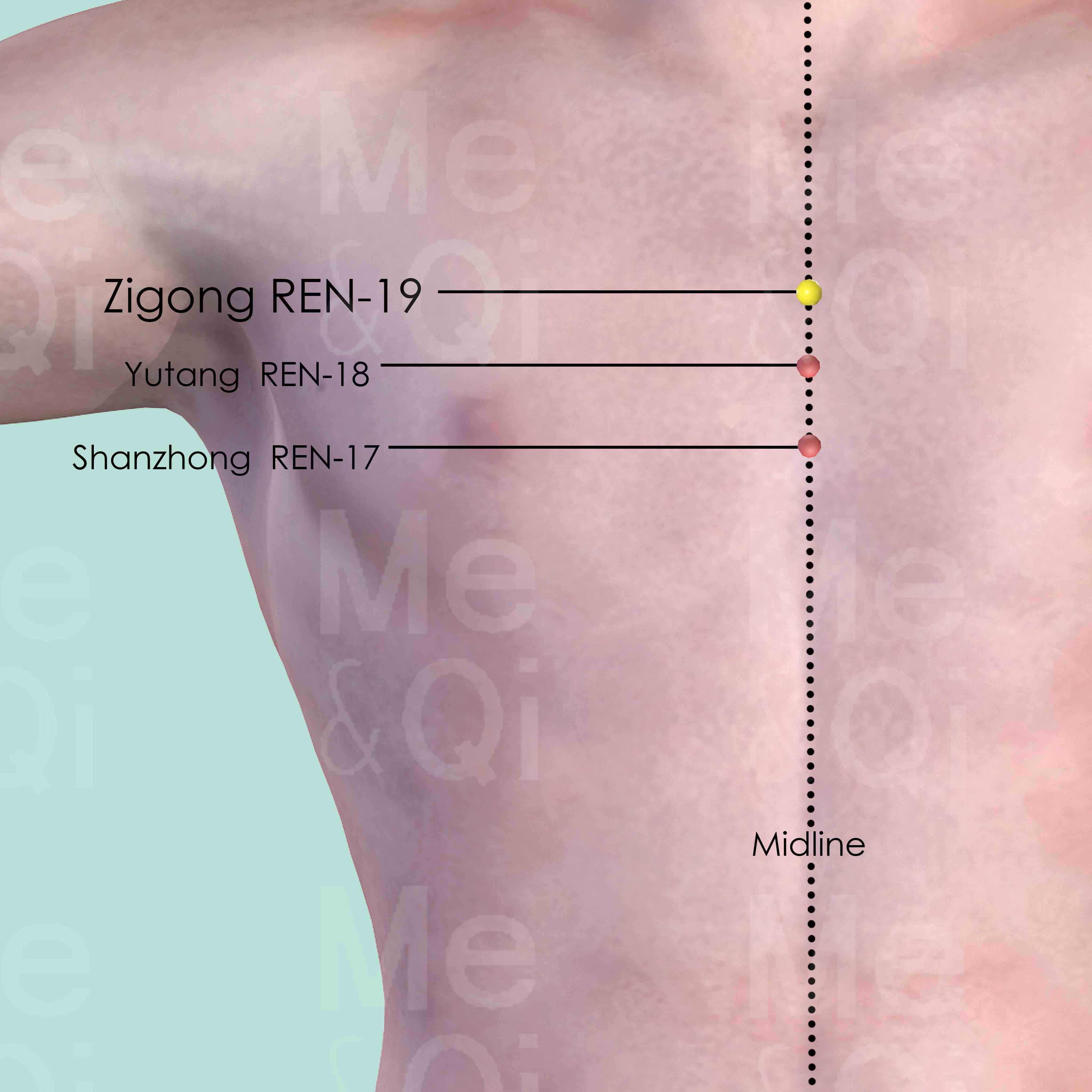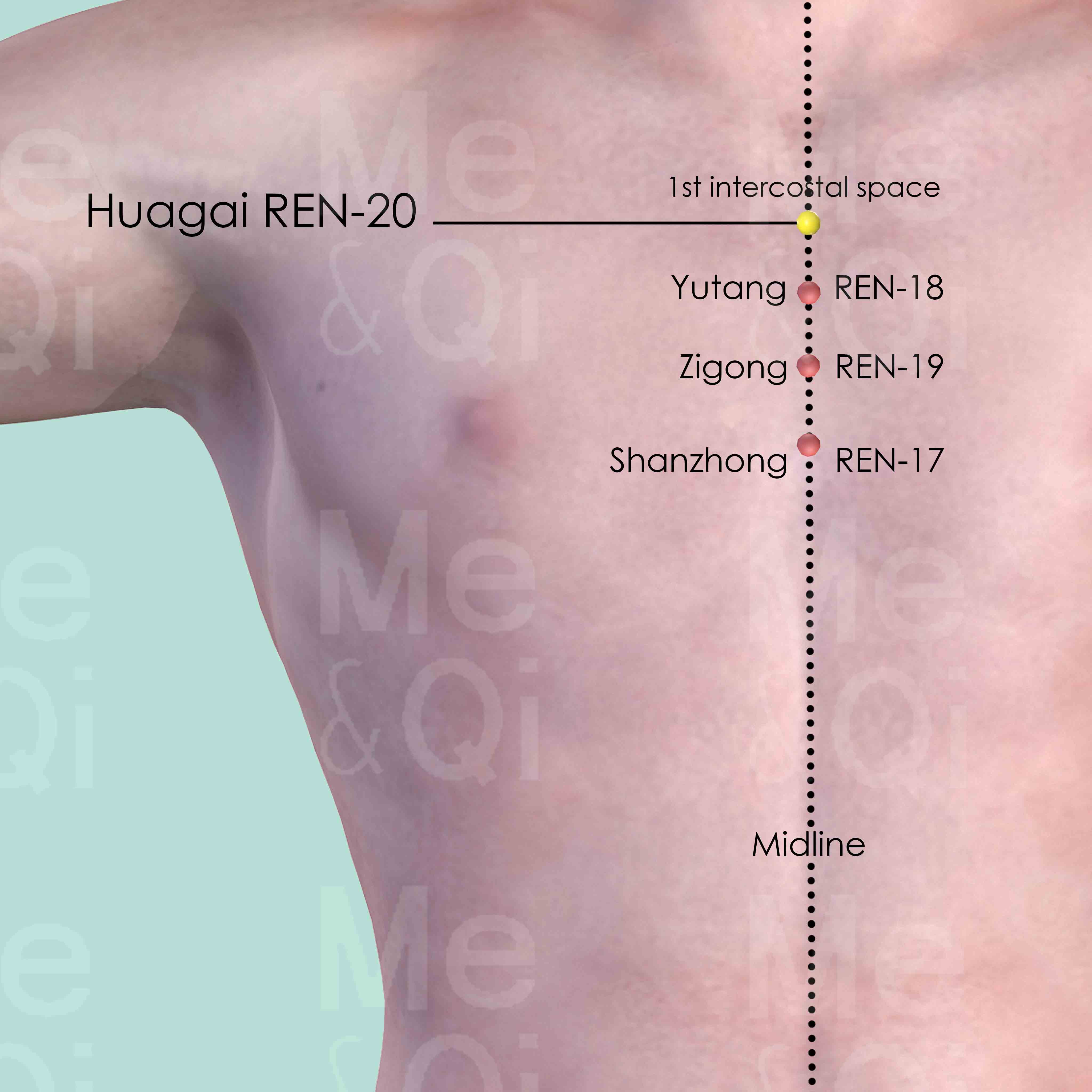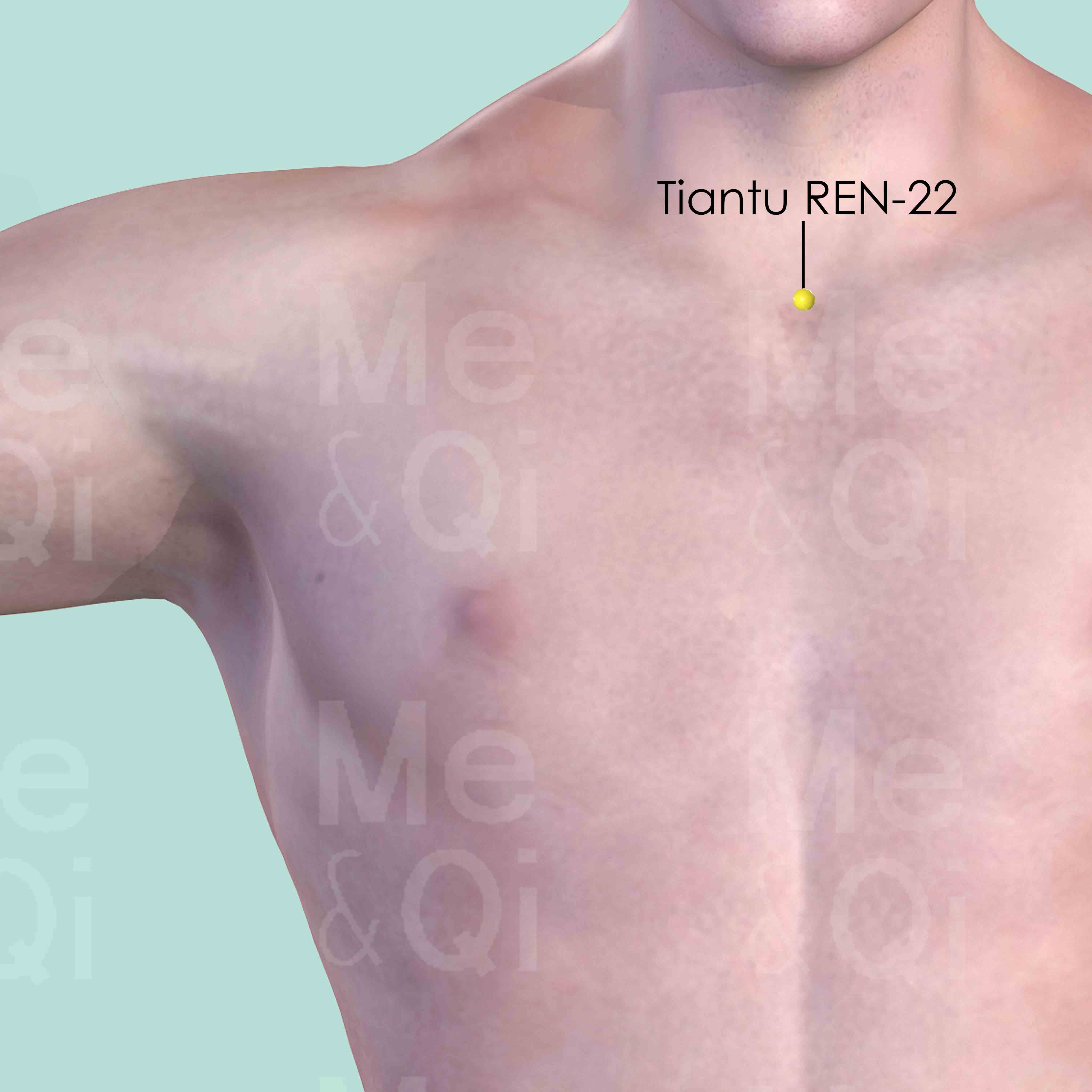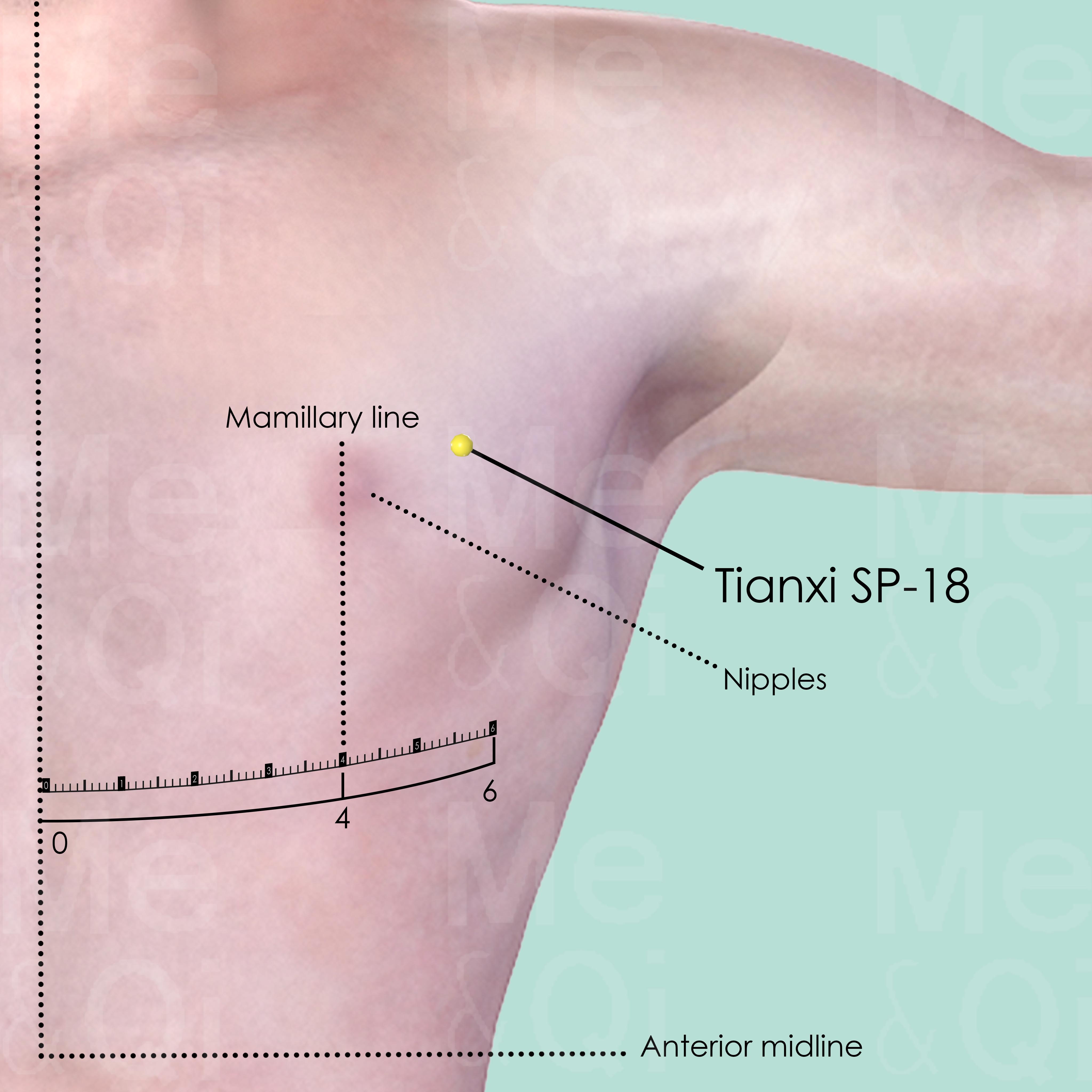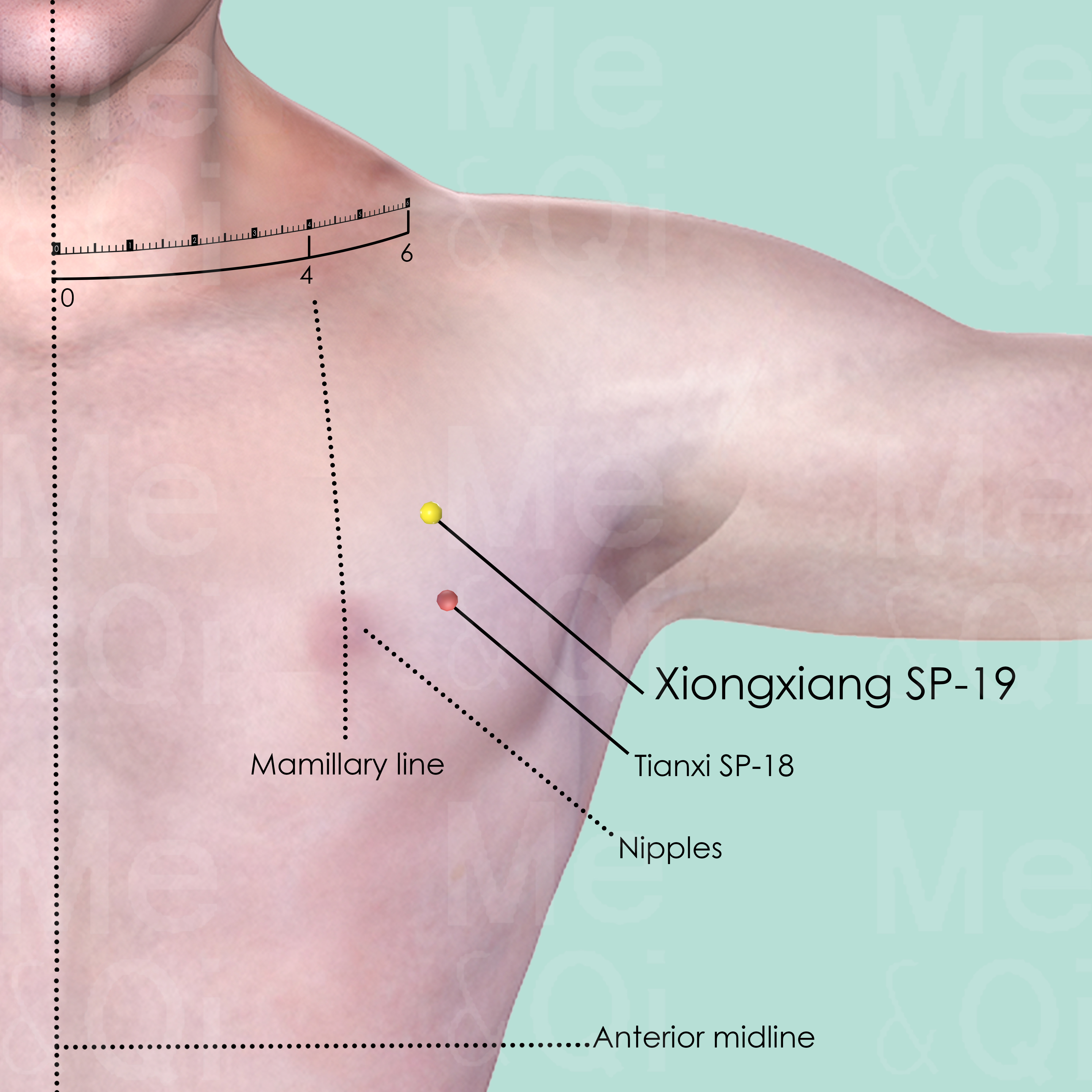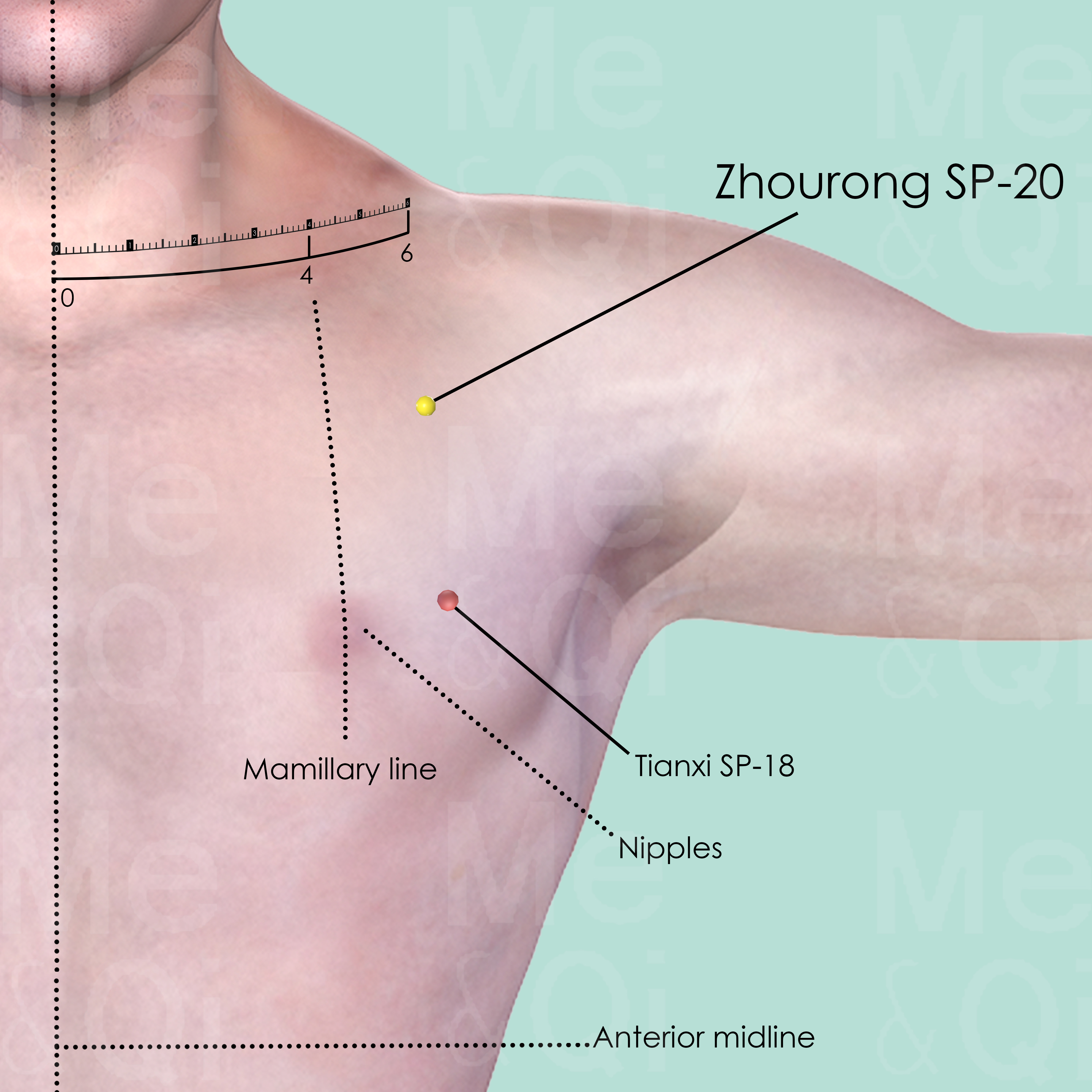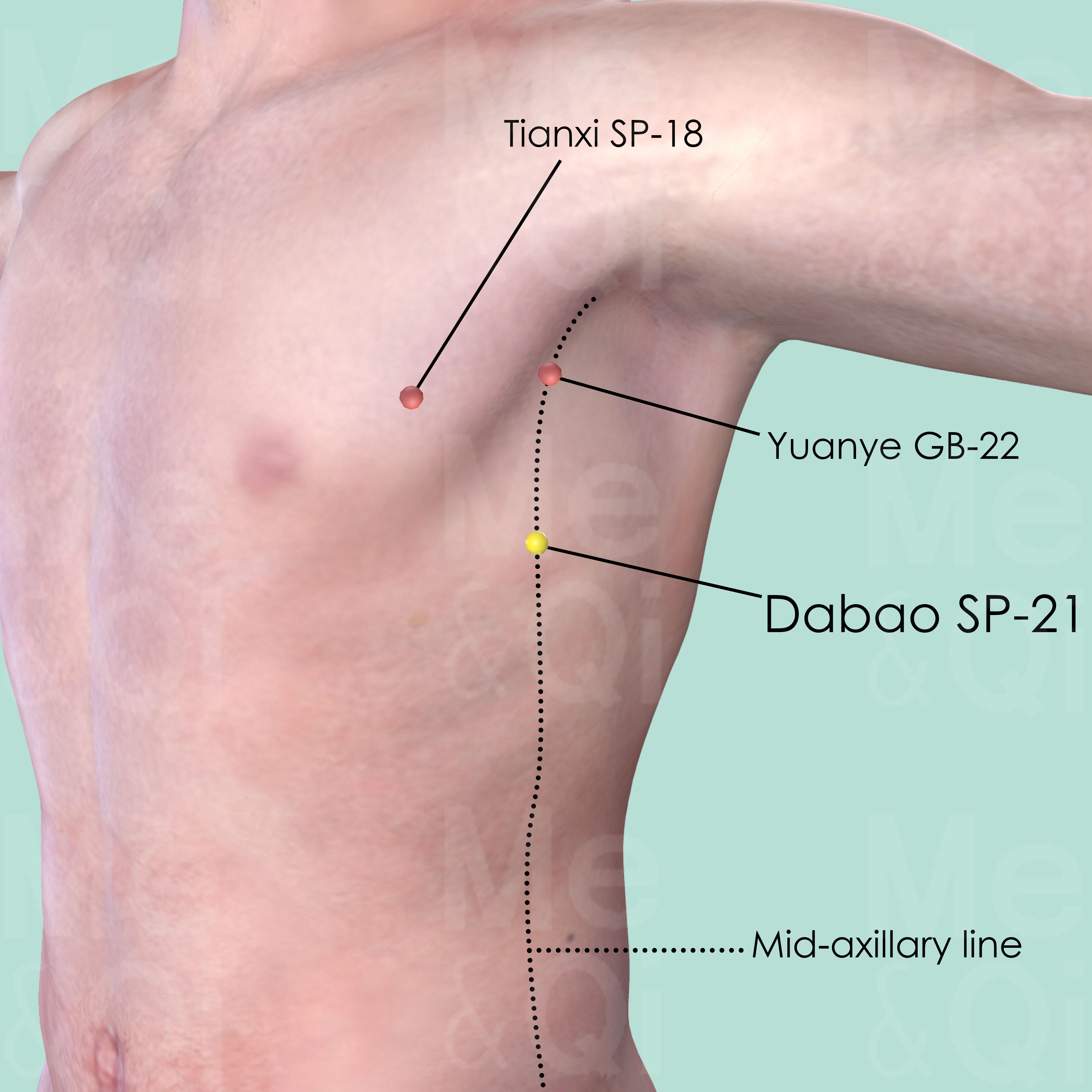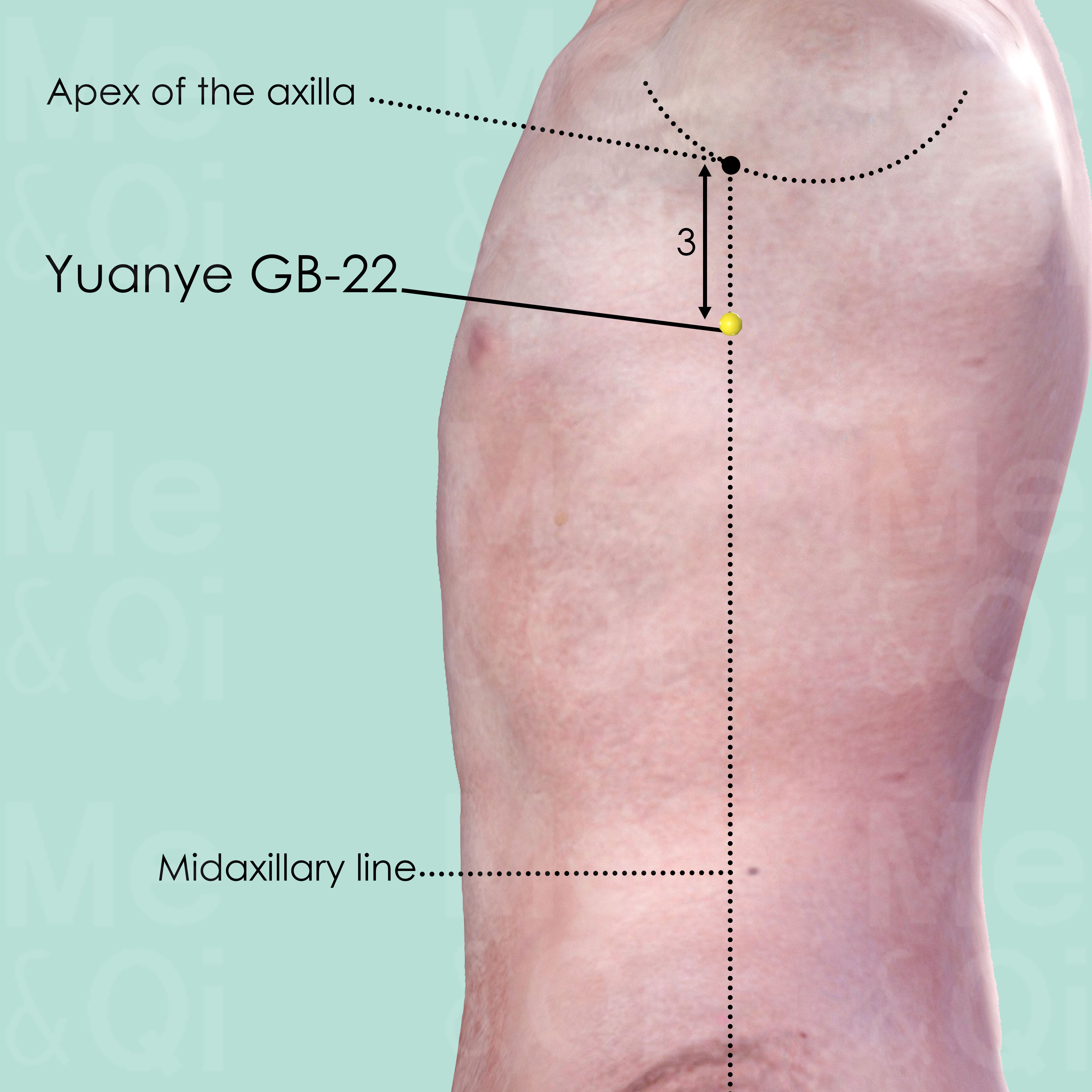Coughingaccording to TCM
Symptom family: Cough Related Symptoms
Sub-symptom(s): Chronic Coughing
What is Coughing?
Coughing is a reflex action the body employs to clear the throat and airways of mucus, fluid, irritants, foreign particles, and microbes. It is a common symptom that can be acute, lasting less than three weeks, or chronic, persisting for longer periods.
While often benign and self-limiting, persistent coughing can indicate a variety of underlying conditions, ranging from infections like the common cold to chronic lung diseases such as asthma or COPD. Understanding the nature and characteristics of a cough is crucial for diagnosis and treatment.
How does TCM view Coughing?
Traditional Chinese Medicine (TCM) perceives coughing as a sign of disharmony within the body, often involving the lungs, spleen, and kidney channels. Unlike the symptomatic approach of Western medicine, TCM seeks to identify the underlying pattern of imbalance causing the cough.
This holistic perspective considers coughing a manifestation of factors such as external pathogens, internal organ imbalances, or Qi (vital energy) obstruction. Identifying the specific TCM pattern is essential, as treatments are tailored to correct these imbalances and restore harmony to the body's systems.
Root Causes of Coughing in TCM
In TCM, coughing can arise from several patterns, with Cold-Phlegm in the Lungs and Damp-Phlegm in the Lungs being two primary causes. Cold-Phlegm is characterized by symptoms like coughing with white, watery sputum, and a feeling of chest oppression, suggesting an accumulation of cold and dampness affecting lung function.
Damp-Phlegm presents with coughing, a pale face, and a stifling sensation in the chest, indicating excessive dampness leading to phlegm production. These patterns reflect TCM's understanding of coughing as not merely a physical symptom but an indication of deeper imbalances within the body.
Explore below more details about what might cause Coughing according to TCM.
- By Syndrome
- By Organ
- Phlegm
- Qi Deficiency
- Wind
- Cold
- Dampness
- Heat
- Yang Deficiency
- Qi Rebellion
- Blood Deficiency
- Qi Stagnation
- Dryness
- View More Causes
- Lung
- Kidney
- Spleen
- Heart
- Triple Burner
- Liver
- View More Organs
Phlegm
In TCM "Phlegm" as a pattern of disharmony is a complex concept that extends beyond the physical manifestation of mucus. It represents a pathological factor that can disrupt the flow of Qi (vital energy) and blood, leading to various health issues. Phlegm in TCM is seen as a sticky, turbid substance arising from the body's inability to metabolize fluids properly, often due to a dysfunction of the spleen. It's not only associated with respiratory problems like cough and congestion but also with systemic issues. Symptoms can include a feeling of heaviness, mental cloudiness, dizziness, and in some cases, the formation of lumps or masses. Phlegm can even be "invisible," contributing to emotional disturbances like depression or stress. ... see more
Phlegm Patterns That Can Lead to Coughing
Common Symptoms: Shortness Of Breath Dizziness Feeling Of Heaviness Stifling Sensation In The Chest Asthma Sputum Wheezing Chest Distension
| Pattern Name | Relevant Symptoms | Relevant Formulas |
|---|---|---|
| Cold-Phlegm in the Lungs | Coughing, White and watery sputum, Chills, Cold hands, Sputum, Dizziness, Feeling of oppression of the chest, Feeling of heaviness... see more | Ling Gui Zhu Gan Tang | Ling Gan Wu Wei Jiang Xin Tang | San Zi Yang Qin Tang |
| Damp-Phlegm in the Lungs | Coughing, Pale face, Sputum, Stifling sensation in the chest, Shortness of breath, Discomfort when lying down, Wheezing, Nausea, Feeling of heaviness, Dizziness, Profuse white sputum, Asthma, Chest distension... see more | Er Chen Tang |
| Phlegm-Fluids | Coughing, Abdominal distention, Vomiting clear liquid, Feeling of heaviness, Shortness of breath, Hypochondrial pain that is worse on coughing and breathing, Lack of sweating, Absence of thirst, Edema, Chest distension... see more | Ling Gui Zhu Gan Tang | Er Chen Tang | Wu Ling San | Wen Dan Tang |
| Phlegm-Fluids above the diaphragm | Coughing, Asthma, Edema, Feeling of oppression of the chest, Dizziness, Profuse white sputum... see more | Xiao Qing Long Tang | Ling Gan Wu Wei Jiang Xin Tang |
| Phlegm-Fluids in the hypochondrium | Coughing, Hypochondrial pain that is worse on coughing and breathing, Shortness of breath, Hypochondriac distention... see more | Shi Zao Tang |
| Phlegm-Fluids in the Lungs | Coughing, White and watery sputum, Shortness of breath, Gurgling noise in the chest, Stifling sensation in the chest, Feeling of heaviness, Dizziness, Chills, Cought with sticky phlegm, Itchy throat... see more | Ling Gan Wu Wei Jiang Xin Tang | Zhi Sou San |
| Phlegm-Heat in the Lungs | Coughing, Shortness of breath, Wheezing, Stifling sensation in the chest, Sputum, Feeling hot, Thirst, Head and body heaviness, Dizziness, Copious thick yellow sputum... see more | Er Chen Tang | Ren Shen Ge Jie San | Wen Dan Tang | Qing Qi Hua Tan Wan | Ma Xing Shi Gan Tang | Qing Xin Li Ge Tang | Pi Pa Qing Fei Yin |
| Phlegm in the Lower Burner | Coughing, Throbbing below the belly button, Vomiting frothy saliva, Vertigo, Shortness of breath, Edema, Glomerulonephritis, Kidney infection, Nephrotic syndrome, Cystitis, Hydrocele... see more | Wu Ling San |
Qi Deficiency
Qi Deficiency in TCM is like running low on battery power. Qi is the vital energy that powers every function in your body. When there's a Qi Deficiency, it means your body doesn't have enough of this essential energy. This can make you feel tired all the time, weak, or even cause shortness of breath. It's similar to how you feel when you haven't had enough sleep or nutritious food. Your body just doesn't have the energy it needs to perform at its best. Unlike modern medicine, which often focuses on specific physical causes for fatigue and weakness, TCM views Qi Deficiency as an overall energy depletion that affects your entire well-being, and it seeks to replenish and balance this vital energy.... see more
Qi Deficiency Patterns That Can Lead to Coughing
Common Symptoms: Shortness Of Breath Generalized Fatigue Weak Voice Reluctance To Speak Frequent Colds Or Flu Pale Face Palpitations Spontaneous Sweat
| Pattern Name | Relevant Symptoms | Relevant Formulas |
|---|---|---|
| Lung and Heart Qi Deficiency | Coughing, Shortness of breath, Weak voice, Reluctance to speak, Pale face, Frequent colds or flu, Generalized fatigue, Palpitations, Depression, Spontaneous sweat, Sighing... see more | Si Jun Zi Tang | Bao Yuan Tang |
| Lung Qi Deficiency | Coughing, Diurnal hyperhidrosis, Reluctance to speak | Si Jun Zi Tang | Jiu Xian San | Bu Fei Tang | Ren Shen Ge Jie San | Zhi Gan Cao Tang |
| Qi Deficiency | Coughing, General weakness, Weak voice, Generalized fatigue, Low energy, Reluctance to speak, Spontaneous sweat, Frequent colds or flu, Lack of appetite, Diarrhea, Shortness of breath... see more | Si Jun Zi Tang | Liu Jun Zi Tang |
| Spleen and Lung Qi Deficiency | Coughing, Lack of appetite, Slight abdominal distension after eating, Generalized fatigue, General weakness, Pale face, Weak limbs, Diarrhea, Obesity, Shortness of breath, Weak voice, Spontaneous sweat, Reluctance to speak, Frequent colds or flu, Aversion to cold... see more | Si Jun Zi Tang | Liu Jun Zi Tang |
| Wind-Cold-Damp invading with Qi Deficiency | Coughing, High fever, Fever without perspiration, Headaches, Neck pain, Stiff neck, Painful extremities, Focal distention, Chest distension, Congested nose, Noisy breathing... see more | Ren Shen Bai Du San |
| Heart and Spleen Qi and Blood Deficiency | Coughing, Palpitations, Poor memory, Restless sleeplessness, Fever, Lack of appetite, Generalized fatigue, Shortness of breath, Exertional dyspnea, Weight loss, Skin dryness... see more | Ren Shen Yang Rong Tang |
| Lung Qi Deficiency and Liver Qi Stagnation | Coughing, Hypochondrial fullness with warmth relief, Dizziness, Headaches, Depression, Low energy, Moving pain, Hepatitis, Chronic cholecystitis, Chronic gastritis, Peptic ulcer... see more | Xiao Chai Hu Tang |
Wind
In TCM "Wind" is a concept that represents a pattern of disharmony, often characterized by its sudden and unpredictable nature, much like a gusty wind changing direction without warning. This pattern is associated with symptoms that come and go quickly or move around the body, such as itching, tremors, or even certain types of pain. Wind is considered to be a primary cause of illnesses that have these rapidly changing characteristics. In TCM, external Wind often refers to illnesses that start suddenly, like the common cold, believed to be caused by external pathogenic factors like climatic changes. On the other hand, internal Wind can be linked to internal imbalances and can manifest in conditions like dizziness or spasms. ... see more
Wind Patterns That Can Lead to Coughing
Common Symptoms: Aversion To Cold Fever Headaches Nasal Discharge Sneezing Congested Nose Itchy Throat Sore Throat
| Pattern Name | Relevant Symptoms | Relevant Formulas |
|---|---|---|
| Exterior Wind | Cough, Aversion to cold, Fever, Headaches, Anemophobia, Nasal discharge, Clear sputum, Itchy throat, Sneezing, Coughing, Muscle pain, Itchy skin... see more | Chuan Xiong Cha Tiao San |
| Wind-Cold-Water invading the Lungs | Cough, Ocular swelling, Shiny complexion, Scanty clear urination, Fever, Coughing, Shortness of breath, Aversion to cold, Facial edema... see more | Xiao Qing Long Tang |
| Wind-Cold | Coughing, Aversion to cold, Fever, Sneezing, Nasal discharge, Occipital headache, Occipital stiffness, Congested nose, White and watery sputum... see more | Jin Fei Cao San | Jing Fang Bai Du San | Cong Chi Tang | Huo Ren Cong Shi Tang | Ma Huang Tang | Jiu Wei Qiang Huo Tang | Jia Wei Xiang Su San | Shi Shen Tang | Wu Ji San |
| Wind-Cold-Damp invading with Qi Deficiency | Coughing, High fever, Fever without perspiration, Headaches, Neck pain, Stiff neck, Painful extremities, Focal distention, Chest distension, Congested nose, Noisy breathing... see more | Ren Shen Bai Du San |
| Wind-Heat | Coughing, Aversion to cold, Fever, Sneezing, Nasal discharge, Occipital stiffness, Occipital headache, Perspiration, Sore throat, Yellowish phlegm... see more | Yin Qiao San | Sang Ju Yin | Bing Peng San | Pu Ji Xiao Du Yin | Cong Chi Tang | Huo Ren Cong Shi Tang | Jing Jie Lian Qiao Tang | Zhu Ye Cheng Liu Tang | Xiao Feng San | Fang Feng Tong Sheng San |
| Wind-Heat invading the Lungs | Coughing, Aversion to cold, Fever, Sore throat, Congested nose, Nasal discharge, Copious thick yellow sputum, Sneezing, Headaches, Body pain, Thirst, Tonsil swelling... see more | Yin Qiao San |
Cold
In TCM "Cold" as a pattern of disharmony refers to a specific type of imbalance within the body's systems, often linked to a deficiency or weakness. It's not about feeling physically cold or having a common cold, but rather a metaphorical description of certain symptoms and underlying conditions. When a TCM practitioner says someone suffers from "Cold," it usually implies that the body's Yang energy, which is warm and active, is insufficient or overpowered by Yin energy, which is cool and passive. Symptoms of Cold in TCM can include a general feeling of coldness, cold limbs, pale complexion, low energy, slow metabolism, and a preference for warmth. ... see more
Cold Patterns That Can Lead to Coughing
Common Symptoms: Fever Aversion To Cold Headaches White And Watery Sputum Chills Lack Of Sweating Congested Nose Ocular Swelling
| Pattern Name | Relevant Symptoms | Relevant Formulas |
|---|---|---|
| Wind-Cold-Water invading the Lungs | Cough, Ocular swelling, Shiny complexion, Scanty clear urination, Fever, Coughing, Shortness of breath, Aversion to cold, Facial edema... see more | Xiao Qing Long Tang |
| Cold-Phlegm in the Lungs | Coughing, White and watery sputum, Chills, Cold hands, Sputum, Dizziness, Feeling of oppression of the chest, Feeling of heaviness... see more | Ling Gui Zhu Gan Tang | Ling Gan Wu Wei Jiang Xin Tang | San Zi Yang Qin Tang |
| Dry-Cold | Coughing, Fever, Headaches, Aversion to cold, Skin dryness, Lack of sweating, Dry mouth, Dry throat, Scanty sputum... see more | Xing Su San |
| Wind-Cold | Coughing, Aversion to cold, Fever, Sneezing, Nasal discharge, Occipital headache, Occipital stiffness, Congested nose, White and watery sputum... see more | Jin Fei Cao San | Jing Fang Bai Du San | Cong Chi Tang | Huo Ren Cong Shi Tang | Ma Huang Tang | Jiu Wei Qiang Huo Tang | Jia Wei Xiang Su San | Shi Shen Tang | Wu Ji San |
| Wind-Cold-Damp invading with Qi Deficiency | Coughing, High fever, Fever without perspiration, Headaches, Neck pain, Stiff neck, Painful extremities, Focal distention, Chest distension, Congested nose, Noisy breathing... see more | Ren Shen Bai Du San |
Dampness
"Dampness" in TCM is a concept that describes a pattern of disharmony where the body accumulates excess moisture. Imagine the heavy, sticky feeling you get on a very humid day; that's similar to what dampness feels like internally. It can manifest as a sense of heaviness, bloating, sluggishness, or even a foggy mind. This condition is often thought to arise from environmental factors like living in a damp place, dietary habits that promote moisture in the body, or internal imbalances that hinder the body's ability to process fluids properly. In TCM, dampness can obstruct the normal flow of energy and fluids in the body, leading to various symptoms.... see more
Dampness Patterns That Can Lead to Coughing
Common Symptoms: Shortness Of Breath Scanty Clear Urination Asthma Chest Distension Ocular Swelling Shiny Complexion Fever Aversion To Cold
| Pattern Name | Relevant Symptoms | Relevant Formulas |
|---|---|---|
| Wind-Cold-Water invading the Lungs | Cough, Ocular swelling, Shiny complexion, Scanty clear urination, Fever, Coughing, Shortness of breath, Aversion to cold, Facial edema... see more | Xiao Qing Long Tang |
| Damp-Phlegm in the Lungs | Coughing, Pale face, Sputum, Stifling sensation in the chest, Shortness of breath, Discomfort when lying down, Wheezing, Nausea, Feeling of heaviness, Dizziness, Profuse white sputum, Asthma, Chest distension... see more | Er Chen Tang |
| Kidney Yang Deficiency with Water overflowing | Coughing, Edema of the lower extremities, Cold sensation in legs and back, Abdominal distention, Lumbar pain, Chills, Scanty clear urination, Palpitations, Shortness of breath, Cold hands, White and watery sputum, Asthma... see more | Ji Sheng Shen Qi Wan | Wu Ling San |
| Wind-Cold-Damp invading with Qi Deficiency | Coughing, High fever, Fever without perspiration, Headaches, Neck pain, Stiff neck, Painful extremities, Focal distention, Chest distension, Congested nose, Noisy breathing... see more | Ren Shen Bai Du San |
Heat
In TCM "Heat" signifies an excess of Yang energy, leading to an imbalance where heat predominates over the body's cool Yin aspects. This condition is metaphorically akin to an internal over-heating. Symptoms indicative of Heat can include feelings of warmth, fever, sweating, irritability, red face, thirst with a preference for cold drinks, and a rapid pulse. The tongue may appear red with a yellow coating. Unlike the common interpretation of heat in terms of temperature, in TCM, it represents a state of hyperactivity or inflammation in the body.... see more
Heat Patterns That Can Lead to Coughing
Common Symptoms: Thirst Fever Sore Throat Tonsil Swelling Shortness Of Breath Feeling Hot Copious Thick Yellow Sputum Constipation
| Pattern Name | Relevant Symptoms | Relevant Formulas |
|---|---|---|
| Phlegm-Heat in the Lungs | Coughing, Shortness of breath, Wheezing, Stifling sensation in the chest, Sputum, Feeling hot, Thirst, Head and body heaviness, Dizziness, Copious thick yellow sputum... see more | Er Chen Tang | Ren Shen Ge Jie San | Wen Dan Tang | Qing Qi Hua Tan Wan | Ma Xing Shi Gan Tang | Qing Xin Li Ge Tang | Pi Pa Qing Fei Yin |
| Toxic-Heat | Coughing, Fever, Edema, Pus and discharge, Boils, Carbuncles, Pustule, Red skin eruptions, Sore throat, Eczema, Perineum swollen, Prostate swollen, Testicular swelling, Mouth ulcers, Tonsil swelling... see more | Yin Qiao San | Sang Ju Yin | Bai Hu Tang | Long Dan Xie Gan Tang | Qing Ying Tang | Xi Jiao Di Huang Tang | Huang Lian Jie Du Tang | Xin Yi Qing Fei Yin | Gan Lu Xiao Du Dan | Shi Wei Bai Du San | San Zhong Kui Jian Tang | Zi Dang Gao | Er Qing Gao | Bing Peng San | Pu Ji Xiao Du Yin |
| Wind-Heat | Coughing, Aversion to cold, Fever, Sneezing, Nasal discharge, Occipital stiffness, Occipital headache, Perspiration, Sore throat, Yellowish phlegm... see more | Yin Qiao San | Sang Ju Yin | Bing Peng San | Pu Ji Xiao Du Yin | Cong Chi Tang | Huo Ren Cong Shi Tang | Jing Jie Lian Qiao Tang | Zhu Ye Cheng Liu Tang | Xiao Feng San | Fang Feng Tong Sheng San |
| Wind-Heat invading the Lungs | Coughing, Aversion to cold, Fever, Sore throat, Congested nose, Nasal discharge, Copious thick yellow sputum, Sneezing, Headaches, Body pain, Thirst, Tonsil swelling... see more | Yin Qiao San |
Yang Deficiency
Yang deficiency in TCM refers to a state where the body's Yang energy, which is responsible for warmth, activity, and function, is weakened or diminished. This pattern of disharmony often arises from chronic illness, aging, or inherent constitutional weakness. Symptoms of Yang deficiency are typically associated with cold and sluggishness, such as a feeling of coldness, cold extremities, pale complexion, low energy or fatigue, and a desire for warmth. Digestive issues like poor appetite, loose stools, and water retention can also be indicative of Yang deficiency.... see more
Yang Deficiency Patterns That Can Lead to Coughing
Common Symptoms: Chills Dizziness Tinnitus Generalized Fatigue Diarrhea Depression Frequent Urination Asthma
| Pattern Name | Relevant Symptoms | Relevant Formulas |
|---|---|---|
| Kidney Yang Deficiency | Coughing, Lower back pain, Dizziness, Tinnitus, Weak and cold knees, Lower back coldness, Chills, Weak legs, Bright pale face, Generalized fatigue, General weakness, Leg edema, Female infertility, Diarrhea, Depression, Erectile dysfunction, Premature ejaculation, Oligospermia, Low sex drive, Pale and abudant urination, Constipation... see more | Ba Wei Di Huang Wan |
| Kidney Yang Deficiency with Water overflowing | Coughing, Edema of the lower extremities, Cold sensation in legs and back, Abdominal distention, Lumbar pain, Chills, Scanty clear urination, Palpitations, Shortness of breath, Cold hands, White and watery sputum, Asthma... see more | Ji Sheng Shen Qi Wan | Wu Ling San |
| Spleen or Kidney Yang Deficiency | Coughing, Abdominal pain that worsens with cold, Urinary dysfunction, Deep pain and heaviness in limbs, Dizziness, Heavy sensation in the head, Edema, Diarrhea, Palpitations, Vomit, Congestive heart failure... see more | Zhen Wu Tang |
Qi Rebellion
Rebellious Qi in TCM is a bit like having a rebel inside your body. Qi, which is the vital energy flowing through your body, is supposed to move in certain directions to keep everything in balance and working well. But with Rebellious Qi, this energy decides to go the opposite way. Think of it like a river flowing upstream instead of downstream. This can cause various issues like heartburn, coughing, or even headaches. It's as if the body's natural flow is disrupted, creating a kind of internal chaos. TCM focuses on correcting this flow, restoring order and balance.... see more
Qi Rebellion Patterns That Can Lead to Coughing
Common Symptoms: Asthma Nausea Vomit Headaches Dizziness Loss Of Consciousness Vomiting Blood Hiccups
| Pattern Name | Relevant Symptoms | Relevant Formulas |
|---|---|---|
| Rebellious Lung Qi | Coughing, Asthma, Nausea, Vomit, Dizziness, Headaches, Loss of consciousness | Su Zi Jiang Qi Tang | Jin Fei Cao San |
| Rebellious Qi | Coughing, Hiccups, Belching, Nausea, Vomit, Asthma | Su Zi Jiang Qi Tang | Xuan Fu Dai Zhe Tang | Ju Pi Zhu Ru Tang | Chai Hu Shu Gan San | Si Ni San |
Blood Deficiency
Blood Deficiency in TCM is like when your body's tank runs low on the vital energy that blood provides. It's not exactly the same as anemia in modern medicine, which is about having too few red blood cells. Instead, Blood Deficiency in TCM is about your body not having enough of the life-giving qualities that blood brings, like nourishment and moisture. This can make you feel tired, look pale, and even feel dizzy or have blurry vision. It's like a garden not getting enough water to stay lush and vibrant. TCM sees this as an imbalance where the body isn't being nourished as it should be, impacting overall health and well-being.... see more
Blood Deficiency Patterns That Can Lead to Coughing
| Pattern Name | Relevant Symptoms | Relevant Formulas |
|---|---|---|
| Heart and Spleen Qi and Blood Deficiency | Coughing, Palpitations, Poor memory, Restless sleeplessness, Fever, Lack of appetite, Generalized fatigue, Shortness of breath, Exertional dyspnea, Weight loss, Skin dryness... see more | Ren Shen Yang Rong Tang |
Qi Stagnation
Qi Stagnation in TCM is like having a traffic jam in your body's energy system. Qi, the vital life force that flows through your body, is supposed to move smoothly to maintain health and balance. But with Qi Stagnation, this flow gets blocked or slowed down, like cars stuck on a highway. This can lead to symptoms like feeling stressed, emotional mood swings, and physical discomfort, often described as a feeling of fullness or tightness, especially in the chest or abdomen. It's as though the body's internal energy circulation is disrupted, causing various issues. TCM sees this as an energy flow problem, different from modern medicine's focus on specific physiological processes.... see more
Qi Stagnation Patterns That Can Lead to Coughing
| Pattern Name | Relevant Symptoms | Relevant Formulas |
|---|---|---|
| Lung Qi Deficiency and Liver Qi Stagnation | Coughing, Hypochondrial fullness with warmth relief, Dizziness, Headaches, Depression, Low energy, Moving pain, Hepatitis, Chronic cholecystitis, Chronic gastritis, Peptic ulcer... see more | Xiao Chai Hu Tang |
Dryness
"Dryness" in TCM refers to a state where there is a lack of moisture in the body, much like how the land feels during a drought. It's a pattern of disharmony that can arise from external factors like dry weather or internal issues, such as insufficient fluid intake or certain lifestyle habits. When your body experiences this dryness, you might notice symptoms like dry skin, a scratchy throat, dry eyes, or even constipation. It's similar to the feeling of being parched or having dry, chapped lips in a very dry climate. TCM views this as an imbalance where the body's yin - often associated with moisture and cooling - is depleted.... see more
Dryness Patterns That Can Lead to Coughing
| Pattern Name | Relevant Symptoms | Relevant Formulas |
|---|---|---|
| Dry-Cold | Coughing, Fever, Headaches, Aversion to cold, Skin dryness, Lack of sweating, Dry mouth, Dry throat, Scanty sputum... see more | Xing Su San |
Lung
In TCM the Lungs are seen as the organ responsible for controlling Qi and respiration, as well as being a key part of the body's defensive system. They are thought to maintain the balance and flow of air and moisture, and are closely linked to the skin and hair. When the Lungs are imbalanced or malfunctioning in TCM, it can lead to respiratory issues like coughing or asthma, a weakened immune system, dry skin, and emotional disturbances such as sadness or grief. These symptoms are believed to arise from disruptions in the Lungs' ability to regulate Qi and protect the body, highlighting their central role in maintaining overall health and well-being.... see more
Lung Patterns That Can Lead to Coughing
Common Symptoms: Shortness Of Breath Dizziness Aversion To Cold Pale Face Fever Sputum Feeling Of Heaviness Stifling Sensation In The Chest
| Pattern Name | Relevant Symptoms | Relevant Formulas |
|---|---|---|
| Wind-Cold-Water invading the Lungs | Cough, Ocular swelling, Shiny complexion, Scanty clear urination, Fever, Coughing, Shortness of breath, Aversion to cold, Facial edema... see more | Xiao Qing Long Tang |
| Cold-Phlegm in the Lungs | Coughing, White and watery sputum, Chills, Cold hands, Sputum, Dizziness, Feeling of oppression of the chest, Feeling of heaviness... see more | Ling Gui Zhu Gan Tang | Ling Gan Wu Wei Jiang Xin Tang | San Zi Yang Qin Tang |
| Damp-Phlegm in the Lungs | Coughing, Pale face, Sputum, Stifling sensation in the chest, Shortness of breath, Discomfort when lying down, Wheezing, Nausea, Feeling of heaviness, Dizziness, Profuse white sputum, Asthma, Chest distension... see more | Er Chen Tang |
| Lung and Heart Qi Deficiency | Coughing, Shortness of breath, Weak voice, Reluctance to speak, Pale face, Frequent colds or flu, Generalized fatigue, Palpitations, Depression, Spontaneous sweat, Sighing... see more | Si Jun Zi Tang | Bao Yuan Tang |
| Lung Qi Deficiency | Coughing, Diurnal hyperhidrosis, Reluctance to speak | Si Jun Zi Tang | Jiu Xian San | Bu Fei Tang | Ren Shen Ge Jie San | Zhi Gan Cao Tang |
| Phlegm-Fluids in the Lungs | Coughing, White and watery sputum, Shortness of breath, Gurgling noise in the chest, Stifling sensation in the chest, Feeling of heaviness, Dizziness, Chills, Cought with sticky phlegm, Itchy throat... see more | Ling Gan Wu Wei Jiang Xin Tang | Zhi Sou San |
| Phlegm-Heat in the Lungs | Coughing, Shortness of breath, Wheezing, Stifling sensation in the chest, Sputum, Feeling hot, Thirst, Head and body heaviness, Dizziness, Copious thick yellow sputum... see more | Er Chen Tang | Ren Shen Ge Jie San | Wen Dan Tang | Qing Qi Hua Tan Wan | Ma Xing Shi Gan Tang | Qing Xin Li Ge Tang | Pi Pa Qing Fei Yin |
| Rebellious Lung Qi | Coughing, Asthma, Nausea, Vomit, Dizziness, Headaches, Loss of consciousness | Su Zi Jiang Qi Tang | Jin Fei Cao San |
| Spleen and Lung Qi Deficiency | Coughing, Lack of appetite, Slight abdominal distension after eating, Generalized fatigue, General weakness, Pale face, Weak limbs, Diarrhea, Obesity, Shortness of breath, Weak voice, Spontaneous sweat, Reluctance to speak, Frequent colds or flu, Aversion to cold... see more | Si Jun Zi Tang | Liu Jun Zi Tang |
| Wind-Heat invading the Lungs | Coughing, Aversion to cold, Fever, Sore throat, Congested nose, Nasal discharge, Copious thick yellow sputum, Sneezing, Headaches, Body pain, Thirst, Tonsil swelling... see more | Yin Qiao San |
| Lung Qi Deficiency and Liver Qi Stagnation | Coughing, Hypochondrial fullness with warmth relief, Dizziness, Headaches, Depression, Low energy, Moving pain, Hepatitis, Chronic cholecystitis, Chronic gastritis, Peptic ulcer... see more | Xiao Chai Hu Tang |
Kidney
In TCM the Kidneys are regarded as the body's most fundamental reservoir of Essence, known as Jing, which influences growth, reproduction, and aging. They are not just organs for filtering blood, but a holistic system governing vital life forces. When the Kidneys malfunction in TCM, it can manifest as a variety of health issues, such as chronic fatigue, reproductive problems, imbalances in fluid metabolism leading to edema or dryness, lower back pain, and a sense of fear or insecurity.... see more
Kidney Patterns That Can Lead to Coughing
Common Symptoms: Dizziness Tinnitus Chills Asthma Lower Back Pain Generalized Fatigue Diarrhea Depression
| Pattern Name | Relevant Symptoms | Relevant Formulas |
|---|---|---|
| Kidney Yang Deficiency | Coughing, Lower back pain, Dizziness, Tinnitus, Weak and cold knees, Lower back coldness, Chills, Weak legs, Bright pale face, Generalized fatigue, General weakness, Leg edema, Female infertility, Diarrhea, Depression, Erectile dysfunction, Premature ejaculation, Oligospermia, Low sex drive, Pale and abudant urination, Constipation... see more | Ba Wei Di Huang Wan |
| Kidney Yang Deficiency with Water overflowing | Coughing, Edema of the lower extremities, Cold sensation in legs and back, Abdominal distention, Lumbar pain, Chills, Scanty clear urination, Palpitations, Shortness of breath, Cold hands, White and watery sputum, Asthma... see more | Ji Sheng Shen Qi Wan | Wu Ling San |
| Kidneys failing to receive Qi | Chronic cough, Exertional dyspnea, Rapid respiration, Weak respiratory, Difficulty breathing in, Chronic coughing, Asthma, Spontaneous sweat, Cold extremities, Facial edema, Emaciation, Low energy, Lower back pain, Dizziness, Tinnitus, Clear urination... see more | Ren Shen Ge Jie San | Su Zi Jiang Qi Tang | You Gui Wan |
| Spleen or Kidney Yang Deficiency | Coughing, Abdominal pain that worsens with cold, Urinary dysfunction, Deep pain and heaviness in limbs, Dizziness, Heavy sensation in the head, Edema, Diarrhea, Palpitations, Vomit, Congestive heart failure... see more | Zhen Wu Tang |
Spleen
In TCM the Spleen plays a vital role in digestion and transformation, converting food into energy and nutrients, and overseeing the distribution of Qi and Blood. It's also crucial in maintaining the health of muscles and limbs and ensuring the blood remains within the vessels. When the Spleen malfunctions in TCM, it can lead to a variety of issues such as digestive disorders, fatigue, weak muscles, bloating, and a feeling of heaviness. It can also cause a pale complexion, poor appetite, and a tendency to bruise easily. Emotionally, a Spleen imbalance is often associated with excessive worry or overthinking, reflecting its role in the interplay between physical and mental health.... see more
Spleen Patterns That Can Lead to Coughing
Common Symptoms: Generalized Fatigue Palpitations Lack Of Appetite Shortness Of Breath General Weakness Diarrhea Poor Memory Restless Sleeplessness
| Pattern Name | Relevant Symptoms | Relevant Formulas |
|---|---|---|
| Spleen and Lung Qi Deficiency | Coughing, Lack of appetite, Slight abdominal distension after eating, Generalized fatigue, General weakness, Pale face, Weak limbs, Diarrhea, Obesity, Shortness of breath, Weak voice, Spontaneous sweat, Reluctance to speak, Frequent colds or flu, Aversion to cold... see more | Si Jun Zi Tang | Liu Jun Zi Tang |
| Heart and Spleen Qi and Blood Deficiency | Coughing, Palpitations, Poor memory, Restless sleeplessness, Fever, Lack of appetite, Generalized fatigue, Shortness of breath, Exertional dyspnea, Weight loss, Skin dryness... see more | Ren Shen Yang Rong Tang |
| Spleen or Kidney Yang Deficiency | Coughing, Abdominal pain that worsens with cold, Urinary dysfunction, Deep pain and heaviness in limbs, Dizziness, Heavy sensation in the head, Edema, Diarrhea, Palpitations, Vomit, Congestive heart failure... see more | Zhen Wu Tang |
Heart
In TCM the Heart is considered the "emperor" of all organs, primarily responsible for governing Blood and housing the mind, known as "Shen." It plays a crucial role in maintaining mental-emotional equilibrium and controlling the circulation of Qi and blood throughout the body. When the Heart is imbalanced or malfunctions in TCM, it can lead to a range of issues like heart palpitations, insomnia, dream-disturbed sleep, anxiety, and a flushed complexion. Emotional disturbances such as excessive joy or lack of joy are also seen as signs of Heart disharmony. These symptoms reflect not just physical heart conditions but also the state of one's Shen, indicating the interconnectedness of physical and emotional well-being in TCM.... see more
Heart Patterns That Can Lead to Coughing
Common Symptoms: Shortness Of Breath Generalized Fatigue Palpitations Weak Voice Reluctance To Speak Pale Face Frequent Colds Or Flu Depression
| Pattern Name | Relevant Symptoms | Relevant Formulas |
|---|---|---|
| Lung and Heart Qi Deficiency | Coughing, Shortness of breath, Weak voice, Reluctance to speak, Pale face, Frequent colds or flu, Generalized fatigue, Palpitations, Depression, Spontaneous sweat, Sighing... see more | Si Jun Zi Tang | Bao Yuan Tang |
| Heart and Spleen Qi and Blood Deficiency | Coughing, Palpitations, Poor memory, Restless sleeplessness, Fever, Lack of appetite, Generalized fatigue, Shortness of breath, Exertional dyspnea, Weight loss, Skin dryness... see more | Ren Shen Yang Rong Tang |
Triple Burner
In TCM the Triple Burner (or San Jiao) is a unique concept rather than a physical organ. It's seen as a system that oversees the flow and balance of Qi and bodily fluids across three regions of the body: the upper (respiratory and cardiovascular systems), middle (digestive system), and lower (urinary and reproductive systems). The Triple Burner facilitates the interaction between these systems, ensuring harmony in bodily functions. When it malfunctions in TCM, it can lead to a variety of symptoms depending on the affected region, such as respiratory issues, digestive problems, or urinary and reproductive disorders. The malfunction can also manifest as general imbalances in energy flow, temperature regulation, and fluid metabolism, reflecting the Triple Burner's role as a coordinator of the body's various processes and its importance in maintaining overall balance and health.... see more
Triple Burner Patterns That Can Lead to Coughing
| Pattern Name | Relevant Symptoms | Relevant Formulas |
|---|---|---|
| Phlegm in the Lower Burner | Coughing, Throbbing below the belly button, Vomiting frothy saliva, Vertigo, Shortness of breath, Edema, Glomerulonephritis, Kidney infection, Nephrotic syndrome, Cystitis, Hydrocele... see more | Wu Ling San |
Liver
In TCM the Liver is viewed as the organ responsible for the smooth flow of Qi, Blood, and emotions throughout the body. It plays a key role in regulating mood, storing blood, supporting digestion, and ensuring the health of tendons and eyes. When the Liver malfunctions or is imbalanced in TCM, it can lead to a range of issues such as irritability, mood swings, menstrual irregularities, eye problems, and muscular stiffness or pain. A malfunctioning Liver in TCM reflects not only physical disturbances but also emotional and mental disharmony, emphasizing the holistic approach of TCM in addressing health and wellness.... see more
Liver Patterns That Can Lead to Coughing
| Pattern Name | Relevant Symptoms | Relevant Formulas |
|---|---|---|
| Lung Qi Deficiency and Liver Qi Stagnation | Coughing, Hypochondrial fullness with warmth relief, Dizziness, Headaches, Depression, Low energy, Moving pain, Hepatitis, Chronic cholecystitis, Chronic gastritis, Peptic ulcer... see more | Xiao Chai Hu Tang |
TCM Herbal Formulas for Coughing
To address coughing, TCM employs specific formulas based on the diagnosed pattern. For Cold-Phlegm in the Lungs, Ling Gui Zhu Gan Tang, which includes Poria-Cocos Mushrooms, warms and transforms water and Dampness, alleviating cough.
Er Chen Tang, containing Crow-Dipper Rhizomes, is used for Damp-Phlegm in the Lungs, drying dampness and transforming phlegm. These formulas exemplify TCM's targeted approach, focusing on correcting the underlying disharmony rather than merely suppressing the cough.
Explore below some TCM herbal formulas used to address coughing, organized by cause and by formula type.
- By Cause
- By Formula Type
- Phlegm
- Qi Deficiency
- Wind
- Cold
- Dampness
- Heat
- Yang Deficiency
- Qi Rebellion
- Blood Deficiency
- Qi Stagnation
- Dryness
- View More Causes
- Formulas that clear wind-Cold
- External formulas for external disorders
- Formulas that tonify qi
- Formulas that clear heat from the organs
- Formulas for a rebellious qi
- Formulas that clear wind-Heat
- Formulas that dredge and disperse external wind
- Formulas that warm and transform water and dampness
- Formulas that warm and transform phlegm-Cold
- Formulas that dry dampness and transform phlegm
- Formulas that warm yang and tonify
- Formulas that clear nutritive-level heat
- Formulas that clear heat and resolve toxicity
- Formulas that clear external abscesses and sores
- Formulas that clear early-stage exterior disorders
- Formulas that nourish yin and tonify
- Formulas that disperse dryness and moisten
- Formulas that promote urination and leach out dampness
- Formulas that secure lungs and stop coughing
- Formulas that tonify qi and blood
- Formulas that drive out excess water
- Formulas that transform phlegm and extinguish wind
- Formulas that clear heat and transform phlegm
- Formulas that clear internal abscesses and sores
- Formulas that clear lung-Heat
- Formulas that promote qi movement
- Formulas that harmonize liver-Spleen
- Formulas that tonify
- Formulas that clear qi-level heat
- Formulas that clear heat and expel dampness
- Formulas that release the exterior and warm the interior
- Formulas that release the exterior and purge the interior
- Formulas that harmonize lesser yang-warp disorders
Top Formula for Phlegm:
Ling Gan Wu Wei Jiang Xin Tang
Suitable for Phlegm patterns that may cause coughing, such as Cold-Phlegm in the Lungs or Phlegm-Fluids above the diaphragm
Learn moreAll Formulas Recommended for Coughing Caused by Phlegm
| Formula | Patterns Suitable For |
|---|---|
| Ling Gan Wu Wei Jiang Xin Tang | Cold-Phlegm in the Lungs, Phlegm-Fluids above the diaphragm, Phlegm-Fluids in the Lungs... see more |
| Er Chen Tang | Damp-Phlegm in the Lungs, Phlegm-Fluids, Phlegm-Heat in the Lungs |
| Wu Ling San | Phlegm-Fluids, Phlegm in the Lower Burner |
| Ling Gui Zhu Gan Tang | Cold-Phlegm in the Lungs, Phlegm-Fluids |
| Wen Dan Tang | Phlegm-Fluids, Phlegm-Heat in the Lungs |
| Ren Shen Ge Jie San | Phlegm-Heat in the Lungs |
| Xiao Qing Long Tang | Phlegm-Fluids above the diaphragm |
| San Zi Yang Qin Tang | Cold-Phlegm in the Lungs |
| Shi Zao Tang | Phlegm-Fluids in the hypochondrium |
| Zhi Sou San | Phlegm-Fluids in the Lungs |
| Qing Qi Hua Tan Wan | Phlegm-Heat in the Lungs |
| Ma Xing Shi Gan Tang | Phlegm-Heat in the Lungs |
| Qing Xin Li Ge Tang | Phlegm-Heat in the Lungs |
| Pi Pa Qing Fei Yin | Phlegm-Heat in the Lungs |
Top Formula for Qi Deficiency:
Si Jun Zi Tang
Suitable for Qi Deficiency patterns that may cause coughing, such as Lung and Heart Qi Deficiency or Lung Qi Deficiency
Learn moreAll Formulas Recommended for Coughing Caused by Qi Deficiency
| Formula | Patterns Suitable For |
|---|---|
| Si Jun Zi Tang | Lung and Heart Qi Deficiency, Lung Qi Deficiency, Qi Deficiency, Spleen and Lung Qi Deficiency... see more |
| Liu Jun Zi Tang | Qi Deficiency, Spleen and Lung Qi Deficiency |
| Ren Shen Ge Jie San | Lung Qi Deficiency |
| Bao Yuan Tang | Lung and Heart Qi Deficiency |
| Jiu Xian San | Lung Qi Deficiency |
| Bu Fei Tang | Lung Qi Deficiency |
| Zhi Gan Cao Tang | Lung Qi Deficiency |
| Ren Shen Yang Rong Tang | Heart and Spleen Qi and Blood Deficiency |
| Ren Shen Bai Du San | Wind-Cold-Damp invading with Qi Deficiency |
| Xiao Chai Hu Tang | Lung Qi Deficiency and Liver Qi Stagnation |
Top Formula for Wind:
Yin Qiao San
Suitable for Wind patterns that may cause coughing, such as Wind-Heat or Wind-Heat invading the Lungs
Learn moreAll Formulas Recommended for Coughing Caused by Wind
| Formula | Patterns Suitable For |
|---|---|
| Yin Qiao San | Wind-Heat, Wind-Heat invading the Lungs |
| Cong Chi Tang | Wind-Cold, Wind-Heat |
| Huo Ren Cong Shi Tang | Wind-Cold, Wind-Heat |
| Xiao Qing Long Tang | Wind-Cold-Water invading the Lungs |
| Jin Fei Cao San | Wind-Cold |
| Sang Ju Yin | Wind-Heat |
| Bing Peng San | Wind-Heat |
| Pu Ji Xiao Du Yin | Wind-Heat |
| Chuan Xiong Cha Tiao San | Exterior Wind |
| Jing Fang Bai Du San | Wind-Cold |
| Ma Huang Tang | Wind-Cold |
| Jiu Wei Qiang Huo Tang | Wind-Cold |
| Jia Wei Xiang Su San | Wind-Cold |
| Shi Shen Tang | Wind-Cold |
| Wu Ji San | Wind-Cold |
| Ren Shen Bai Du San | Wind-Cold-Damp invading with Qi Deficiency |
| Jing Jie Lian Qiao Tang | Wind-Heat |
| Zhu Ye Cheng Liu Tang | Wind-Heat |
| Xiao Feng San | Wind-Heat |
| Fang Feng Tong Sheng San | Wind-Heat |
Top Formula for Cold:
Ling Gan Wu Wei Jiang Xin Tang
Suitable for Cold patterns that may cause coughing, such as Cold-Phlegm in the Lungs
Learn moreAll Formulas Recommended for Coughing Caused by Cold
| Formula | Patterns Suitable For |
|---|---|
| Ling Gan Wu Wei Jiang Xin Tang | Cold-Phlegm in the Lungs |
| Xiao Qing Long Tang | Wind-Cold-Water invading the Lungs |
| Ling Gui Zhu Gan Tang | Cold-Phlegm in the Lungs |
| Jin Fei Cao San | Wind-Cold |
| Cong Chi Tang | Wind-Cold |
| Huo Ren Cong Shi Tang | Wind-Cold |
| San Zi Yang Qin Tang | Cold-Phlegm in the Lungs |
| Xing Su San | Dry-Cold |
| Jing Fang Bai Du San | Wind-Cold |
| Ma Huang Tang | Wind-Cold |
| Jiu Wei Qiang Huo Tang | Wind-Cold |
| Jia Wei Xiang Su San | Wind-Cold |
| Shi Shen Tang | Wind-Cold |
| Wu Ji San | Wind-Cold |
| Ren Shen Bai Du San | Wind-Cold-Damp invading with Qi Deficiency |
Top Formula for Dampness:
Er Chen Tang
Suitable for Dampness patterns that may cause coughing, such as Damp-Phlegm in the Lungs
Learn moreAll Formulas Recommended for Coughing Caused by Dampness
| Formula | Patterns Suitable For |
|---|---|
| Er Chen Tang | Damp-Phlegm in the Lungs |
| Wu Ling San | Kidney Yang Deficiency with Water overflowing |
| Xiao Qing Long Tang | Wind-Cold-Water invading the Lungs |
| Ji Sheng Shen Qi Wan | Kidney Yang Deficiency with Water overflowing |
| Ren Shen Bai Du San | Wind-Cold-Damp invading with Qi Deficiency |
Top Formula for Heat:
Yin Qiao San
Suitable for Heat patterns that may cause coughing, such as Toxic-Heat or Wind-Heat
Learn moreAll Formulas Recommended for Coughing Caused by Heat
| Formula | Patterns Suitable For |
|---|---|
| Yin Qiao San | Toxic-Heat, Wind-Heat, Wind-Heat invading the Lungs |
| Sang Ju Yin | Toxic-Heat, Wind-Heat |
| Bing Peng San | Toxic-Heat, Wind-Heat |
| Pu Ji Xiao Du Yin | Toxic-Heat, Wind-Heat |
| Er Chen Tang | Phlegm-Heat in the Lungs |
| Ren Shen Ge Jie San | Phlegm-Heat in the Lungs |
| Wen Dan Tang | Phlegm-Heat in the Lungs |
| Cong Chi Tang | Wind-Heat |
| Huo Ren Cong Shi Tang | Wind-Heat |
| Qing Qi Hua Tan Wan | Phlegm-Heat in the Lungs |
| Ma Xing Shi Gan Tang | Phlegm-Heat in the Lungs |
| Qing Xin Li Ge Tang | Phlegm-Heat in the Lungs |
| Pi Pa Qing Fei Yin | Phlegm-Heat in the Lungs |
| Bai Hu Tang | Toxic-Heat |
| Long Dan Xie Gan Tang | Toxic-Heat |
| Qing Ying Tang | Toxic-Heat |
| Xi Jiao Di Huang Tang | Toxic-Heat |
| Huang Lian Jie Du Tang | Toxic-Heat |
| Xin Yi Qing Fei Yin | Toxic-Heat |
| Gan Lu Xiao Du Dan | Toxic-Heat |
| Shi Wei Bai Du San | Toxic-Heat |
| San Zhong Kui Jian Tang | Toxic-Heat |
| Zi Dang Gao | Toxic-Heat |
| Er Qing Gao | Toxic-Heat |
| Jing Jie Lian Qiao Tang | Wind-Heat |
| Zhu Ye Cheng Liu Tang | Wind-Heat |
| Xiao Feng San | Wind-Heat |
| Fang Feng Tong Sheng San | Wind-Heat |
Top Formula for Yang Deficiency:
Wu Ling San
Suitable for Yang Deficiency patterns that may cause coughing, such as Kidney Yang Deficiency with Water overflowing
Learn moreAll Formulas Recommended for Coughing Caused by Yang Deficiency
| Formula | Patterns Suitable For |
|---|---|
| Wu Ling San | Kidney Yang Deficiency with Water overflowing |
| Ba Wei Di Huang Wan | Kidney Yang Deficiency |
| Ji Sheng Shen Qi Wan | Kidney Yang Deficiency with Water overflowing |
| Zhen Wu Tang | Spleen or Kidney Yang Deficiency |
Top Formula for Qi Rebellion:
Su Zi Jiang Qi Tang
Suitable for Qi Rebellion patterns that may cause coughing, such as Rebellious Lung Qi or Rebellious Qi
Learn moreAll Formulas Recommended for Coughing Caused by Qi Rebellion
| Formula | Patterns Suitable For |
|---|---|
| Su Zi Jiang Qi Tang | Rebellious Lung Qi, Rebellious Qi |
| Jin Fei Cao San | Rebellious Lung Qi |
| Xuan Fu Dai Zhe Tang | Rebellious Qi |
| Ju Pi Zhu Ru Tang | Rebellious Qi |
| Chai Hu Shu Gan San | Rebellious Qi |
| Si Ni San | Rebellious Qi |
Top Formula for Blood Deficiency:
Ren Shen Yang Rong Tang
Suitable for Blood Deficiency patterns that may cause coughing, such as Heart and Spleen Qi and Blood Deficiency
Learn moreTop Formula for Qi Stagnation:
Xiao Chai Hu Tang
Suitable for Qi Stagnation patterns that may cause coughing, such as Lung Qi Deficiency and Liver Qi Stagnation
Learn moreTop Formula for Dryness:
Xing Su San
Suitable for Dryness patterns that may cause coughing, such as Dry-Cold
Learn moreFormulas that tonify Qi
These formulas are suitable for some coughing-causing patterns like Lung and Heart Qi Deficiency or Lung Qi Deficiency.
One such formula is Si Jun Zi Tang, with ginseng as a key herb.
Other formulas of this category are listed in the table below.
All "formulas that tonify qi" recommended for coughing
| Formula | Patterns Suitable For (if applicable) |
|---|---|
| Si Jun Zi Tang | Lung and Heart Qi Deficiency, Lung Qi Deficiency, Qi Deficiency, Spleen and Lung Qi Deficiency... see more |
| Ren Shen Ge Jie San | Lung Qi Deficiency, Phlegm-Heat in the Lungs, Kidneys failing to receive Qi |
| Liu Jun Zi Tang | Qi Deficiency, Spleen and Lung Qi Deficiency |
| Bao Yuan Tang | Lung and Heart Qi Deficiency |
| Bu Fei Tang | Lung Qi Deficiency |
External formulas for External disorders
These formulas are suitable for some coughing-causing patterns like Toxic-Heat or Wind-Heat.
One such formula is Yin Qiao San, with honeysuckle flowers as a key herb.
Other formulas of this category are listed in the table below.
All "external formulas for external disorders" recommended for coughing
| Formula | Patterns Suitable For (if applicable) |
|---|---|
| Yin Qiao San | Toxic-Heat, Wind-Heat, Wind-Heat invading the Lungs |
| Bing Peng San | Toxic-Heat, Wind-Heat |
| Zi Dang Gao | Toxic-Heat |
| Er Qing Gao | Toxic-Heat |
| Jing Fang Bai Du San | Wind-Cold |
| Ren Shen Bai Du San | Wind-Cold-Damp invading with Qi Deficiency |
Formulas that clear Wind-Cold
These formulas are suitable for some coughing-causing patterns like Wind-Cold-Water invading the Lungs or Phlegm-Fluids above the diaphragm.
One such formula is Xiao Qing Long Tang, with ephedra as a key herb.
Other formulas of this category are listed in the table below.
All "formulas that clear wind-Cold" recommended for coughing
| Formula | Patterns Suitable For (if applicable) |
|---|---|
| Xiao Qing Long Tang | Wind-Cold-Water invading the Lungs, Phlegm-Fluids above the diaphragm |
| Jin Fei Cao San | Rebellious Lung Qi, Wind-Cold |
| Ma Huang Tang | Wind-Cold |
| Jiu Wei Qiang Huo Tang | Wind-Cold |
| Jia Wei Xiang Su San | Wind-Cold |
| Shi Shen Tang | Wind-Cold |
Formulas for a rebellious Qi
These formulas are suitable for some coughing-causing patterns like Rebellious Lung Qi or Rebellious Qi.
One such formula is Su Zi Jiang Qi Tang, with perilla seeds as a key herb.
Other formulas of this category are listed in the table below.
All "formulas for a rebellious qi" recommended for coughing
| Formula | Patterns Suitable For (if applicable) |
|---|---|
| Su Zi Jiang Qi Tang | Rebellious Lung Qi, Rebellious Qi, Kidneys failing to receive Qi |
| Xuan Fu Dai Zhe Tang | Rebellious Qi |
| Ju Pi Zhu Ru Tang | Rebellious Qi |
Formulas that warm and transform water and Dampness
These formulas are suitable for some coughing-causing patterns like Cold-Phlegm in the Lungs or Phlegm-Fluids.
One such formula is Ling Gui Zhu Gan Tang, with poria-cocos mushroom as a key herb.
Other formulas of this category are listed in the table below.
All "formulas that warm and transform water and dampness" recommended for coughing
| Formula | Patterns Suitable For (if applicable) |
|---|---|
| Ling Gui Zhu Gan Tang | Cold-Phlegm in the Lungs, Phlegm-Fluids |
| Zhen Wu Tang | Spleen or Kidney Yang Deficiency |
Formulas that warm and transform Phlegm-Cold
These formulas are suitable for some coughing-causing patterns like Cold-Phlegm in the Lungs or Phlegm-Fluids above the diaphragm.
One such formula is Ling Gan Wu Wei Jiang Xin Tang, with dried ginger as a key herb.
Other formulas of this category are listed in the table below.
All "formulas that warm and transform phlegm-Cold" recommended for coughing
| Formula | Patterns Suitable For (if applicable) |
|---|---|
| Ling Gan Wu Wei Jiang Xin Tang | Cold-Phlegm in the Lungs, Phlegm-Fluids above the diaphragm, Phlegm-Fluids in the Lungs... see more |
| San Zi Yang Qin Tang | Cold-Phlegm in the Lungs |
Formulas that dry Dampness and transform Phlegm
These formulas are suitable for some coughing-causing patterns like Damp-Phlegm in the Lungs or Phlegm-Fluids.
One such formula is Er Chen Tang, with crow-dipper rhizome as a key herb.
Other formulas of this category are listed in the table below.
All "formulas that dry dampness and transform phlegm" recommended for coughing
| Formula | Patterns Suitable For (if applicable) |
|---|---|
| Er Chen Tang | Damp-Phlegm in the Lungs, Phlegm-Fluids, Phlegm-Heat in the Lungs |
| Wen Dan Tang | Phlegm-Fluids, Phlegm-Heat in the Lungs |
Formulas that promote urination and leach out Dampness
These formulas are suitable for some coughing-causing patterns like Kidney Yang Deficiency with Water overflowing or Phlegm-Fluids.
One such formula is Wu Ling San, with water plantain as a key herb.
Formulas that clear Heat from the Organs
These formulas are suitable for some coughing-causing patterns like Phlegm-Heat in the Lungs.
One such formula is Ma Xing Shi Gan Tang, with ephedra as a key herb.
Other formulas of this category are listed in the table below.
All "formulas that clear heat from the organs" recommended for coughing
| Formula | Patterns Suitable For (if applicable) |
|---|---|
| Ma Xing Shi Gan Tang | Phlegm-Heat in the Lungs |
| Long Dan Xie Gan Tang | Toxic-Heat |
| Xin Yi Qing Fei Yin | Toxic-Heat |
Formulas that clear Wind-Heat
These formulas are suitable for some coughing-causing patterns like Toxic-Heat or Wind-Heat.
One such formula is Sang Ju Yin, with mulberry leaves as a key herb.
Other formulas of this category are listed in the table below.
All "formulas that clear wind-Heat" recommended for coughing
| Formula | Patterns Suitable For (if applicable) |
|---|---|
| Sang Ju Yin | Toxic-Heat, Wind-Heat |
| Jing Jie Lian Qiao Tang | Wind-Heat |
| Zhu Ye Cheng Liu Tang | Wind-Heat |
Formulas that dredge and disperse External Wind
These formulas are suitable for some coughing-causing patterns like Exterior Wind.
One such formula is Chuan Xiong Cha Tiao San, with szechuan lovage root as a key herb.
Other formulas of this category are listed in the table below.
All "formulas that dredge and disperse external wind" recommended for coughing
| Formula | Patterns Suitable For (if applicable) |
|---|---|
| Chuan Xiong Cha Tiao San | Exterior Wind |
| Xiao Feng San | Wind-Heat |
Formulas that warm Yang and tonify
These formulas are suitable for some coughing-causing patterns like Kidney Yang Deficiency with Water overflowing.
One such formula is Ji Sheng Shen Qi Wan, with prepared aconite as a key herb.
Other formulas of this category are listed in the table below.
All "formulas that warm yang and tonify" recommended for coughing
| Formula | Patterns Suitable For (if applicable) |
|---|---|
| Ji Sheng Shen Qi Wan | Kidney Yang Deficiency with Water overflowing |
| You Gui Wan | Kidneys failing to receive Qi |
Formulas that clear Heat and resolve toxicity
These formulas are suitable for some coughing-causing patterns like Toxic-Heat or Wind-Heat.
One such formula is Pu Ji Xiao Du Yin, with baikal skullcap root as a key herb.
Other formulas of this category are listed in the table below.
All "formulas that clear heat and resolve toxicity" recommended for coughing
| Formula | Patterns Suitable For (if applicable) |
|---|---|
| Pu Ji Xiao Du Yin | Toxic-Heat, Wind-Heat |
| Huang Lian Jie Du Tang | Toxic-Heat |
Formulas that clear early-stage Exterior disorders
These formulas are suitable for some coughing-causing patterns like Wind-Cold or Wind-Heat.
One such formula is Cong Chi Tang, with scallions as a key herb.
Other formulas of this category are listed in the table below.
All "formulas that clear early-stage exterior disorders" recommended for coughing
| Formula | Patterns Suitable For (if applicable) |
|---|---|
| Cong Chi Tang | Wind-Cold, Wind-Heat |
| Huo Ren Cong Shi Tang | Wind-Cold, Wind-Heat |
Formulas that clear nutritive-level Heat
These formulas are suitable for some coughing-causing patterns like Toxic-Heat.
One such formula is Qing Ying Tang, with water buffalo horn as a key herb.
Other formulas of this category are listed in the table below.
All "formulas that clear nutritive-level heat" recommended for coughing
| Formula | Patterns Suitable For (if applicable) |
|---|---|
| Qing Ying Tang | Toxic-Heat |
| Xi Jiao Di Huang Tang | Toxic-Heat |
Formulas that clear external abscesses and sores
These formulas are suitable for some coughing-causing patterns like Toxic-Heat.
One such formula is Shi Wei Bai Du San, with saposhnikovia root as a key herb.
Other formulas of this category are listed in the table below.
All "formulas that clear external abscesses and sores" recommended for coughing
| Formula | Patterns Suitable For (if applicable) |
|---|---|
| Shi Wei Bai Du San | Toxic-Heat |
| San Zhong Kui Jian Tang | Toxic-Heat |
Formulas that nourish Yin and tonify
These formulas are suitable for some coughing-causing patterns like Kidney Yang Deficiency.
One such formula is Ba Wei Di Huang Wan, with prepared rehmannia as a key herb.
Formulas that disperse Dryness and moisten
These formulas are suitable for some coughing-causing patterns like Dry-Cold.
One such formula is Xing Su San, with apricot seed as a key herb.
Formulas that secure Lungs and stop coughing
These formulas are suitable for some coughing-causing patterns like Lung Qi Deficiency.
One such formula is Jiu Xian San, with poppy capsule as a key herb.
Formulas that tonify Qi and Blood
These formulas are suitable for some coughing-causing patterns like Lung Qi Deficiency.
One such formula is Zhi Gan Cao Tang, with liquorice as a key herb.
Formulas that drive out excess water
These formulas are suitable for some coughing-causing patterns like Phlegm-Fluids in the hypochondrium.
One such formula is Shi Zao Tang, with kansui root as a key herb.
Formulas that transform Phlegm and extinguish Wind
These formulas are suitable for some coughing-causing patterns like Phlegm-Fluids in the Lungs.
One such formula is Zhi Sou San, with aster root as a key herb.
Formulas that clear Heat and transform Phlegm
These formulas are suitable for some coughing-causing patterns like Phlegm-Heat in the Lungs.
One such formula is Qing Qi Hua Tan Wan, with arisaema with bile as a key herb.
Formulas that clear internal abscesses and sores
These formulas are suitable for some coughing-causing patterns like Phlegm-Heat in the Lungs.
One such formula is Qing Xin Li Ge Tang, with saposhnikovia root as a key herb.
Formulas that clear Lung-Heat
These formulas are suitable for some coughing-causing patterns like Phlegm-Heat in the Lungs.
One such formula is Pi Pa Qing Fei Yin, with loquat leaves as a key herb.
Formulas that promote Qi movement
These formulas are suitable for some coughing-causing patterns like Rebellious Qi.
One such formula is Chai Hu Shu Gan San, with bupleurum root as a key herb.
Formulas that harmonize Liver-Spleen
These formulas are suitable for some coughing-causing patterns like Rebellious Qi.
One such formula is Si Ni San, with bupleurum root as a key herb.
Formulas that tonify
These formulas are suitable for some coughing-causing patterns like Heart and Spleen Qi and Blood Deficiency.
One such formula is Ren Shen Yang Rong Tang, with ginseng as a key herb.
Formulas that clear Qi-level Heat
These formulas are suitable for some coughing-causing patterns like Toxic-Heat.
One such formula is Bai Hu Tang, with gypsum as a key herb.
Formulas that clear Heat and expel dampness
These formulas are suitable for some coughing-causing patterns like Toxic-Heat.
One such formula is Gan Lu Xiao Du Dan, with baikal skullcap root as a key herb.
Formulas that release the Exterior and purge the Interior
These formulas are suitable for some coughing-causing patterns like Wind-Heat.
One such formula is Fang Feng Tong Sheng San, with saposhnikovia root as a key herb.
Formulas that harmonize lesser Yang-warp disorders
These formulas are suitable for some coughing-causing patterns like Lung Qi Deficiency and Liver Qi Stagnation.
One such formula is Xiao Chai Hu Tang, with bupleurum root as a key herb.
Acupoints for Coughing
TCM also utilizes acupressure and acupuncture to treat coughing, targeting specific points along the meridians associated with lung and spleen function. Bulang KID-22 and Dazhong KID-4 in the Kidney Channel, for example, help subdue Rebellious Qi and strengthen the Kidney's reception of Qi, respectively.
Chize LU-5 in the Lung Channel clears Lung Heat and descends Lung Qi, addressing coughs from a lung perspective. These acupoints are part of a comprehensive TCM strategy that includes herbal medicine, acupuncture, and lifestyle adjustments to alleviate coughing by restoring balance and promoting the smooth flow of Qi throughout the body.
Explore below some acupoints used to address coughing, organized by meridian.
- By Meridian
- Kidney Channel
- Lung Channel
- Stomach Channel
- Directing Vessel
- Spleen Channel
- Bladder Channel
- Large Intestine Channel
- Small Intestine Channel
- Gall Bladder Channel
- Governing Vessel
- Extra Points: Head and Neck (EX-HN)
- Extra Points: Back (EX-B)
- Triple Burner Channel
- Pericardium Channel
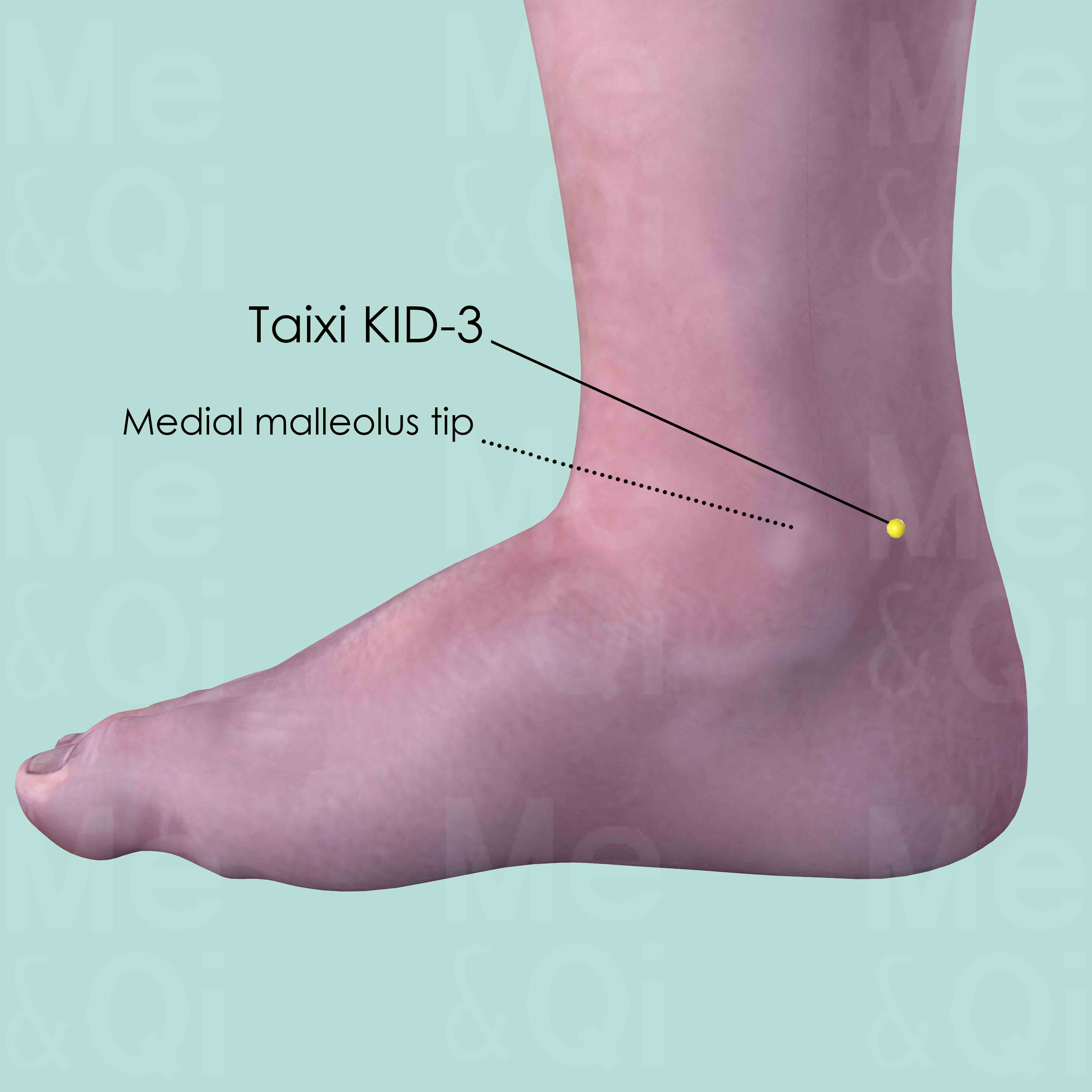
Taixi KID-3
In the depression between the medial malleolus tip and Achilles tendon (Calcaneal tendon), level with the tip of the medial malleolus.
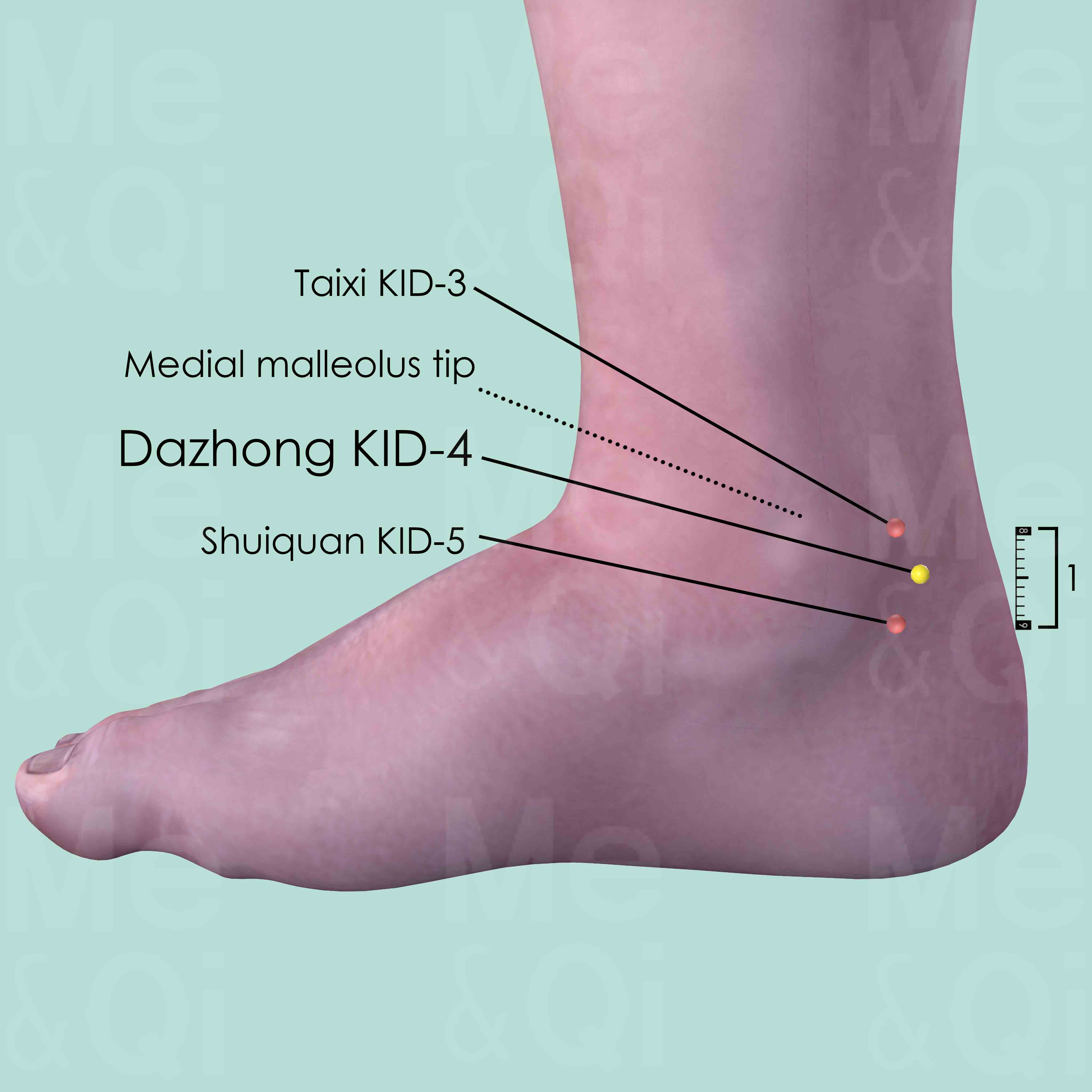
Dazhong KID-4
Posterior and inferior to the medial malleolus, in the depression medial to the Achilles tendon, superior to its insertion at the calcaneus.
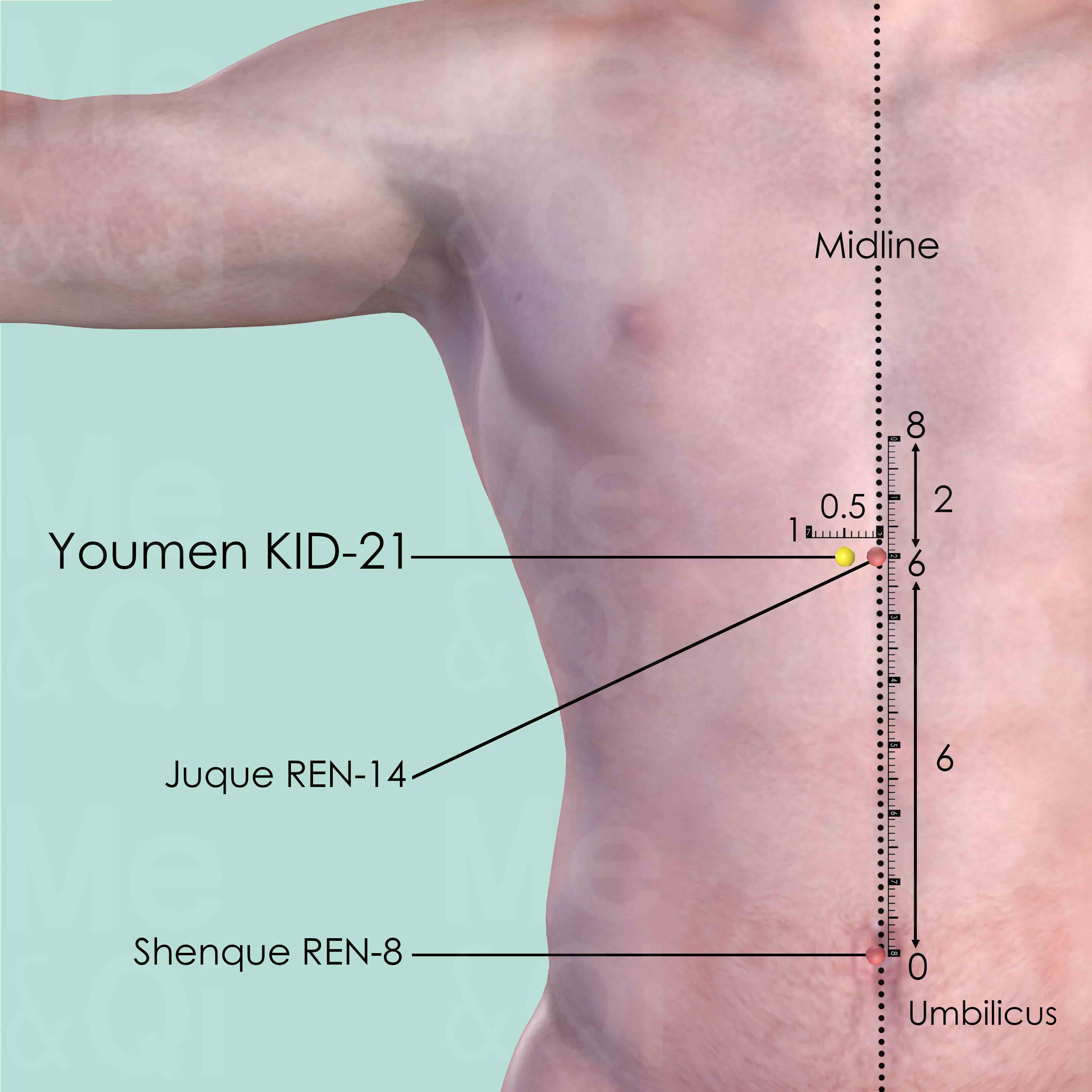
Youmen KID-21
6 cun above the umbilicus and 2 cun below the sternocostal angle, 0.5 cun lateral to the anterior midline.
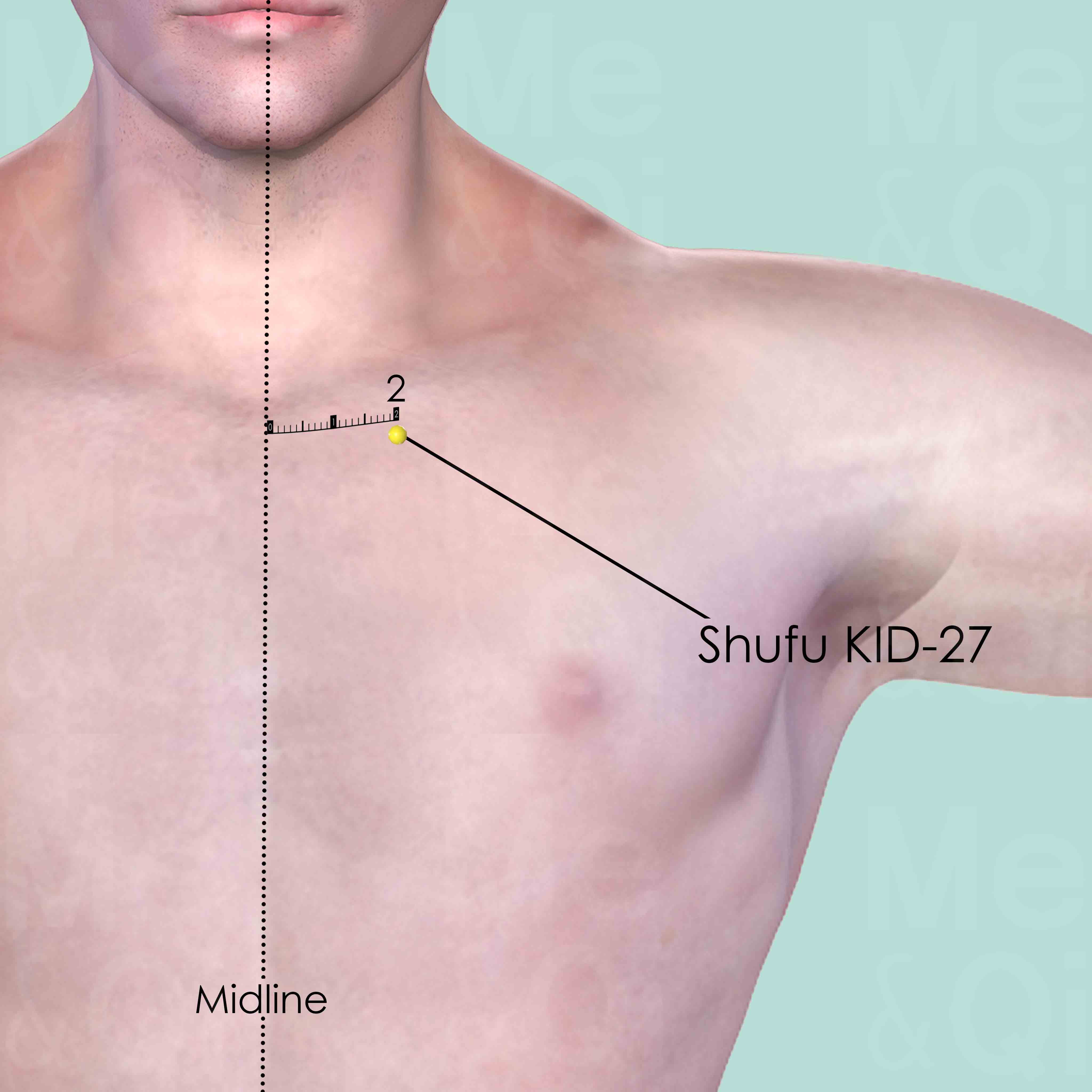
Shufu KID-27
In the depression on the lower border of the clavicle, 2 cun lateral to the anterior midline.
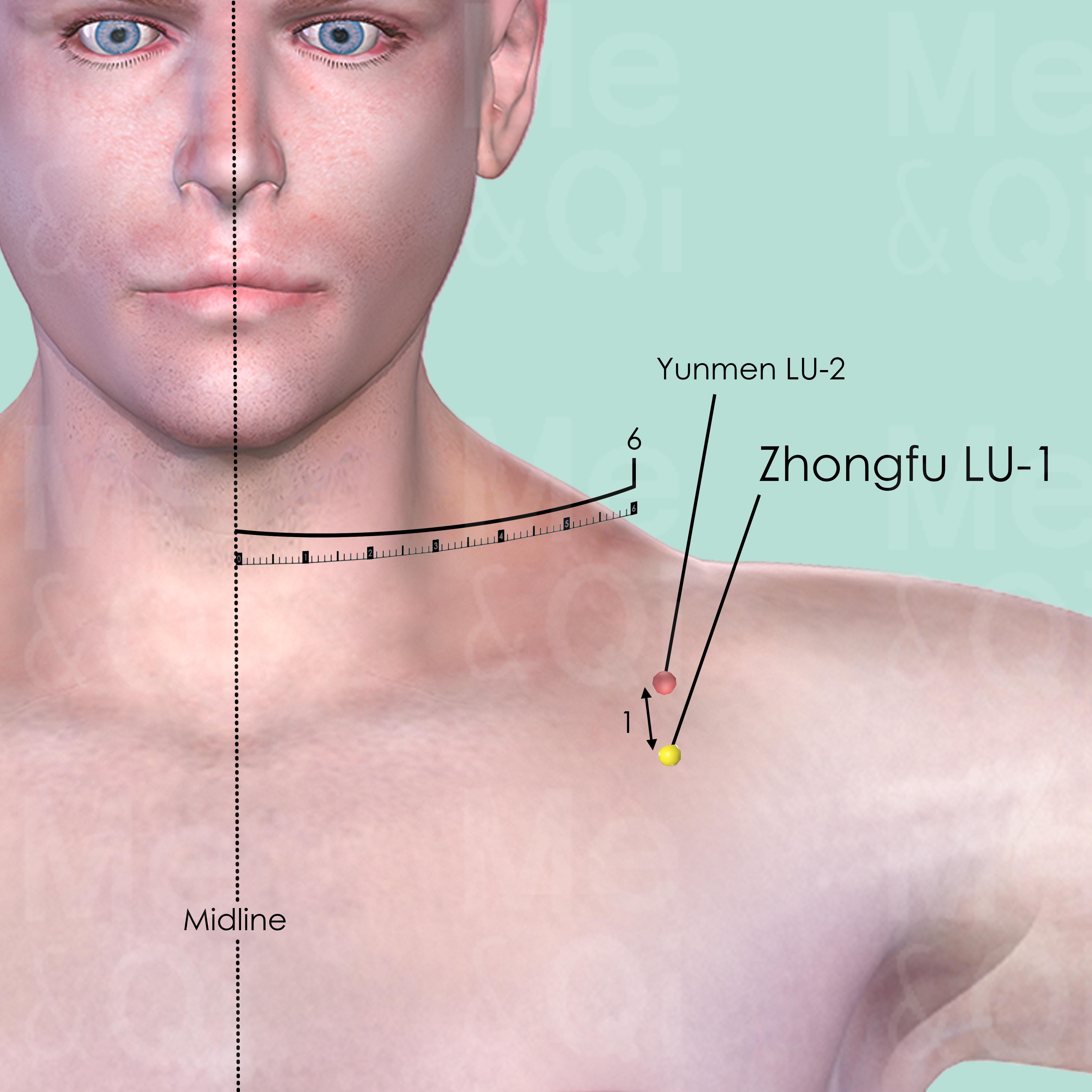
Zhongfu LU-1
On the lateral aspect of the chest, in the 1st intercostal space, 6 cun lateral to the midline, 1 cun inferior to Yunmen LU-2. Below the acromial extremity of the clavicle, slightly medial to the lower border of the coracoid process.
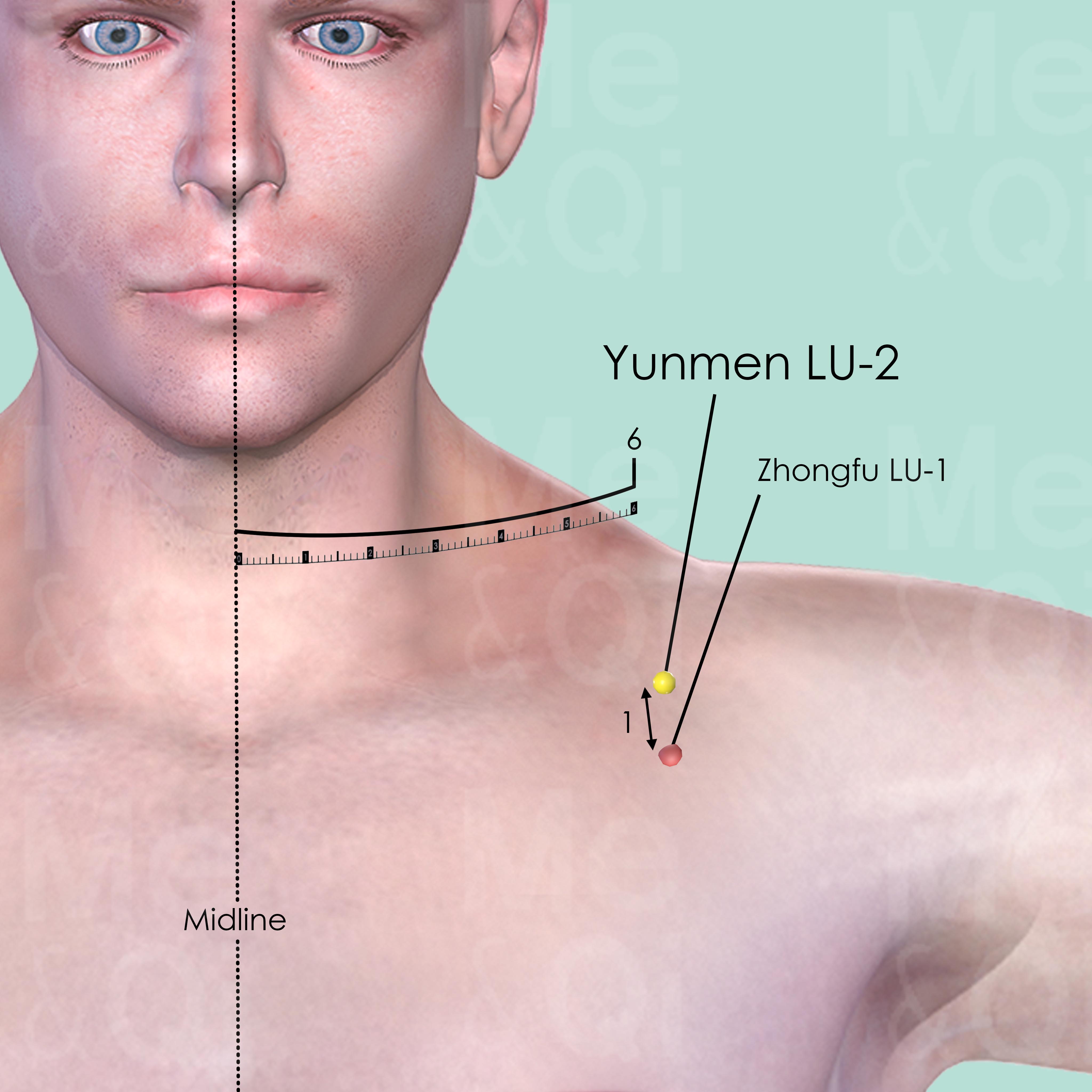
Yunmen LU-2
On the antero-lateral aspect of the chest, below the lateral extremity of the clavicle, about 6 cun lateral to the anterior midline in the centre of the deltopectoral triangle.
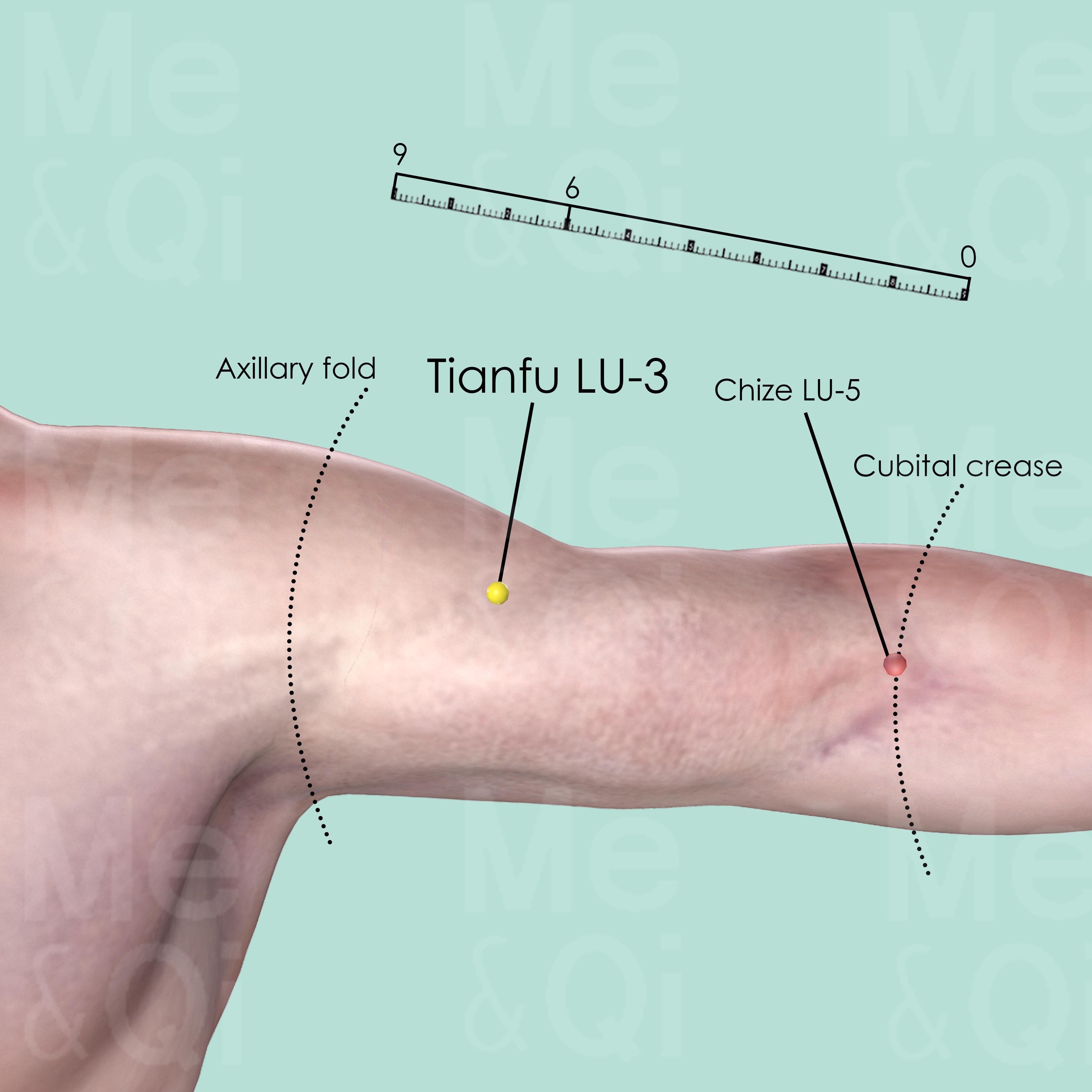
Tianfu LU-3
On the medial aspect of the upper arm, 3 cun below the end of the axillary fold and 6 cun above Chize LU-5, in the depression on the lateral border of biceps muscle.
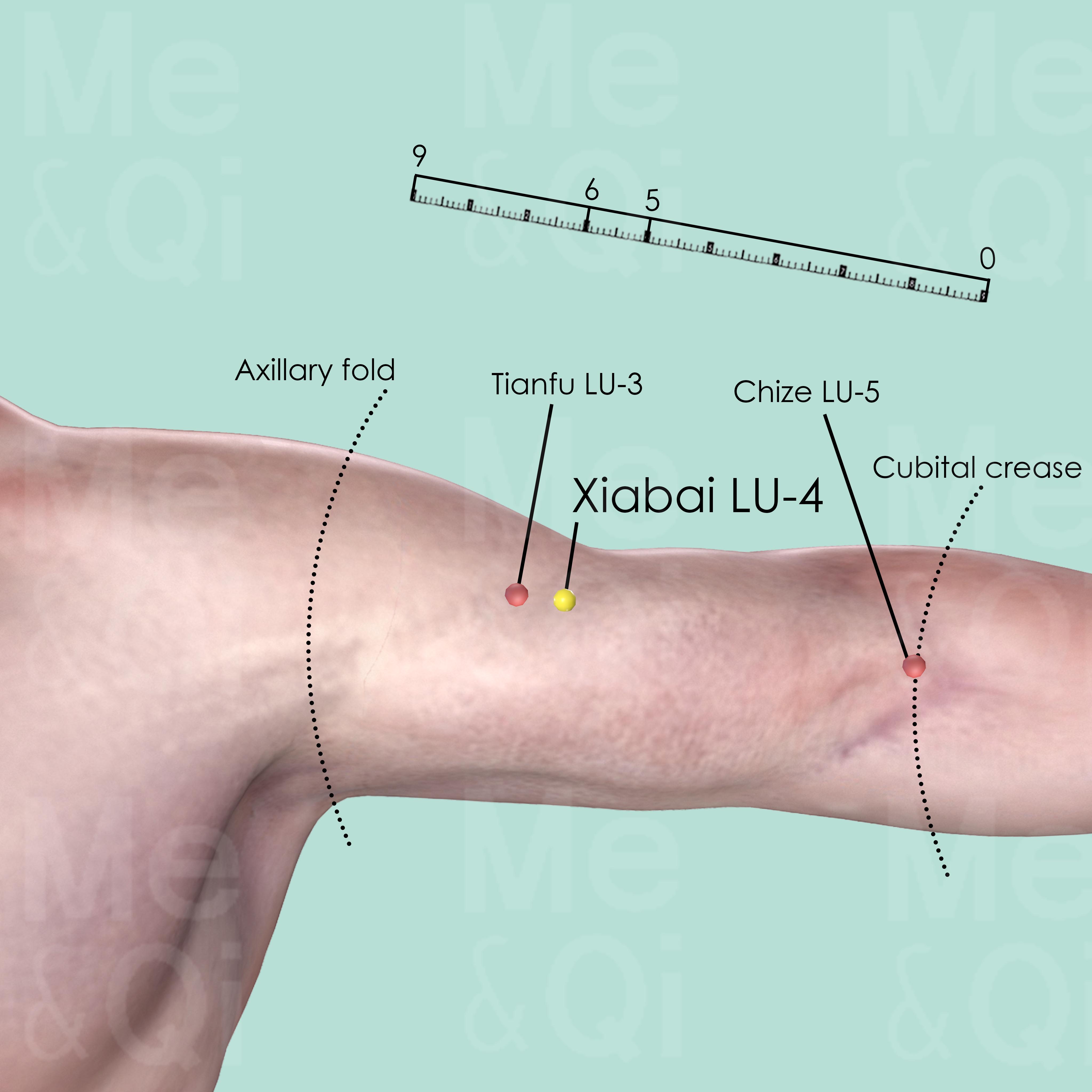
Xiabai LU-4
On the medial aspect of the upper arm, 1 cun below Tianfu LU-3, on the radial side of biceps brachii muscle.
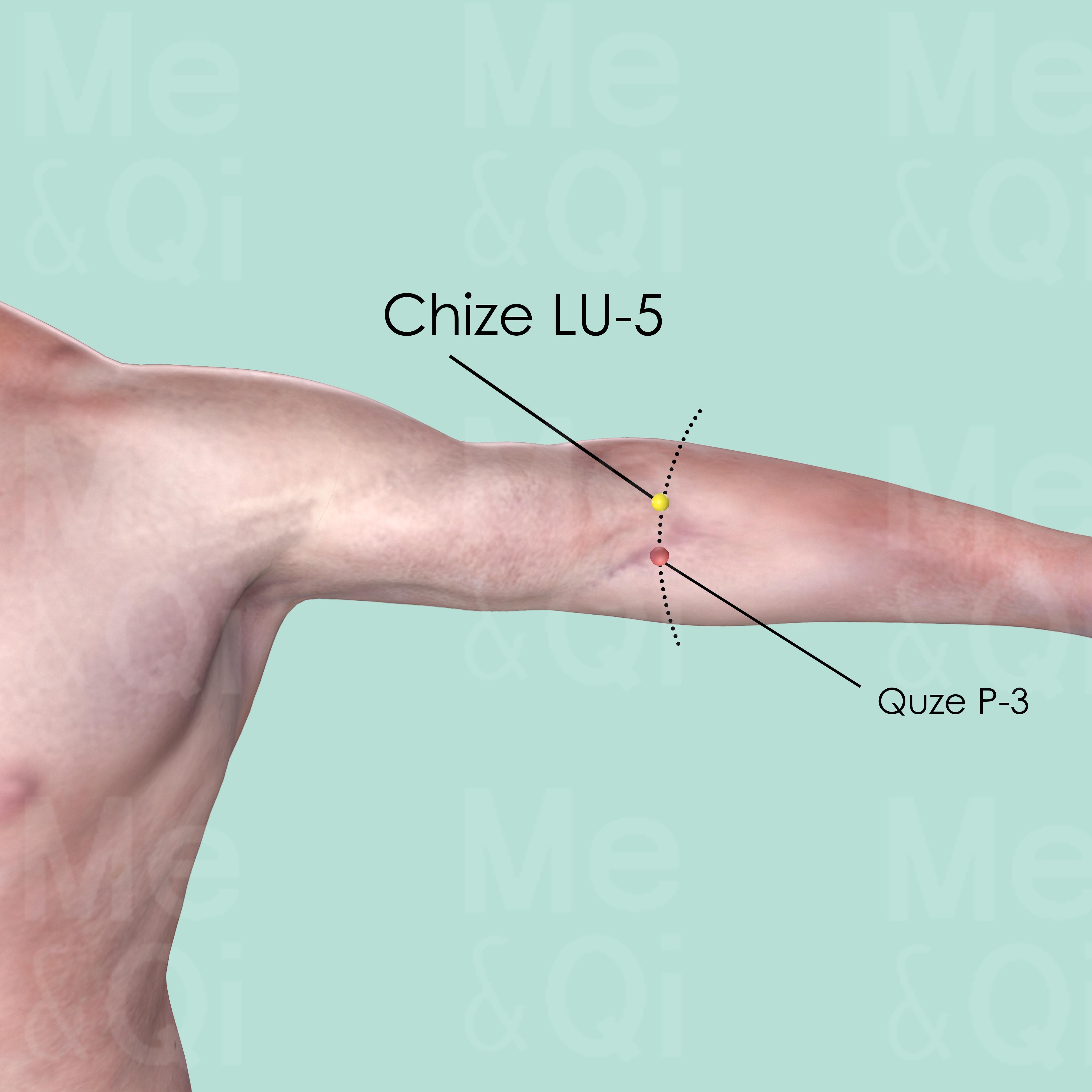
Chize LU-5
On the cubital crease, on the redial aspect of the biceps tendon. It can be easily identified when the elbow is slightly flexed.
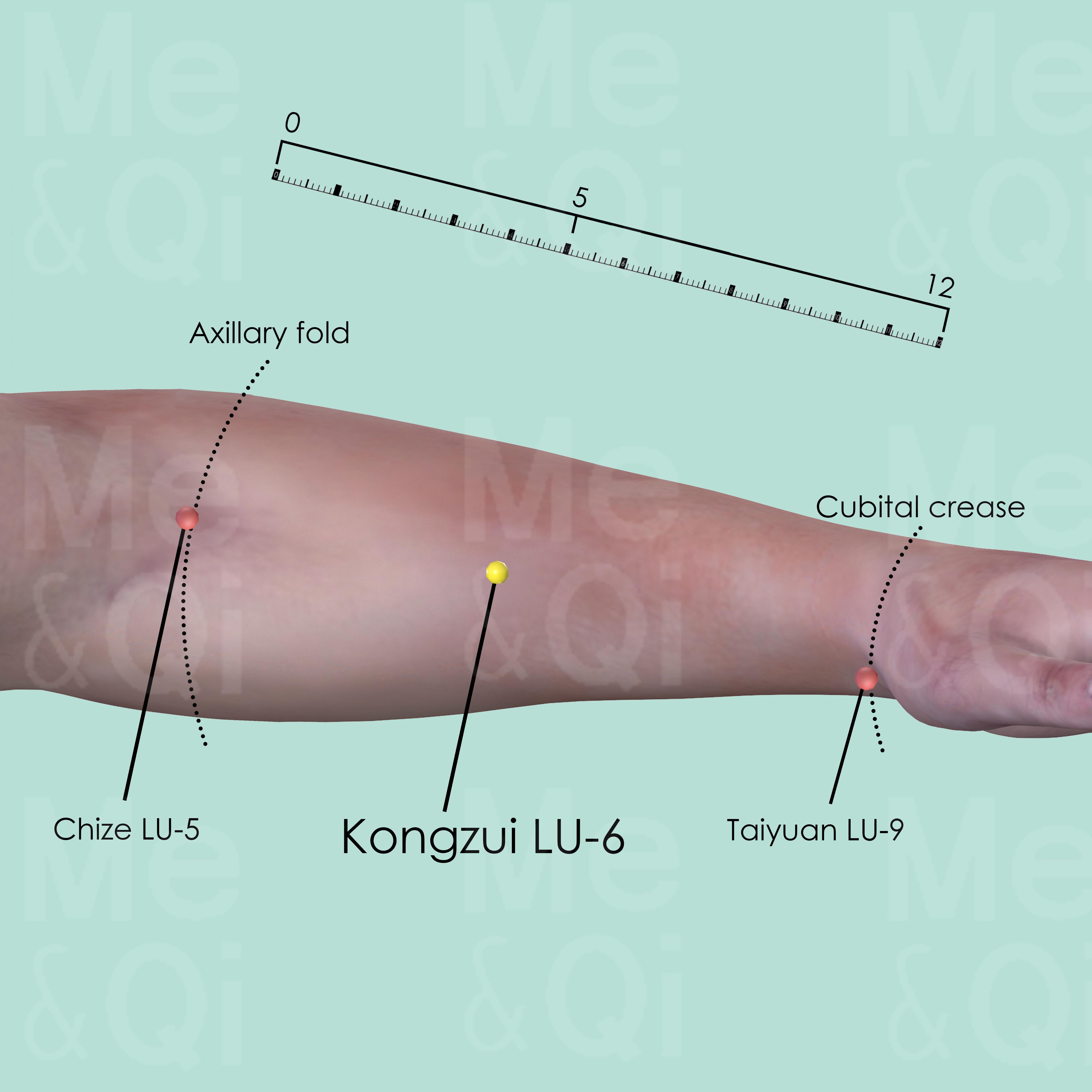
Kongzui LU-6
On the palmar aspect of the forearm, on the line joining Taiyuan LU-9 and Chize LU-5, 7 cun above Taiyuan LU-9.
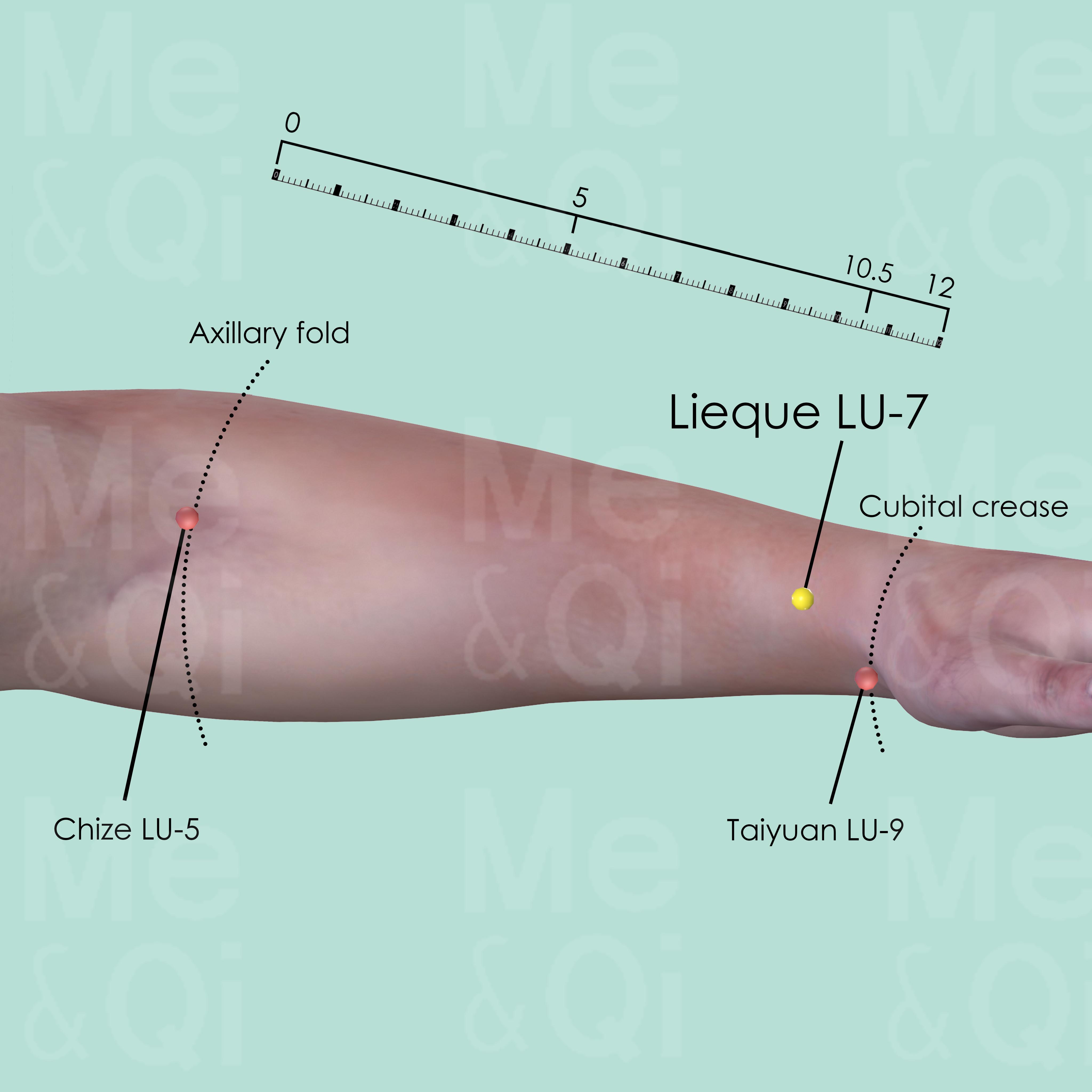
Lieque LU-7
Above the styloid process of the radius, about 1.5 cun proximal to the wrist crease (wrist joint space) in a V-shaped depression.
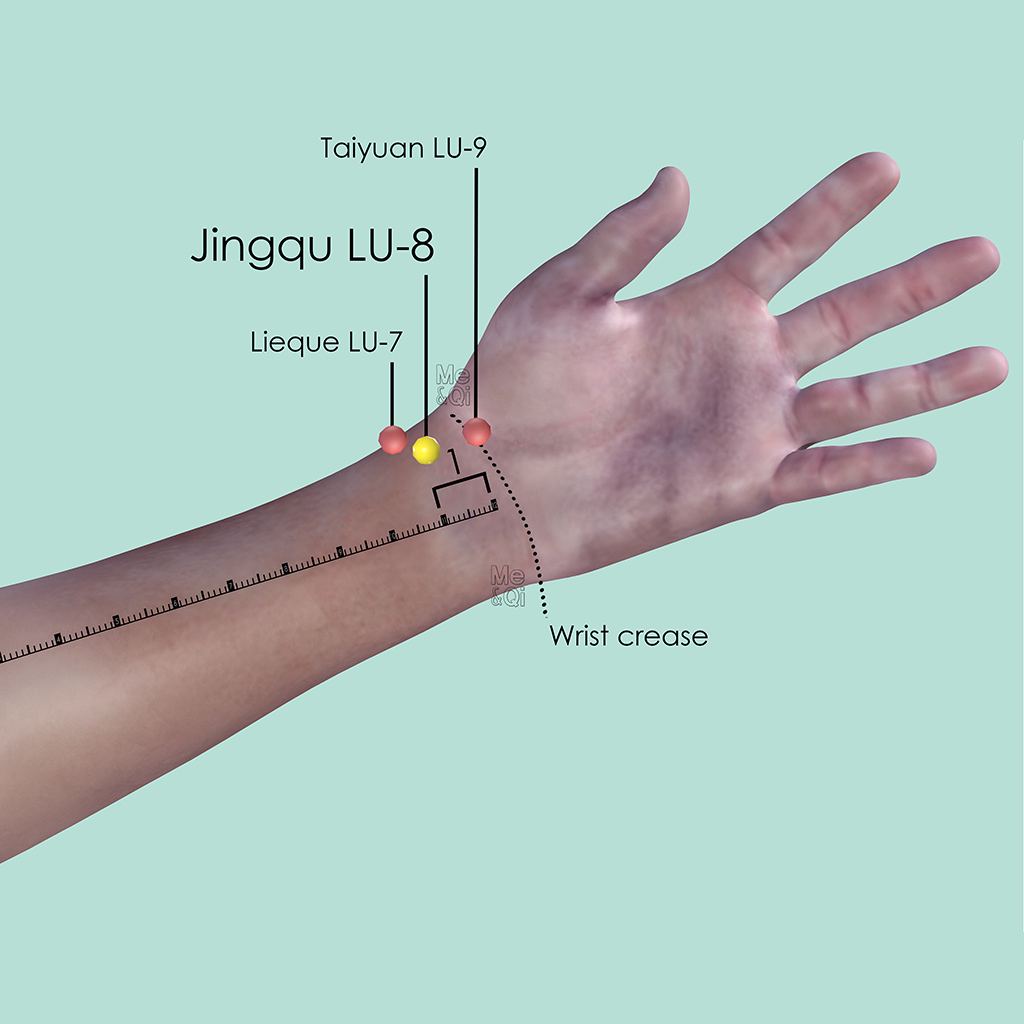
Jingqu LU-8
1 cun proximal to the wrist crease (wrist joint space), in the depression on the radial side of the radial artery.
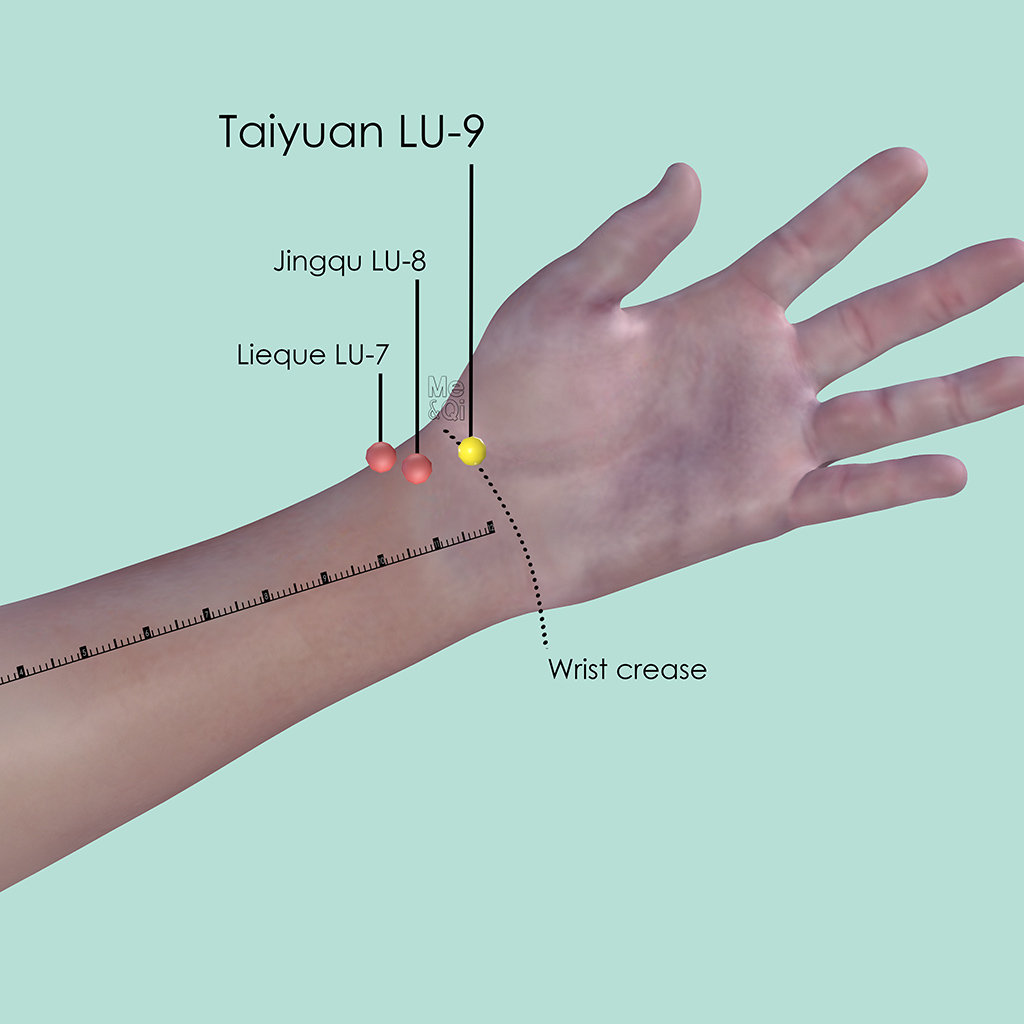
Taiyuan LU-9
At the wrist crease (wrist joint space), in the depression on the radial aspect of the radial artery and ulnar to the tendon of the abductor pollicis longus muscle.
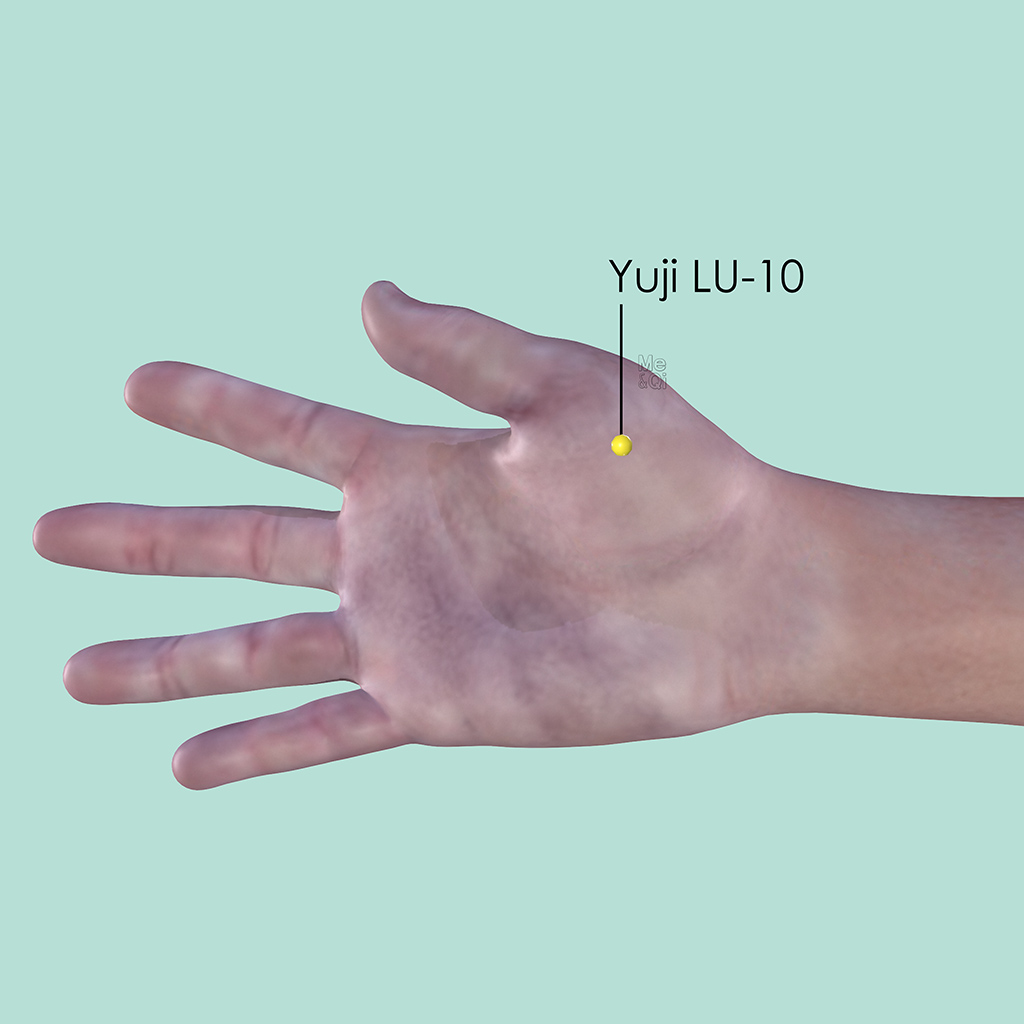
Yuji LU-10
On the radial aspect of the midpoint of the first metacarpal bone, on the junction of the red and white skin (the junction of the dorsum and palm of the hand).
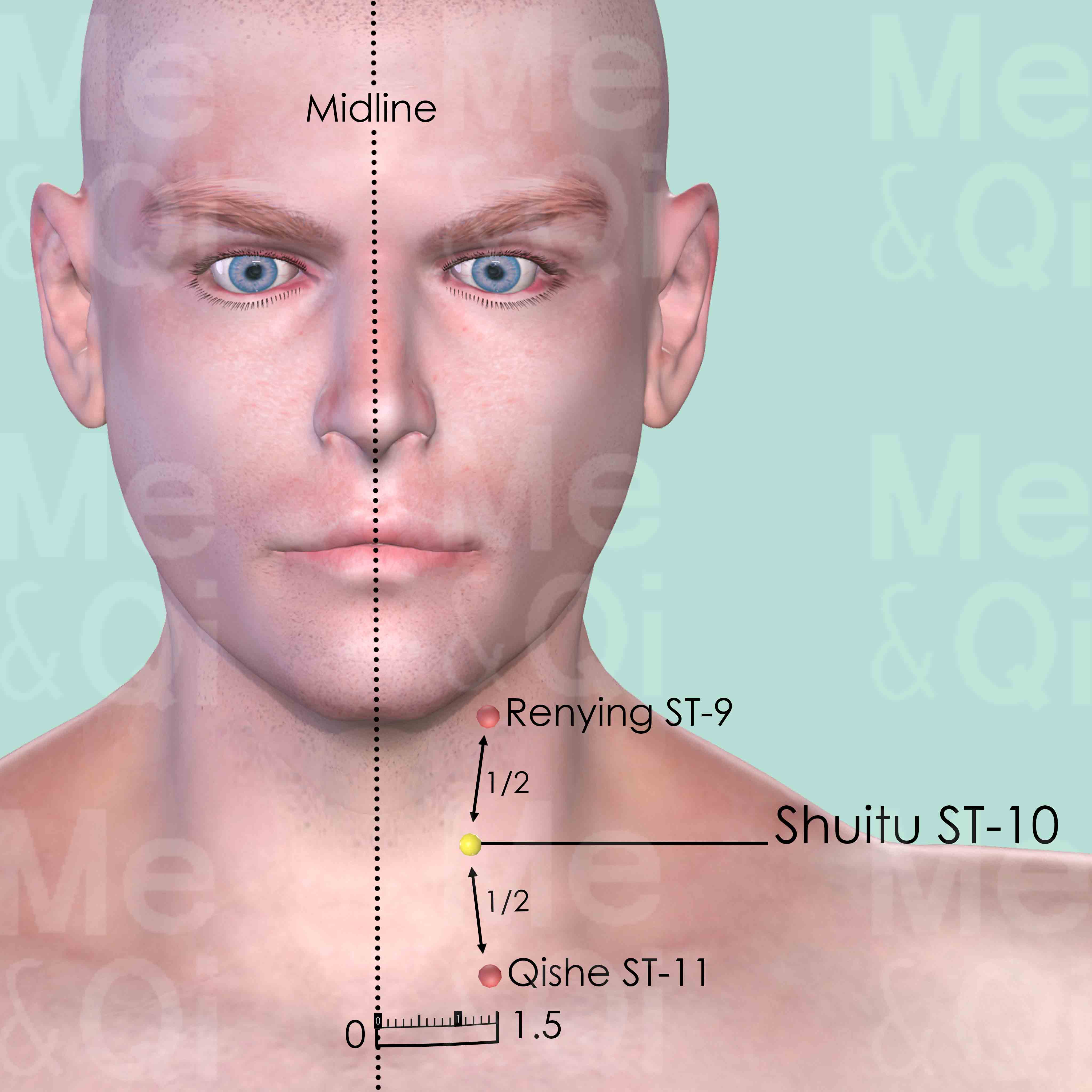
Shuitu ST-10
On the anterior border of sternocleidomastoid muscle, in the middle between Renying ST-9 and Qishe ST-11.
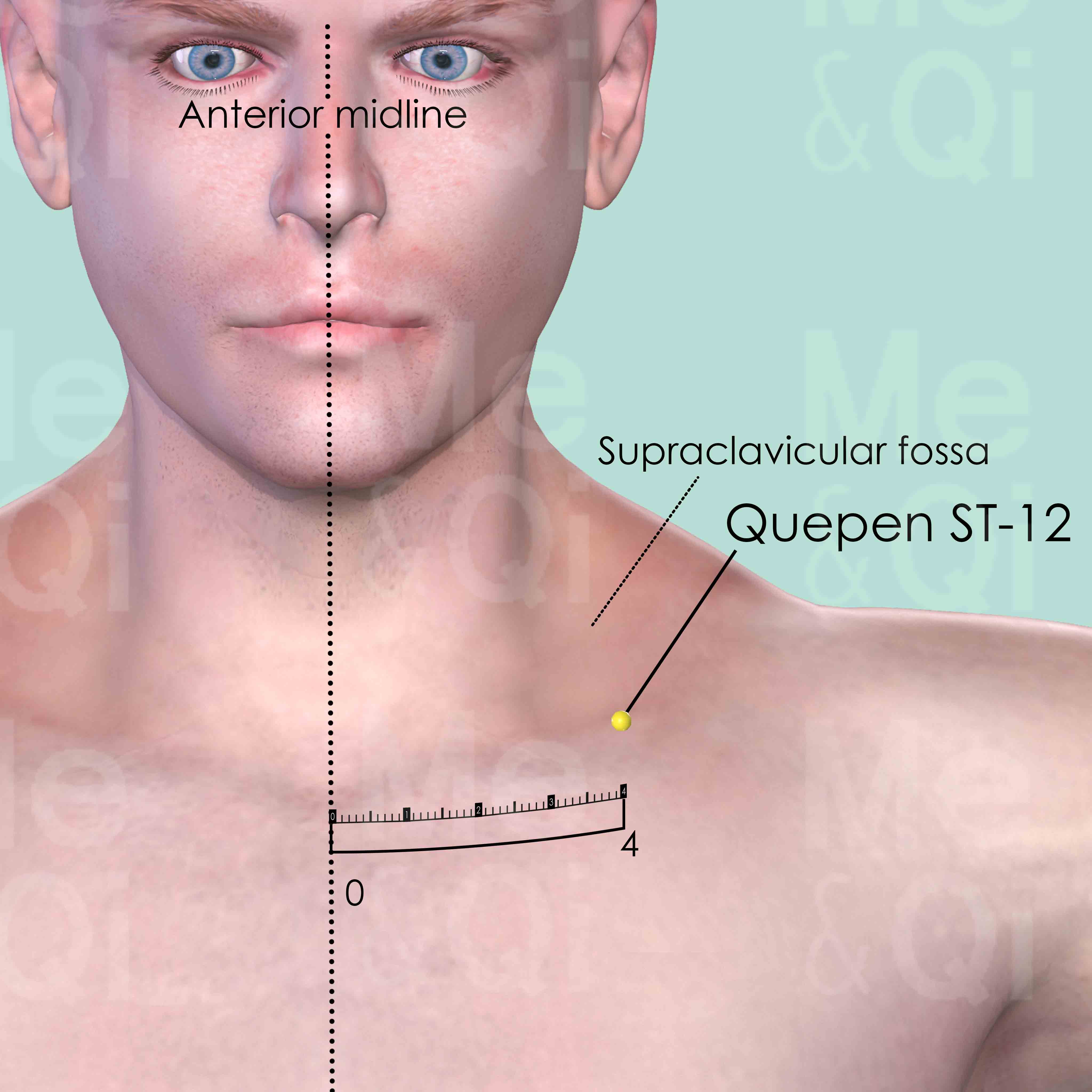
Quepen ST-12
About 4 cun lateral to the anterior midline, in the supraclavicular fossa, superior to the midpoint of the clavicle.
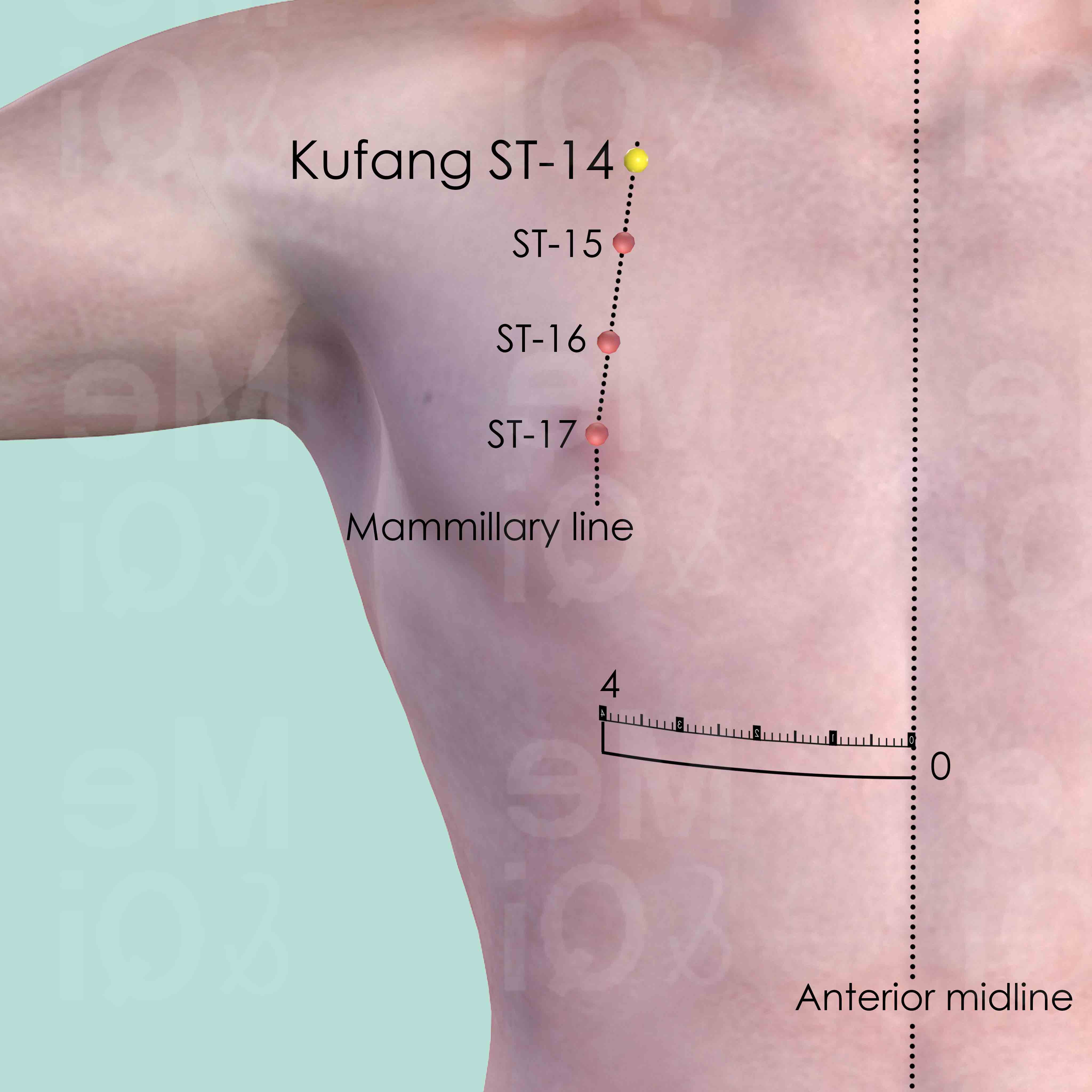
Kufang ST-14
In the 1st intercostal space, on the mammillary line, 4 cun lateral to the anterior midline.
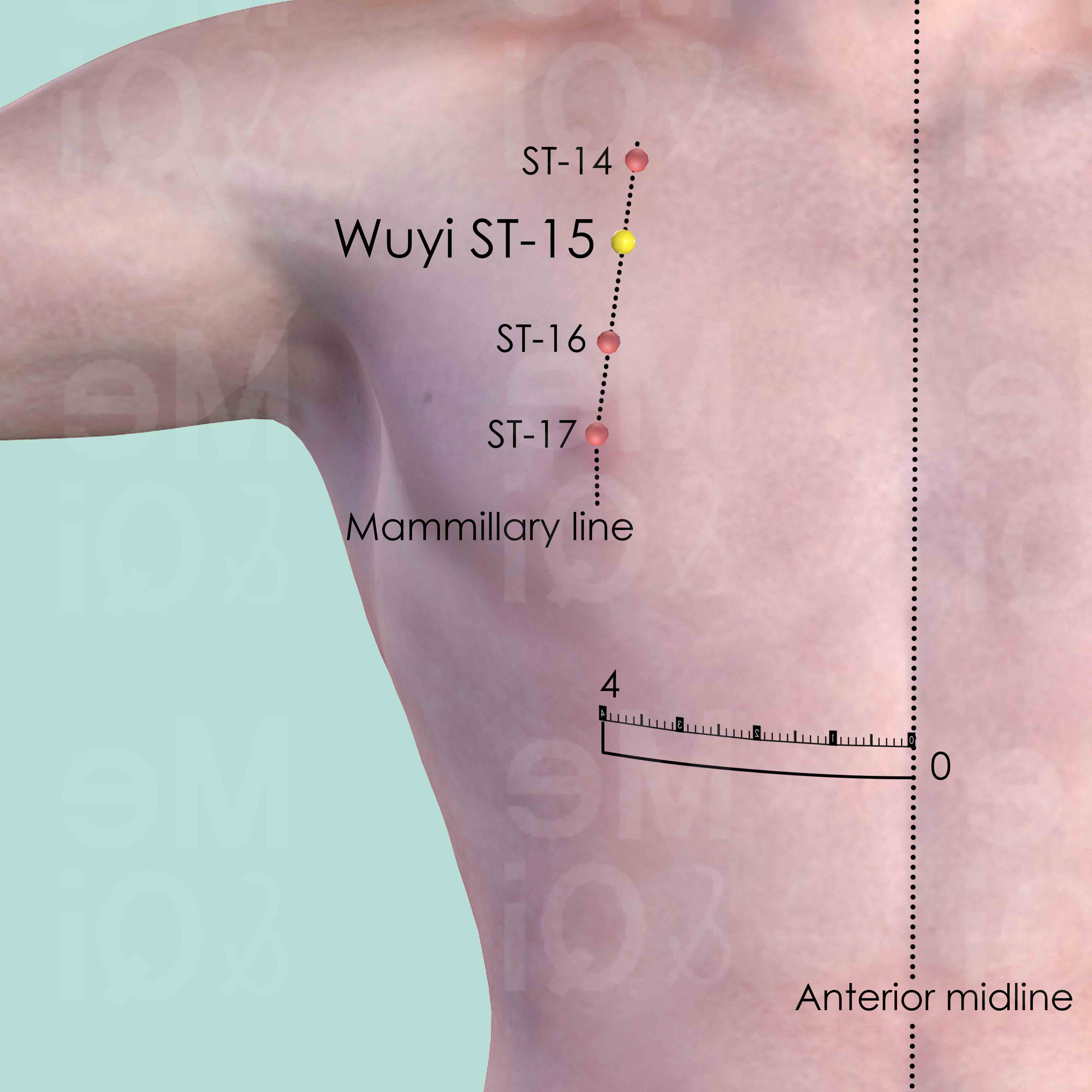
Wuyi ST-15
In the 2nd intercostal space, on the mammillary line, 4 cun lateral to the anterior midline.
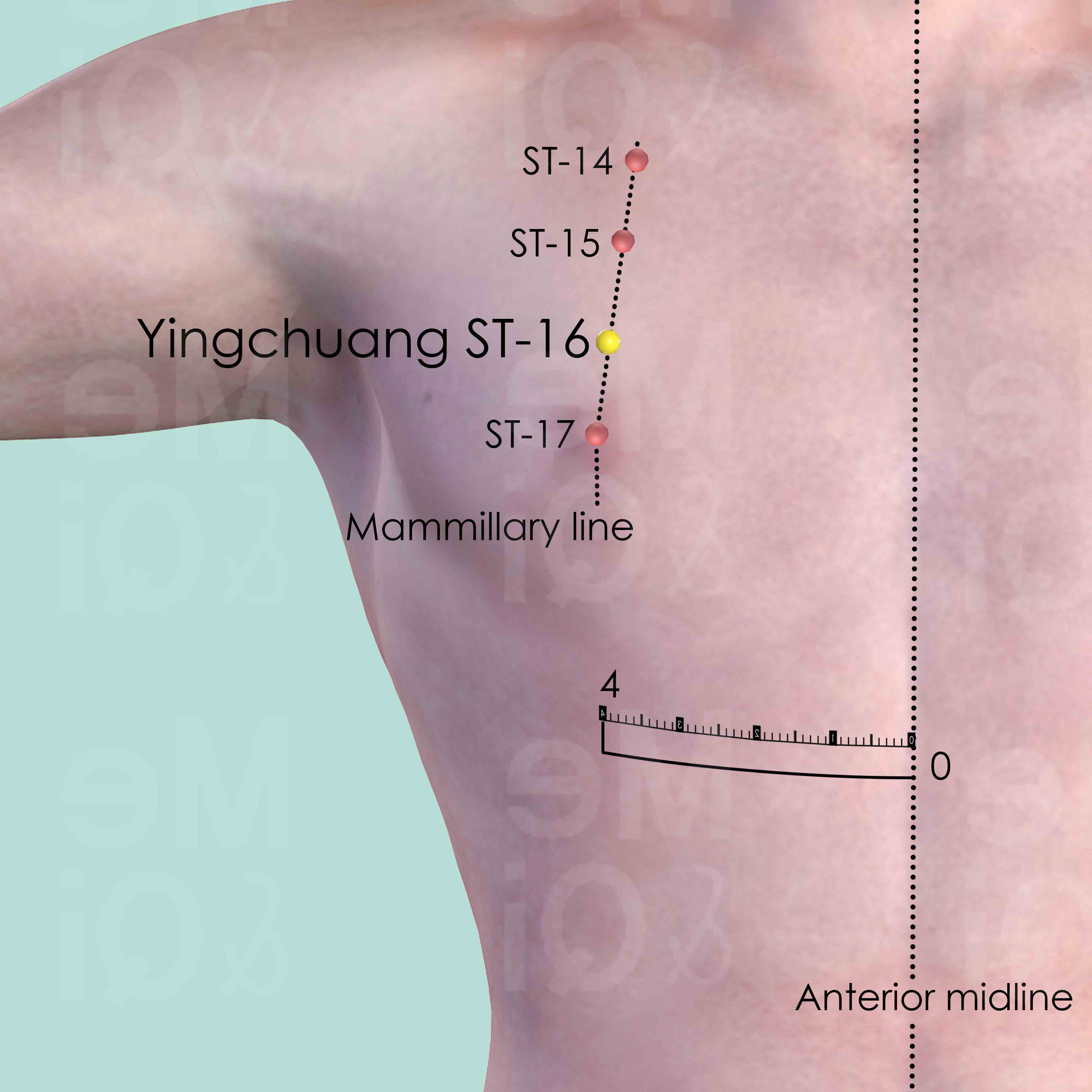
Yingchuang ST-16
In the 3nd intercostal space, on the mammillary line, 4 cun lateral to the anterior midline.
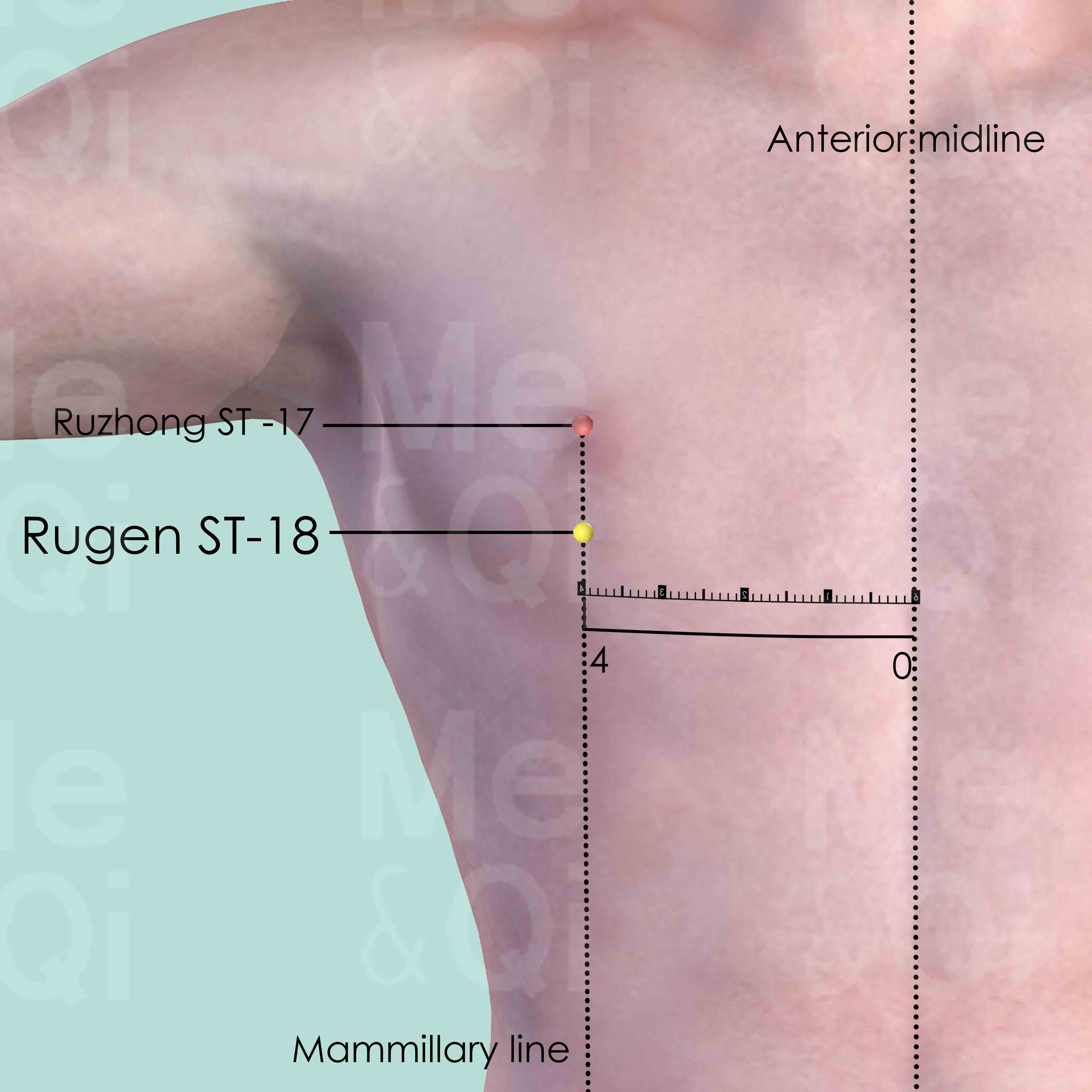
Rugen ST-18
In the 5nd intercostal space, on the mammillary line, 4 cun lateral to the anterior midline.
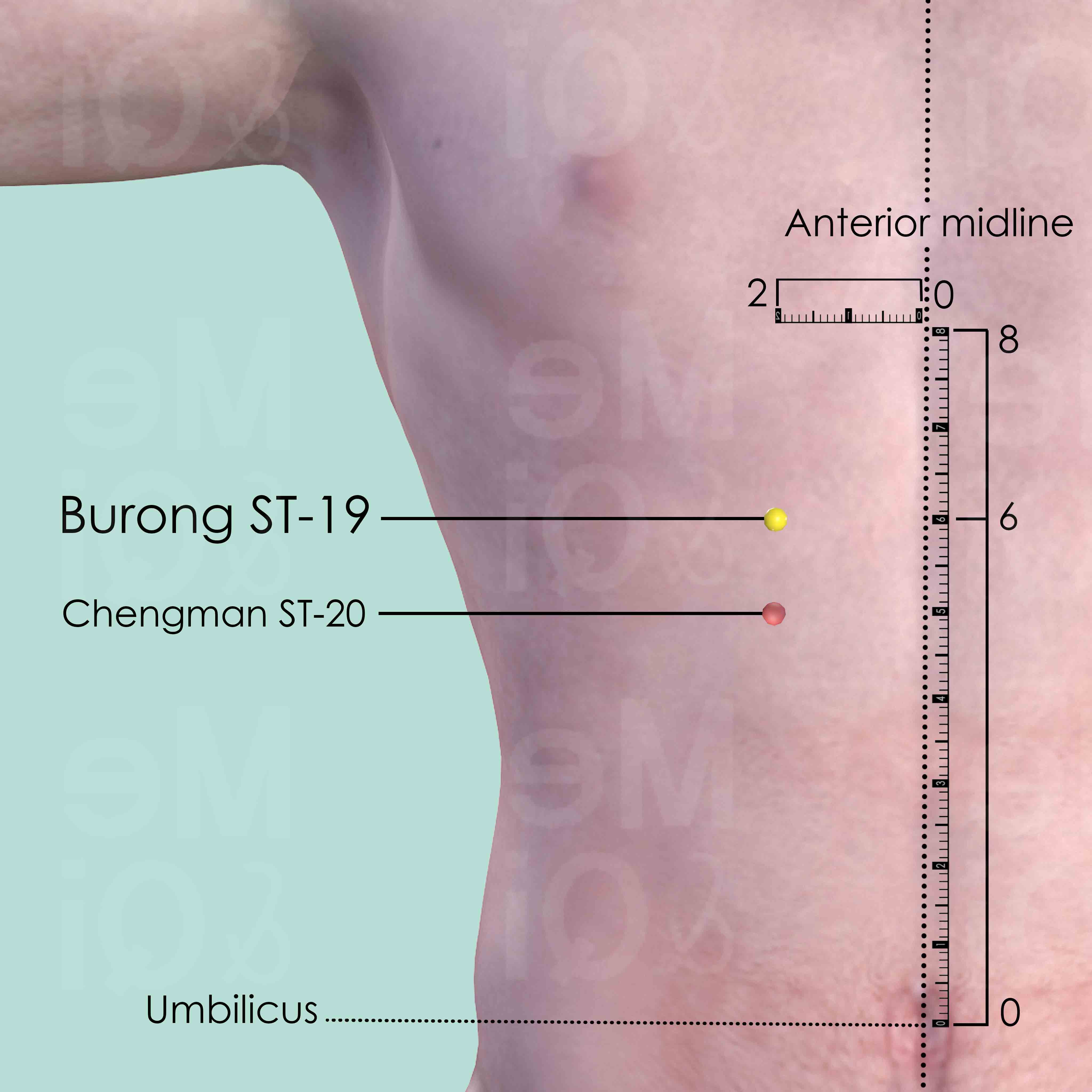
Burong ST-19
2 cun below the sternocostal angel and 6 cun above the umbilicus, 2 cun lateral to the anterior midline.
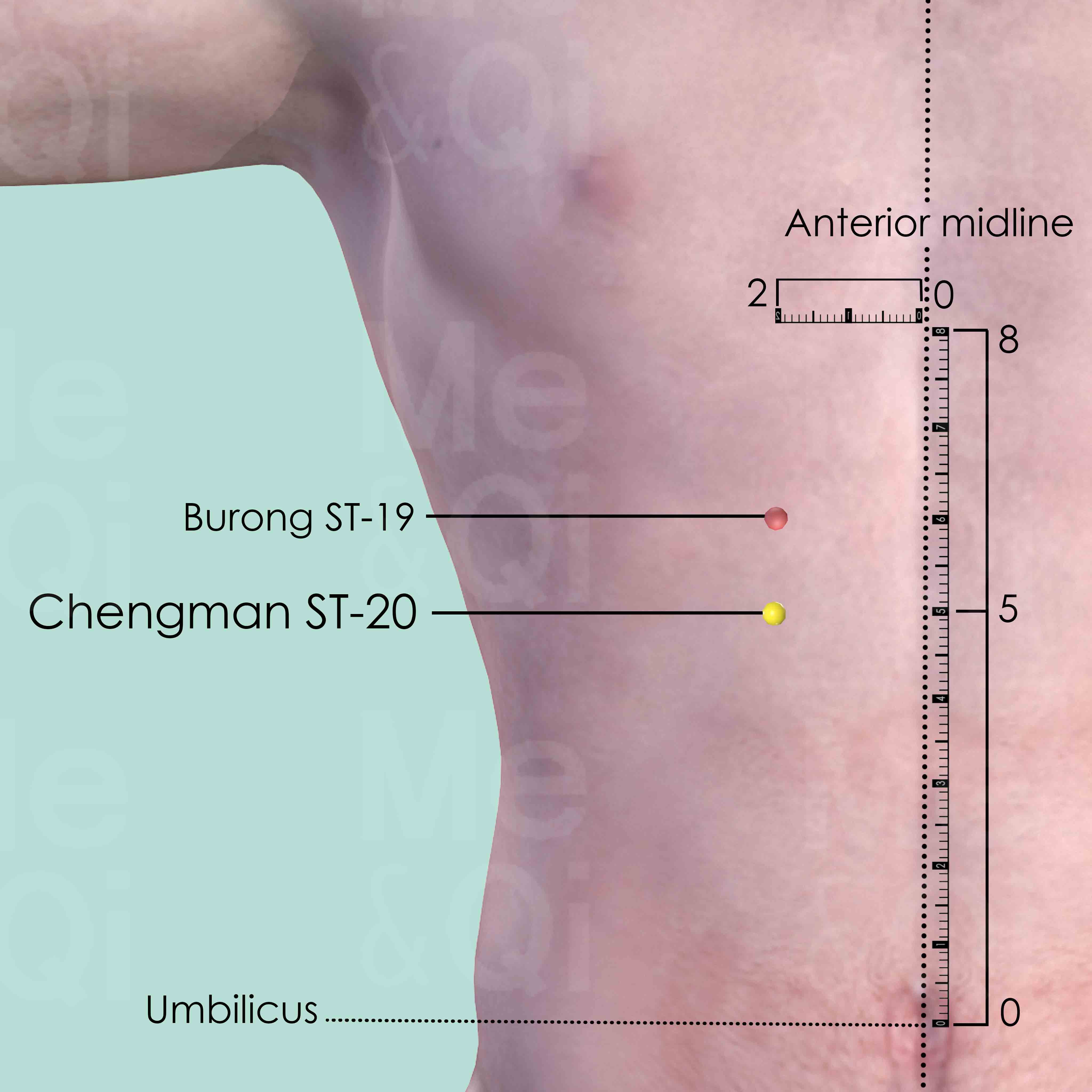
Chengman ST-20
5 cun above the umbilicus and 2 cun lateral to the anterior midline, or 1 cun below Burong ST-19.
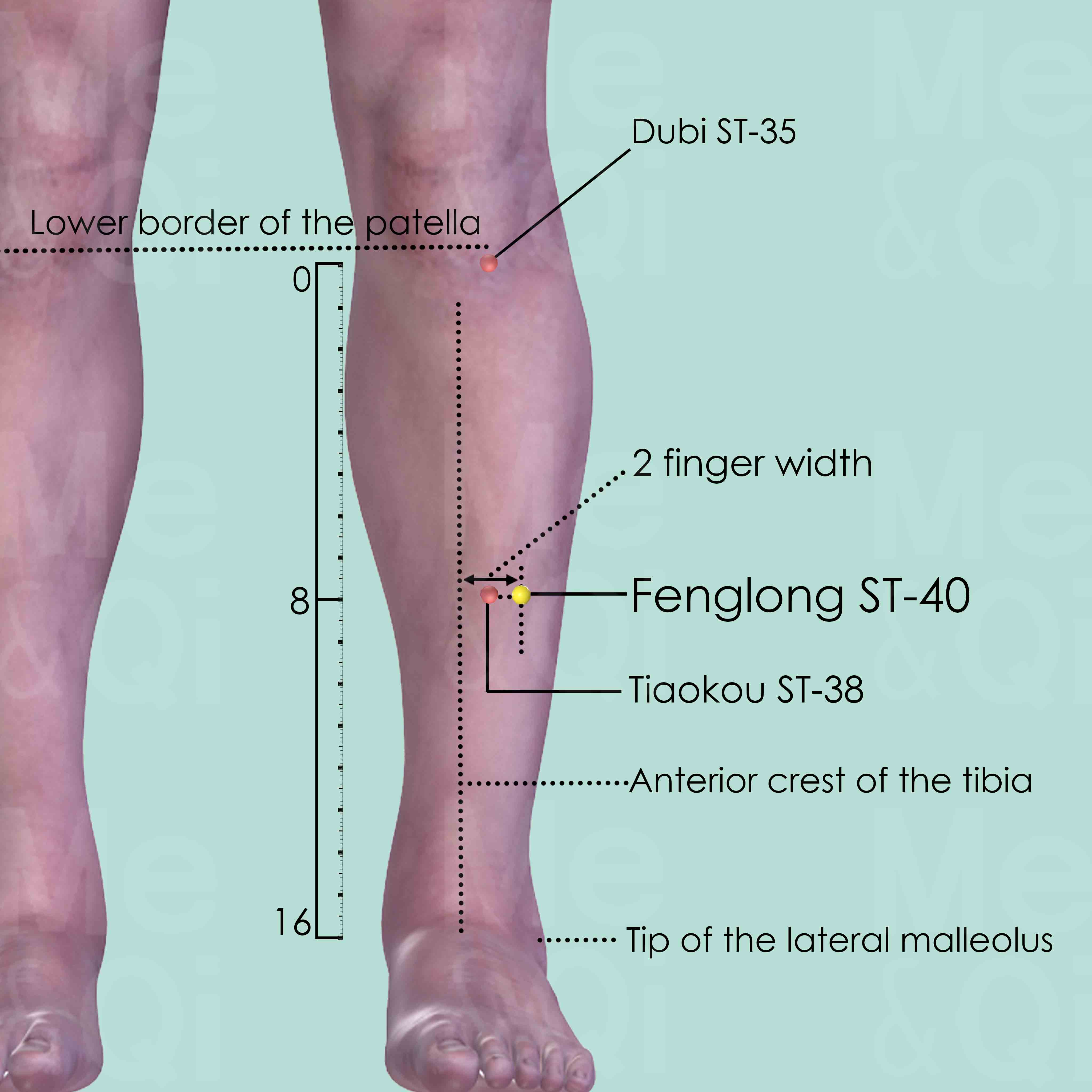
Fenglong ST-40
Midway between Dubi ST-35 and Jiexi ST-41, two middle finger-width from the anterior crest of the tibia, or one middle finger-width from Tiaokou ST-38.
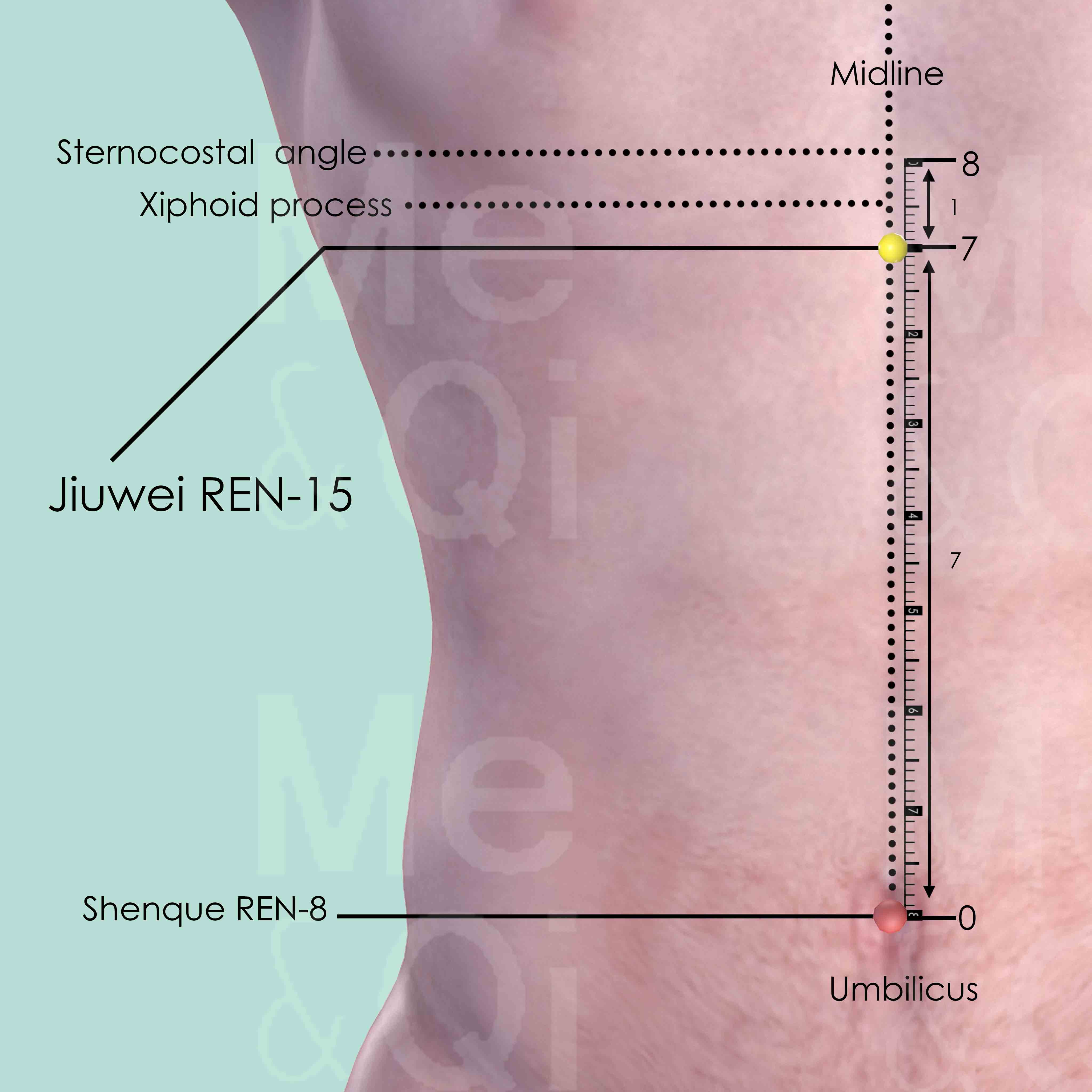
Jiuwei REN-15
On the midline of the abdomen, 7 cun above the umbilicus and 1 cun below the sternocostal angle. This point is located at the tip of the xiphoid process, which is commonly known as ‘dove-tail’ in China, hence the name of the point.
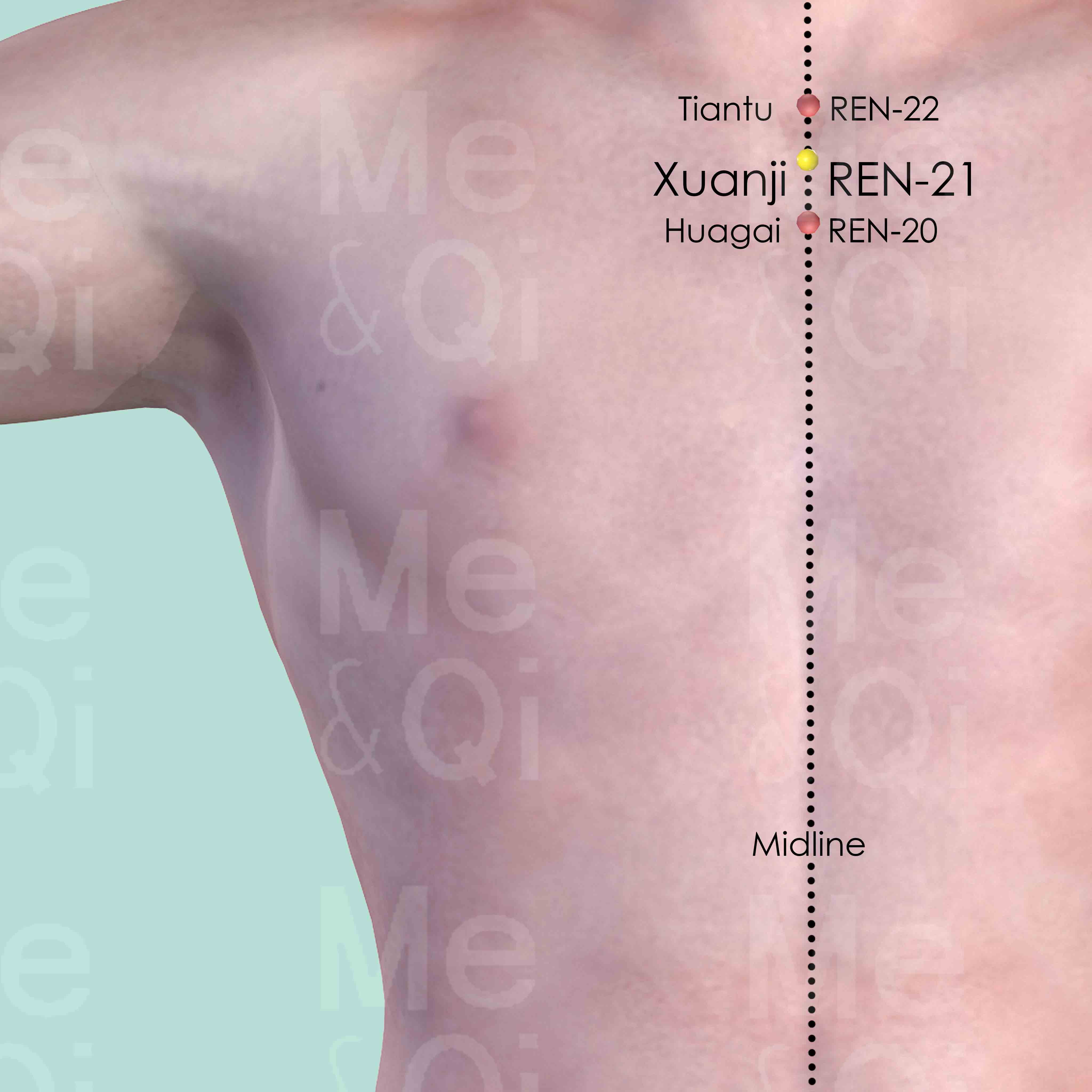
Xuanji REN-21
On the midline of the sternum, below the upper border of the manubrium sterni and midway between Huagai REN-20 and Tiantu REN-22.
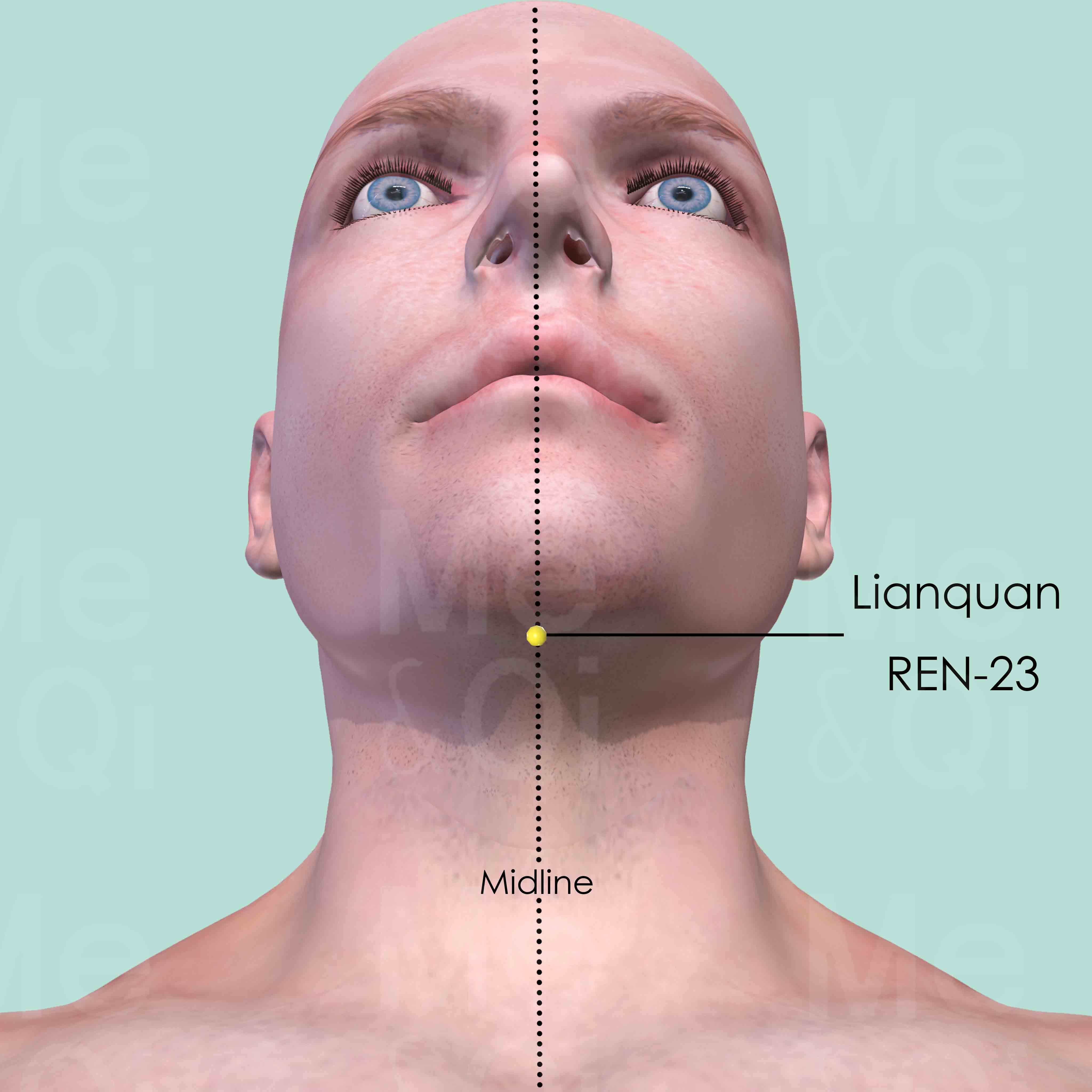
Lianquan REN-23
On the anterior midline of the neck, above the Adm's apple, in the depression at the upper border of the hyoid bone.
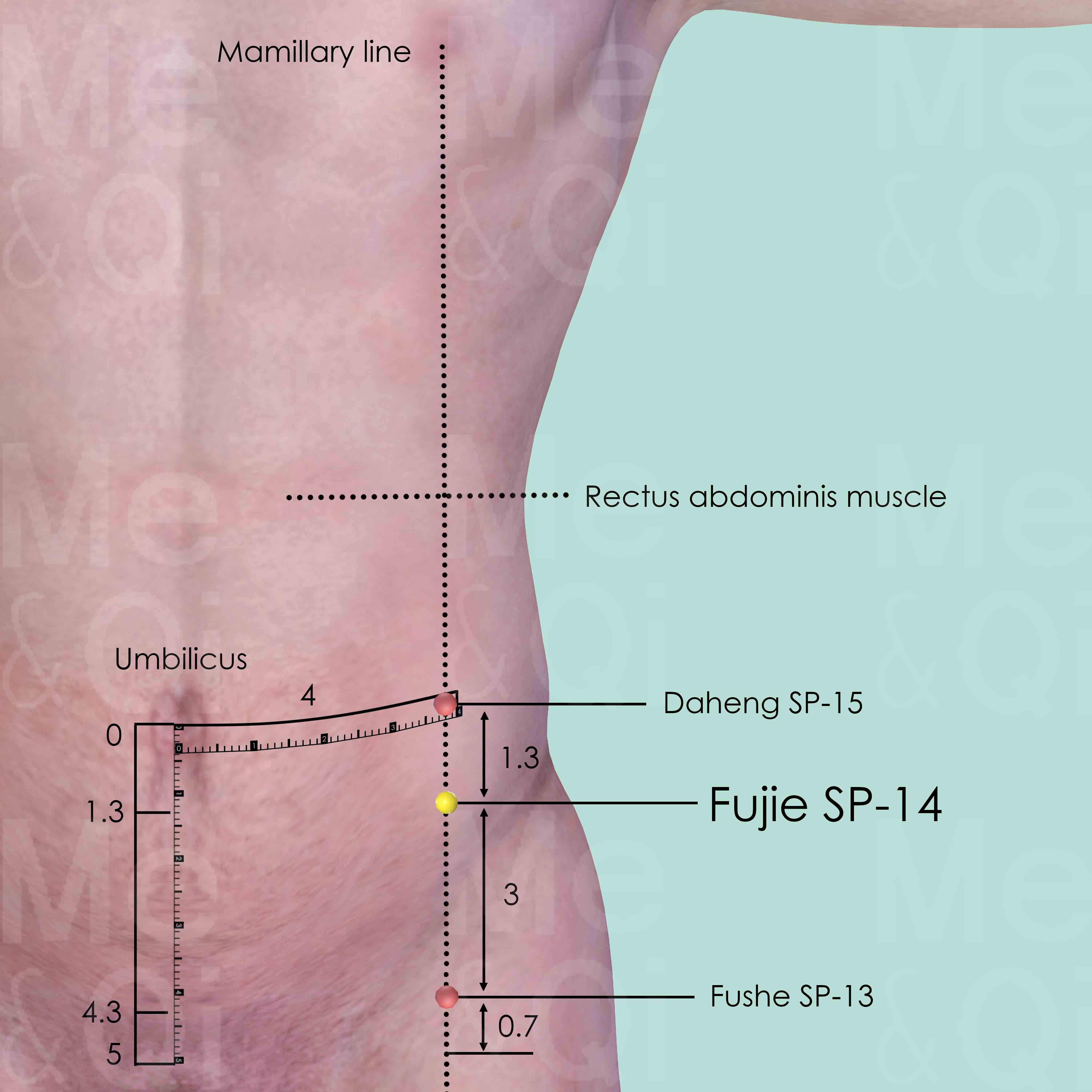
Fujie SP-14
On the mamillary line which is 4 cun lateral to the anterior midline. 3 cun above Fushe SP-13, 1.3 cun below Daheng SP-15, on the lateral side of rectus abdominis muscle.
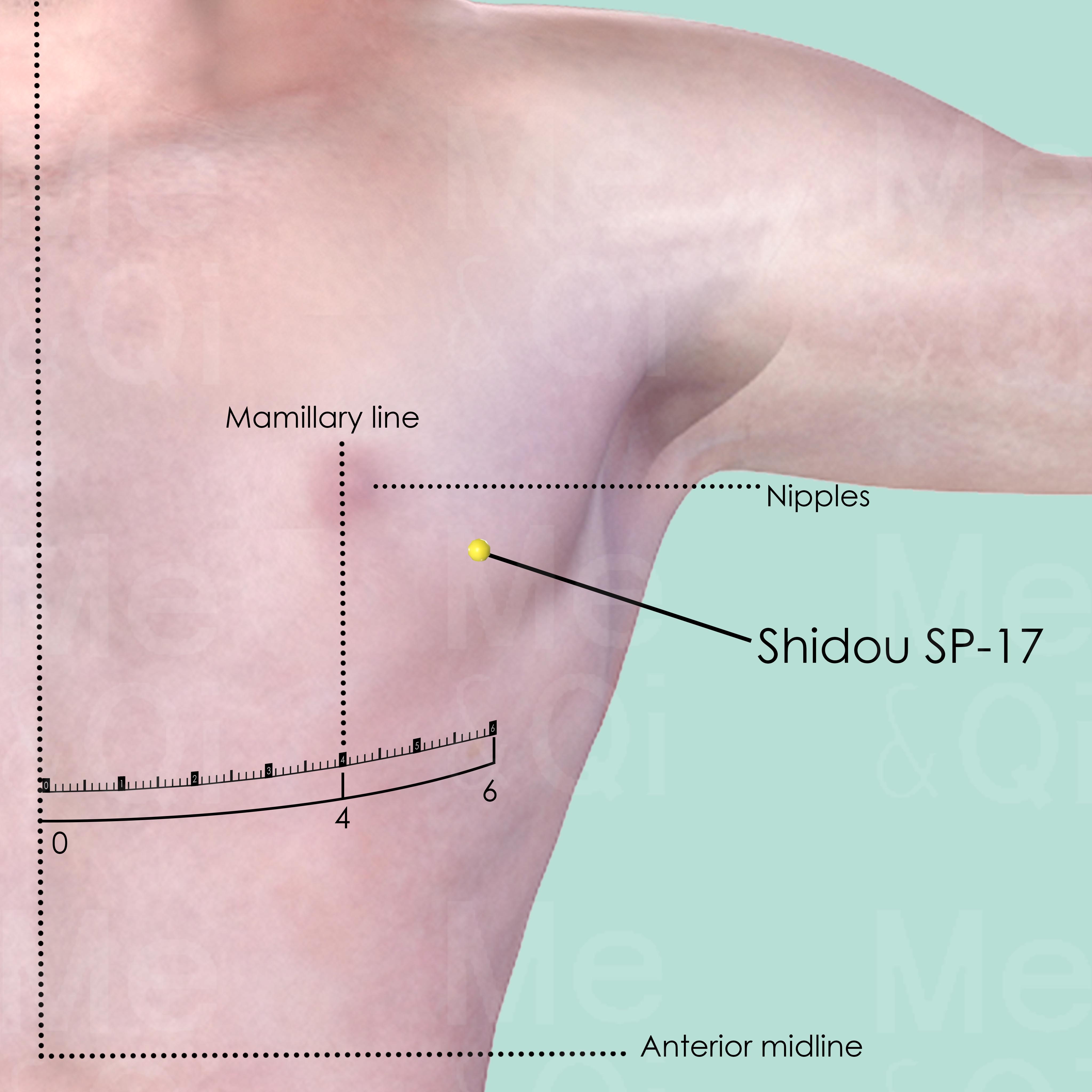
Shidou SP-17
6 cun lateral to the anterior midline, 2 cun lateral to the mamillary line, in the 5th intercostal space.
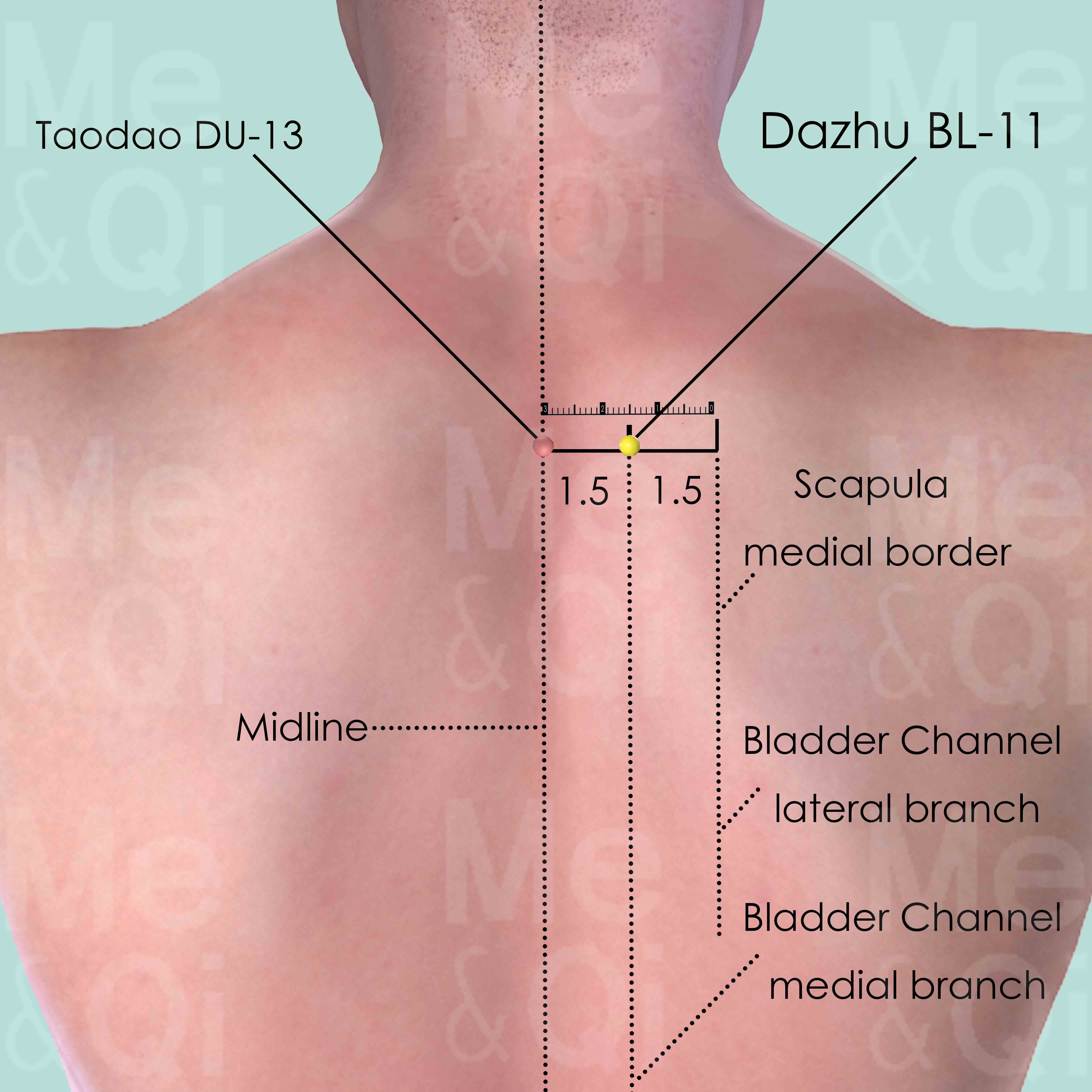
Dazhu BL-11
On the level of the lower border of the spinous process of the 1st thoracic vertebra (T1), 1.5 cun (about 2 finger-breadths) lateral to the posterior midline.
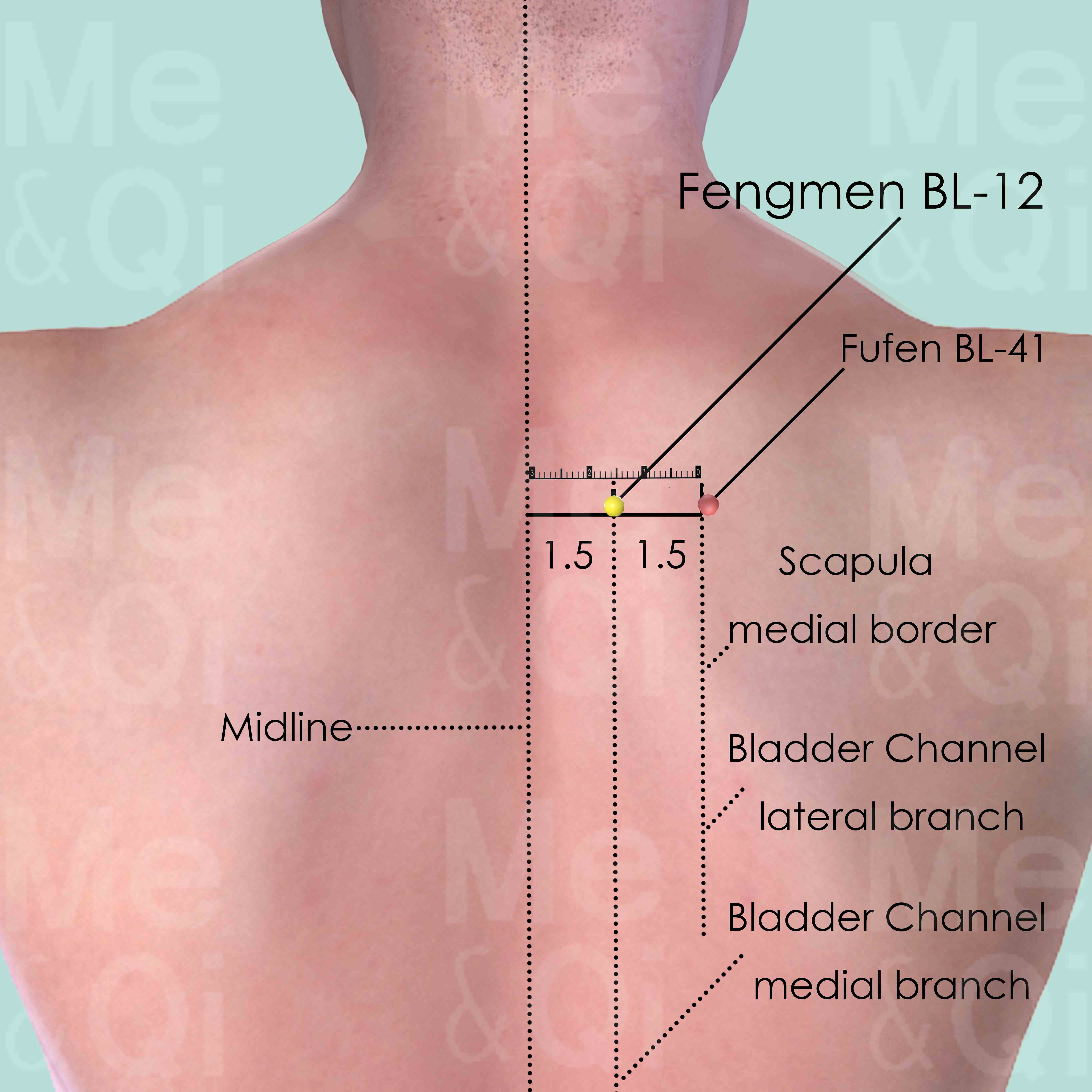
Fengmen BL-12
1.5 cun lateral to the lower border of the spinous process of the 2nd thoracic vertebra (T2).
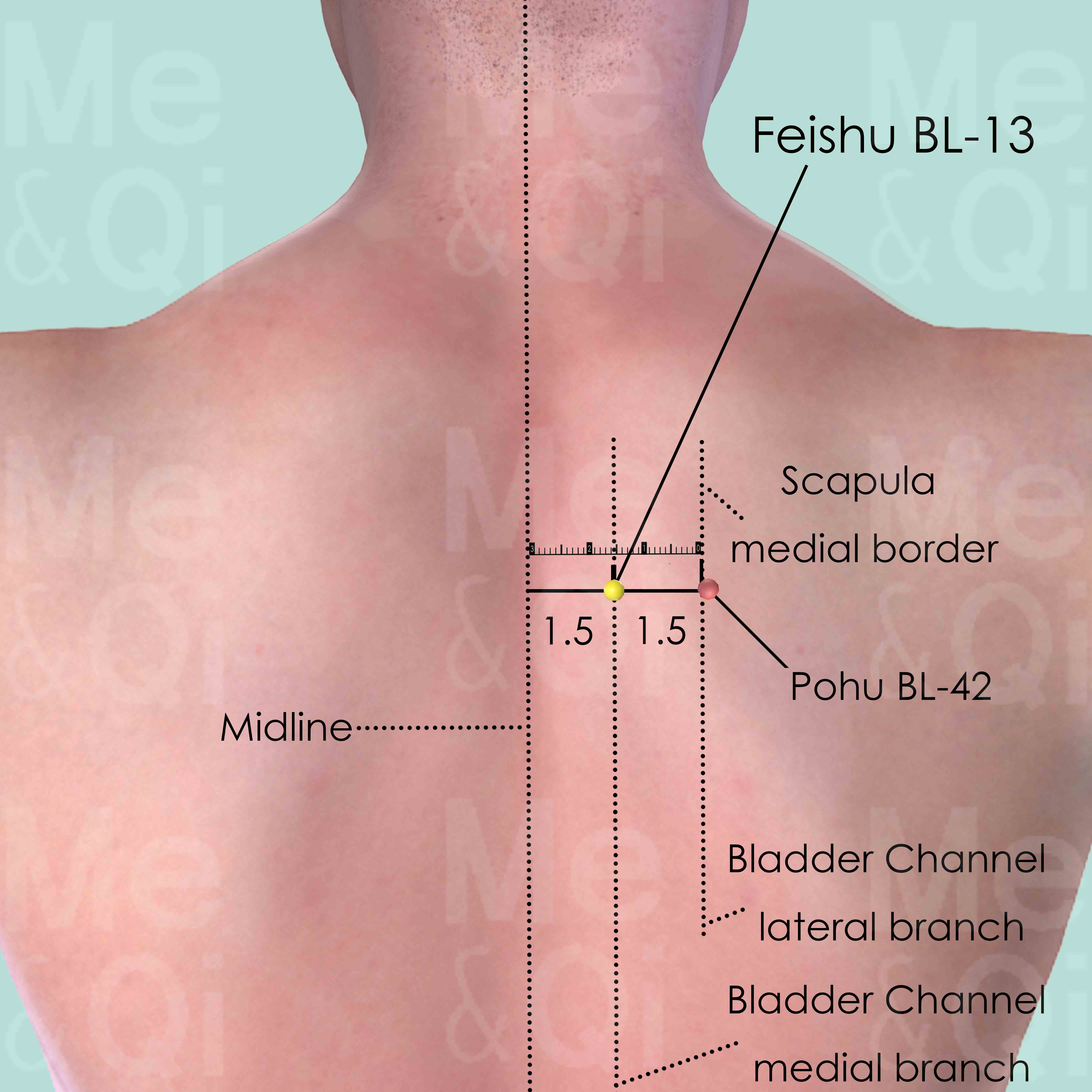
Feishu BL-13
1.5 cun lateral to the lower border of the spinous process of the 3rd thoracic vertebra (T3).
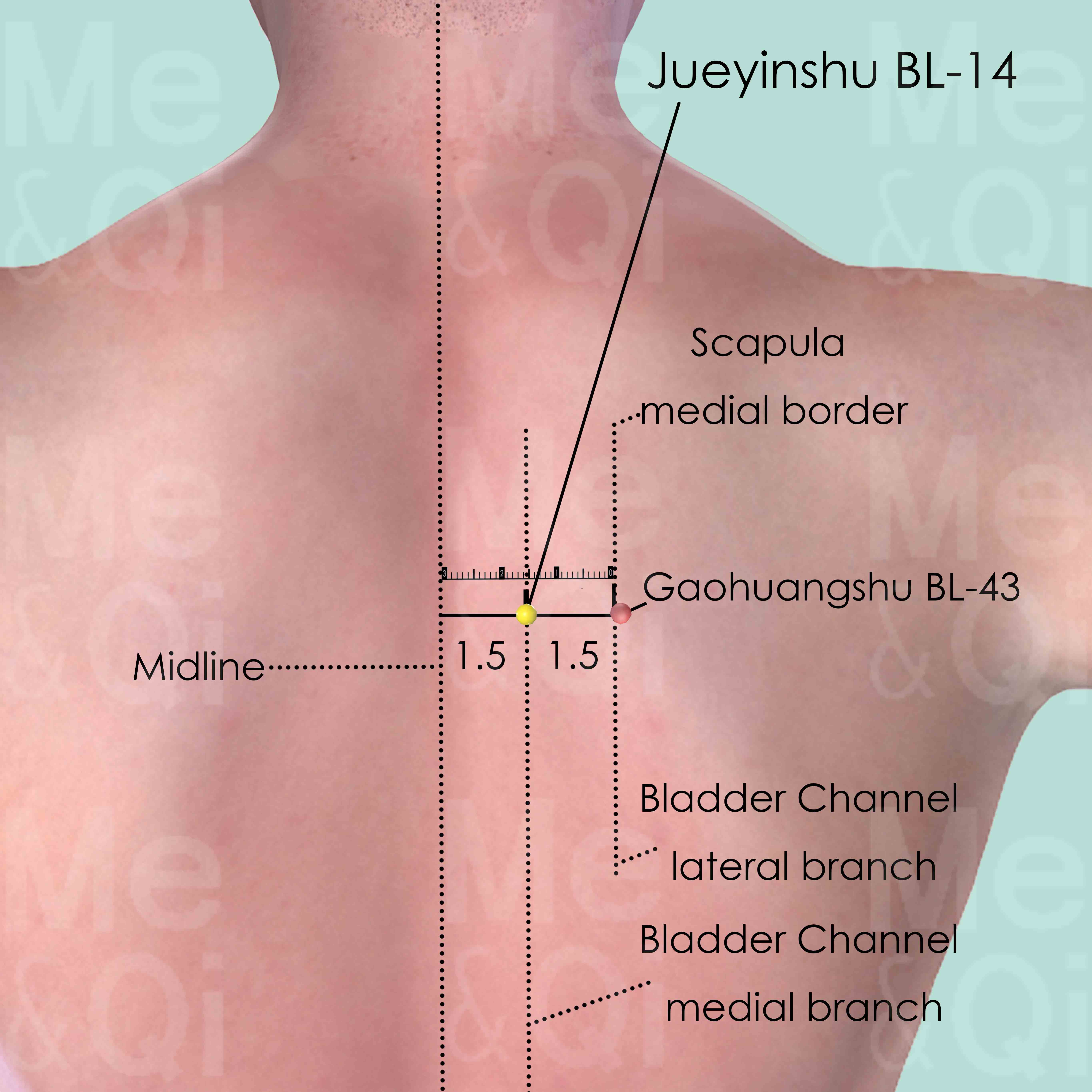
Jueyinshu BL-14
1.5 cun lateral to the lower border of the spinous process of the 4th thoracic vertebra (T4).
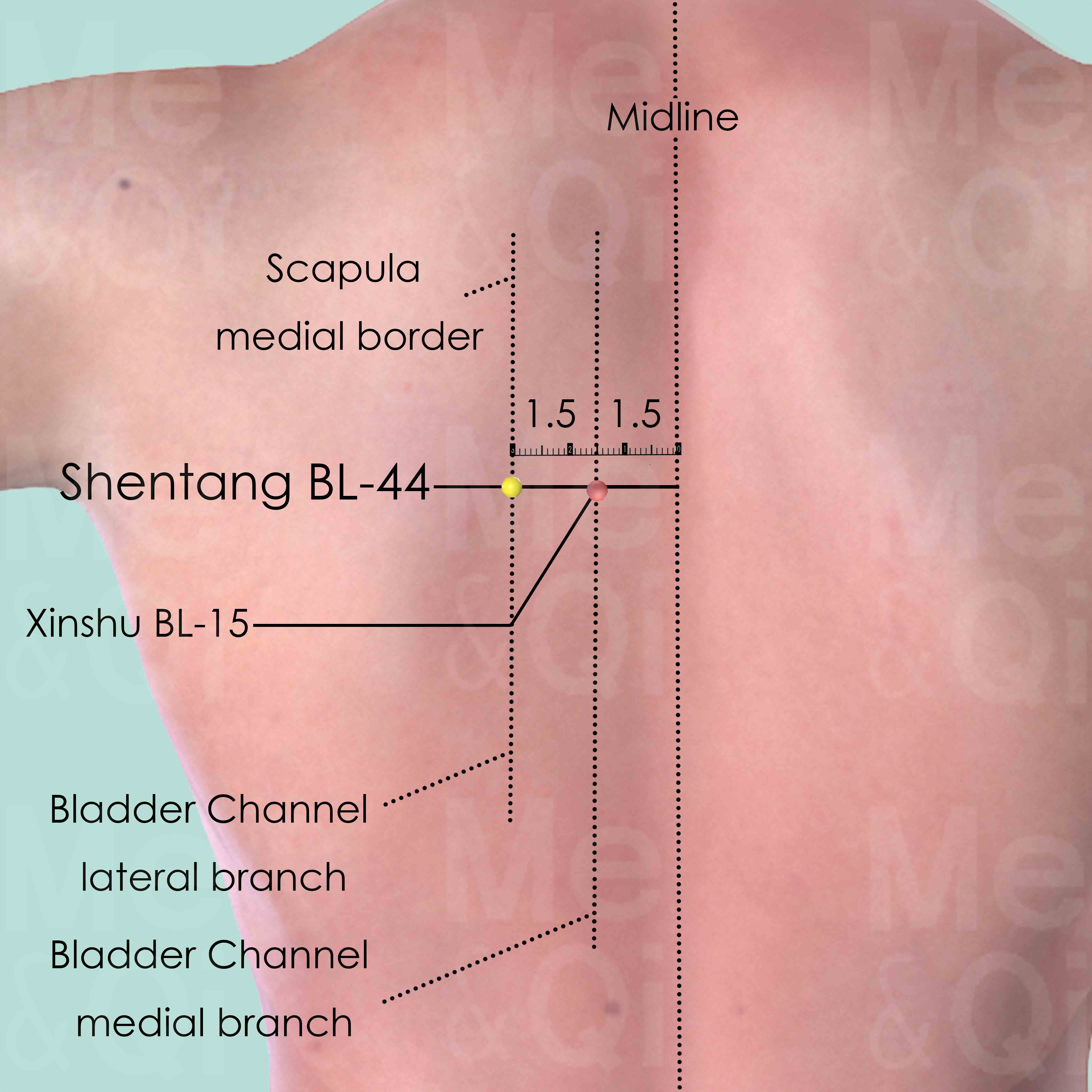
Shentang BL-44
3 cun (about 4 finger-breadths) lateral to the lower border of the spinous process of the 5th thoracic vertebra (T5).
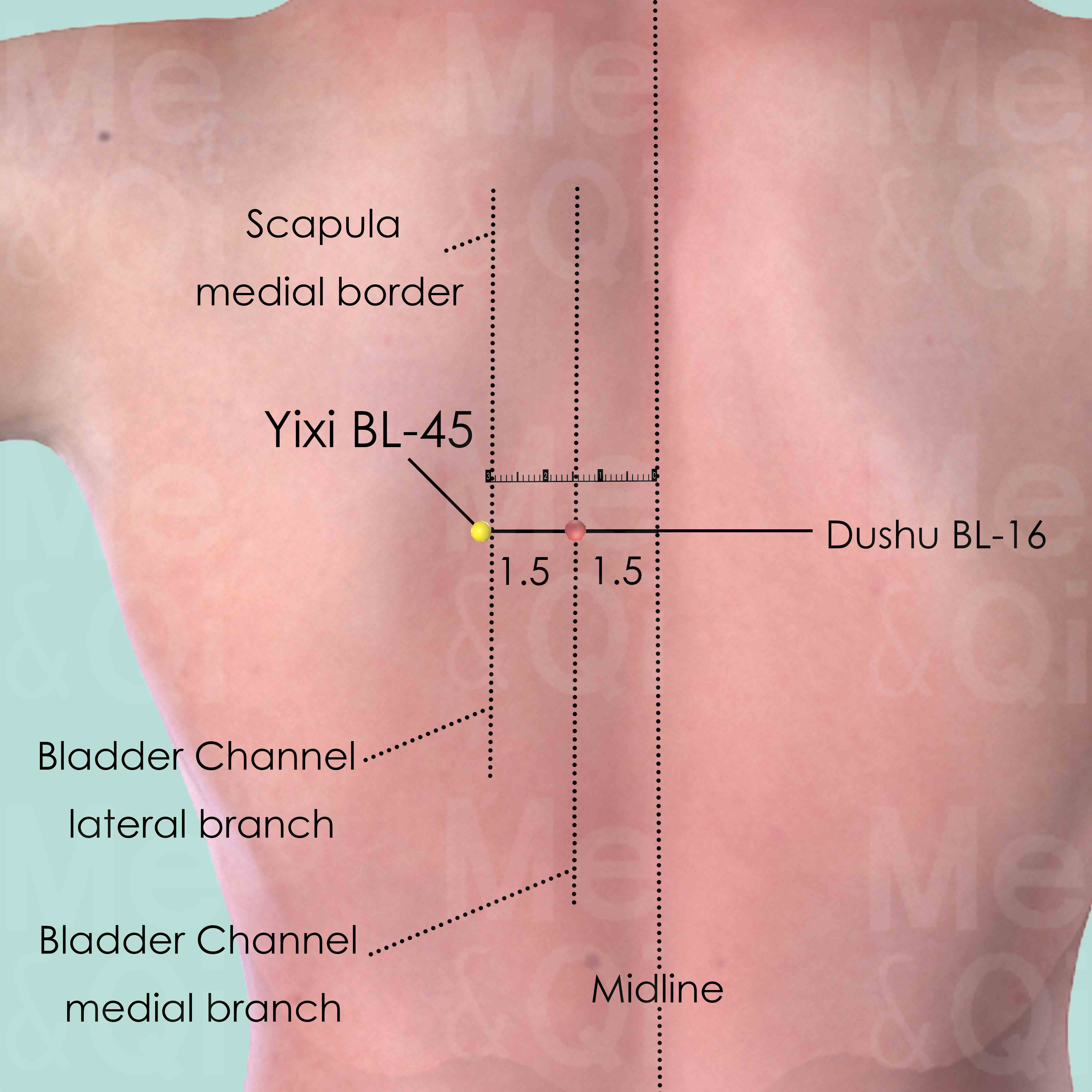
Yixi BL-45
3 cun (about 4 finger-breadths) lateral to the lower border of the spinous process of the 6th thoracic vertebra (T6).
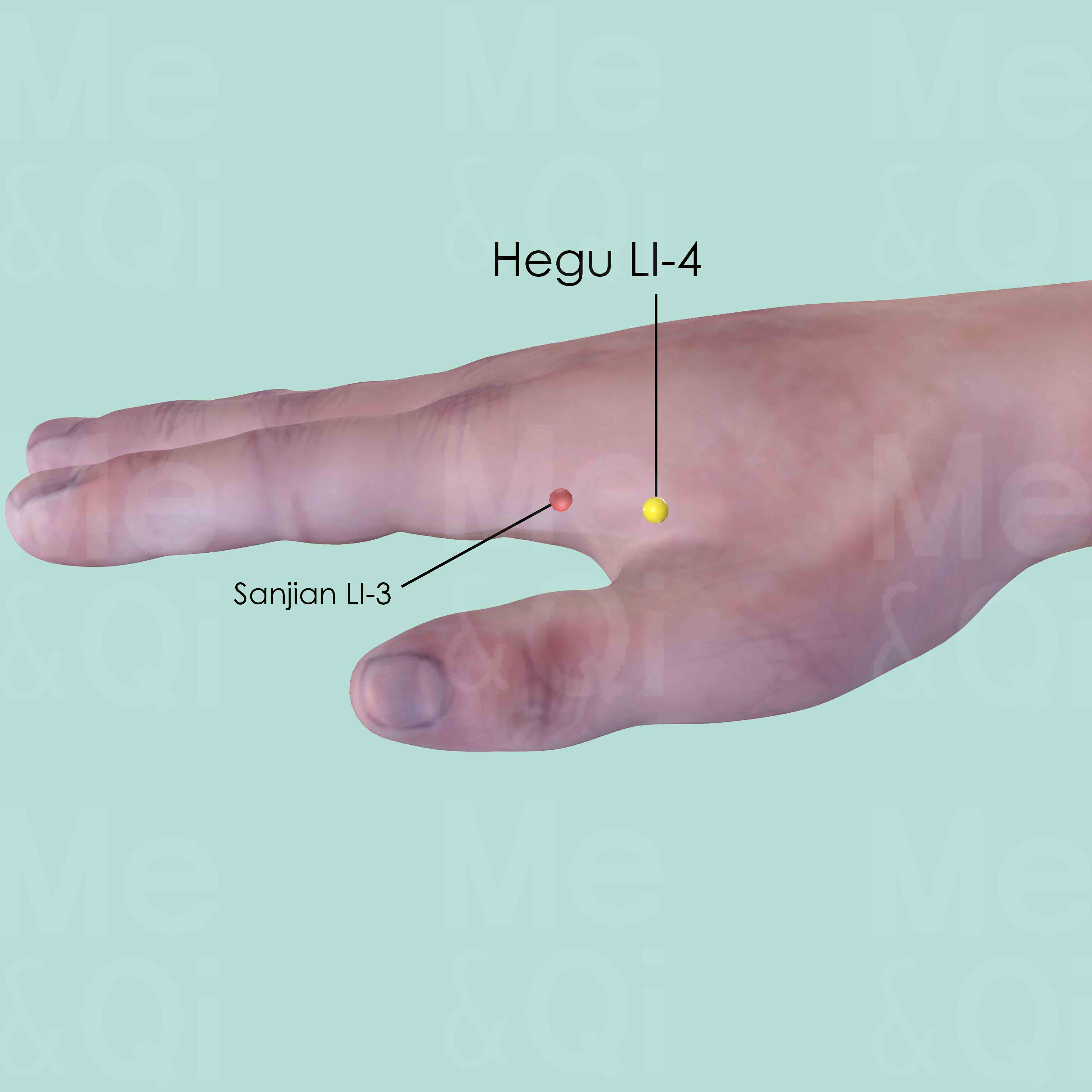
Hegu LI-4
Between the 1st and 2nd metacarpal bones, approximately in the middle of the 2nd metacarpal bone on the radial side.
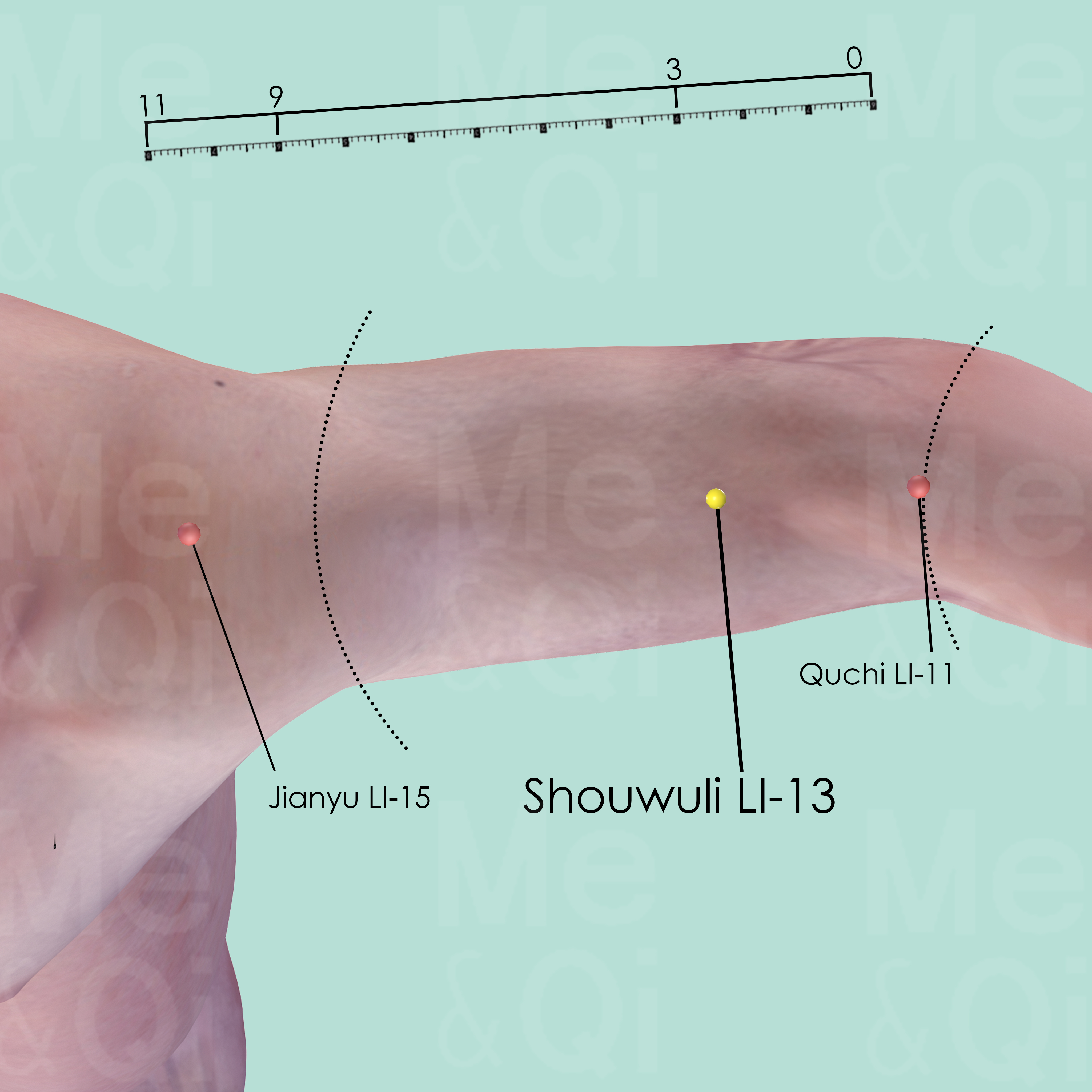
Shouwuli LI-13
Superior to the lateral epicondyle of the humerus, 3 cun above Quchi LI-11, on the line connecting Quchi LI-11 and Jianyu LI-15.
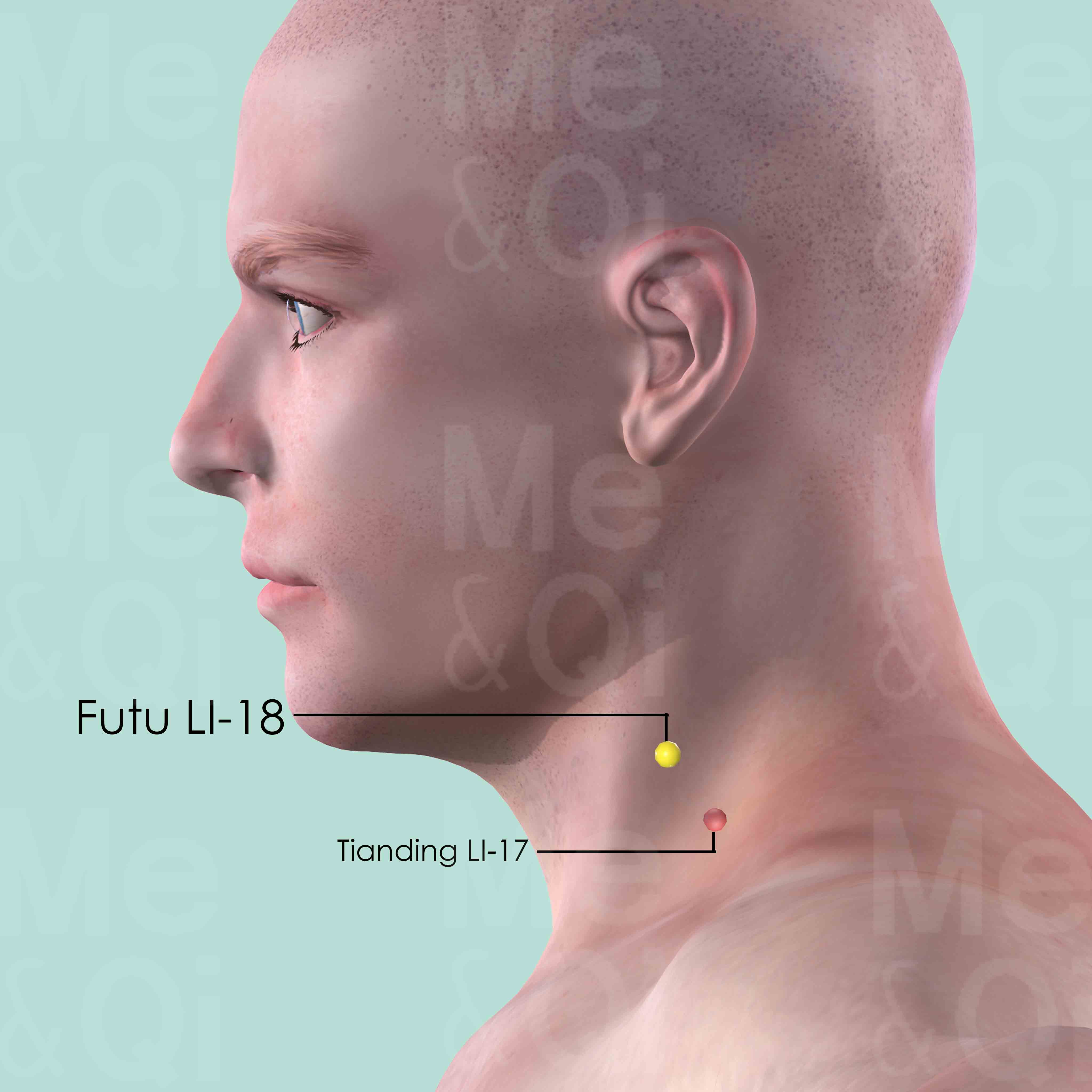
Futu LI-18
On the lateral side of the neck, level with the tip of Adam's apple, between the sternal head and clavicular head of sternocleidomastoid muscle.
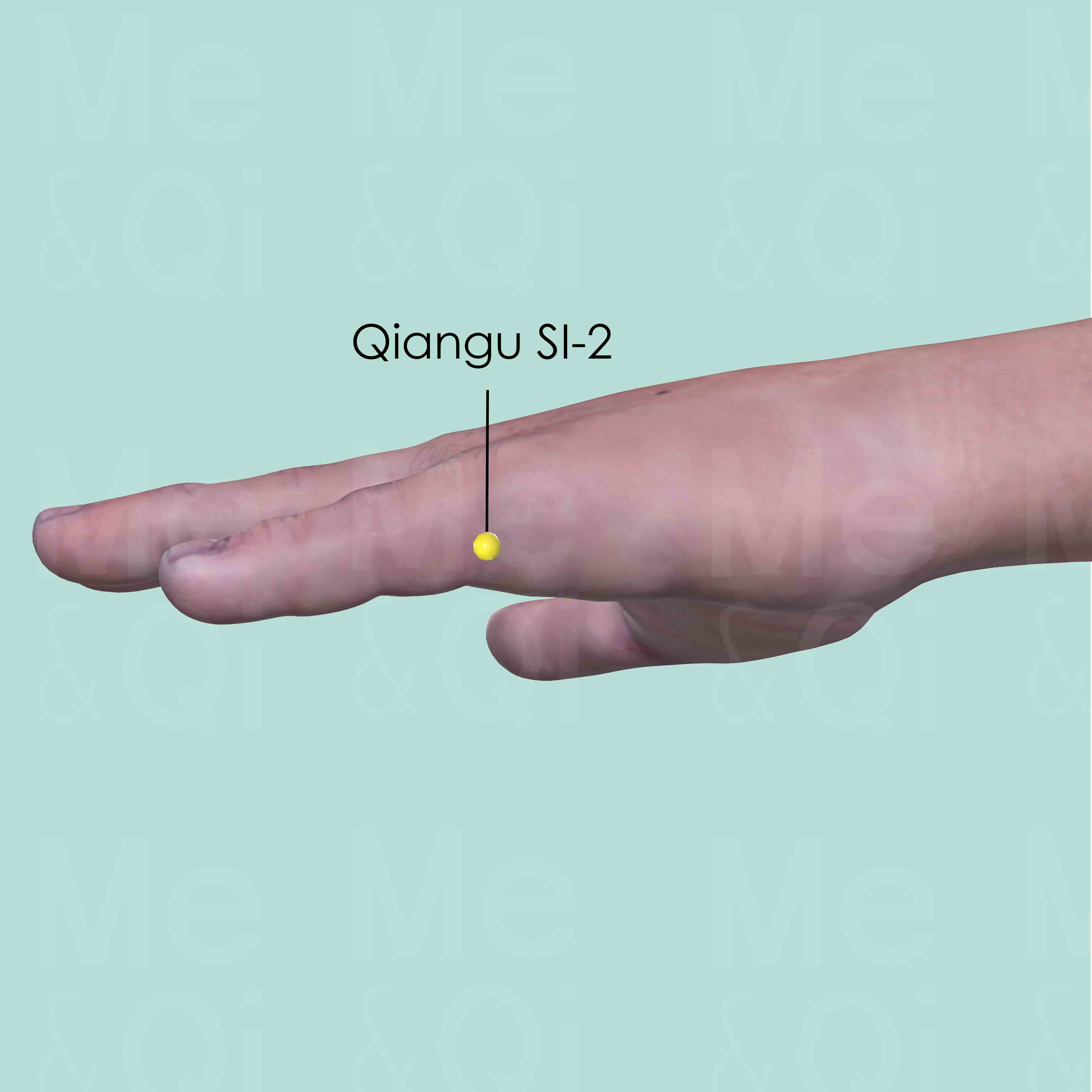
Qiangu SI-2
On the ulnar aspect of the little finger, distal to the metacarpophalangeal joint, at the junction of the shaft and the base of the proximal phalanx.
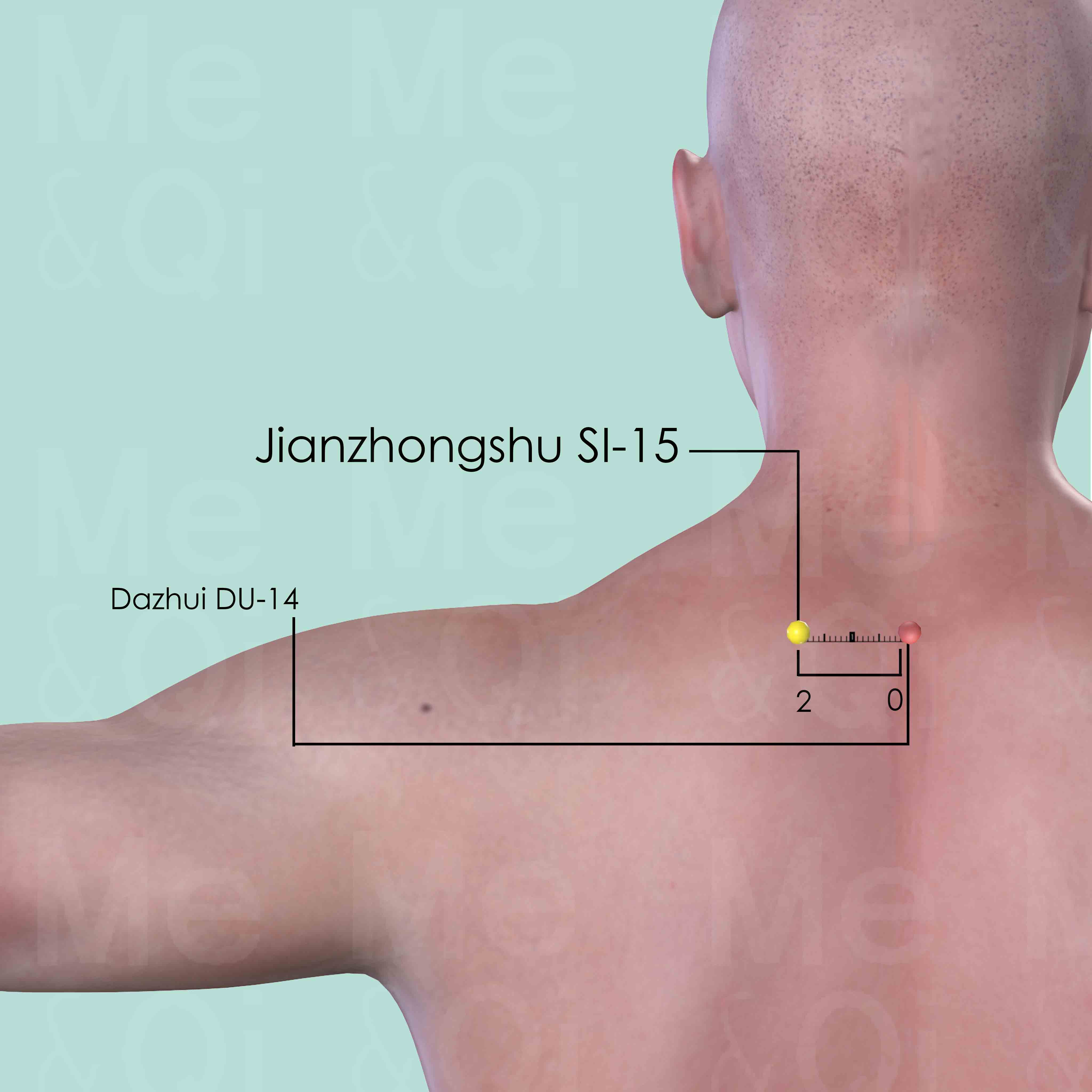
Jianzhongshu SI-15
2 cun lateral to the lower border of the spinous process of the 7th cervical vertebra (C7).
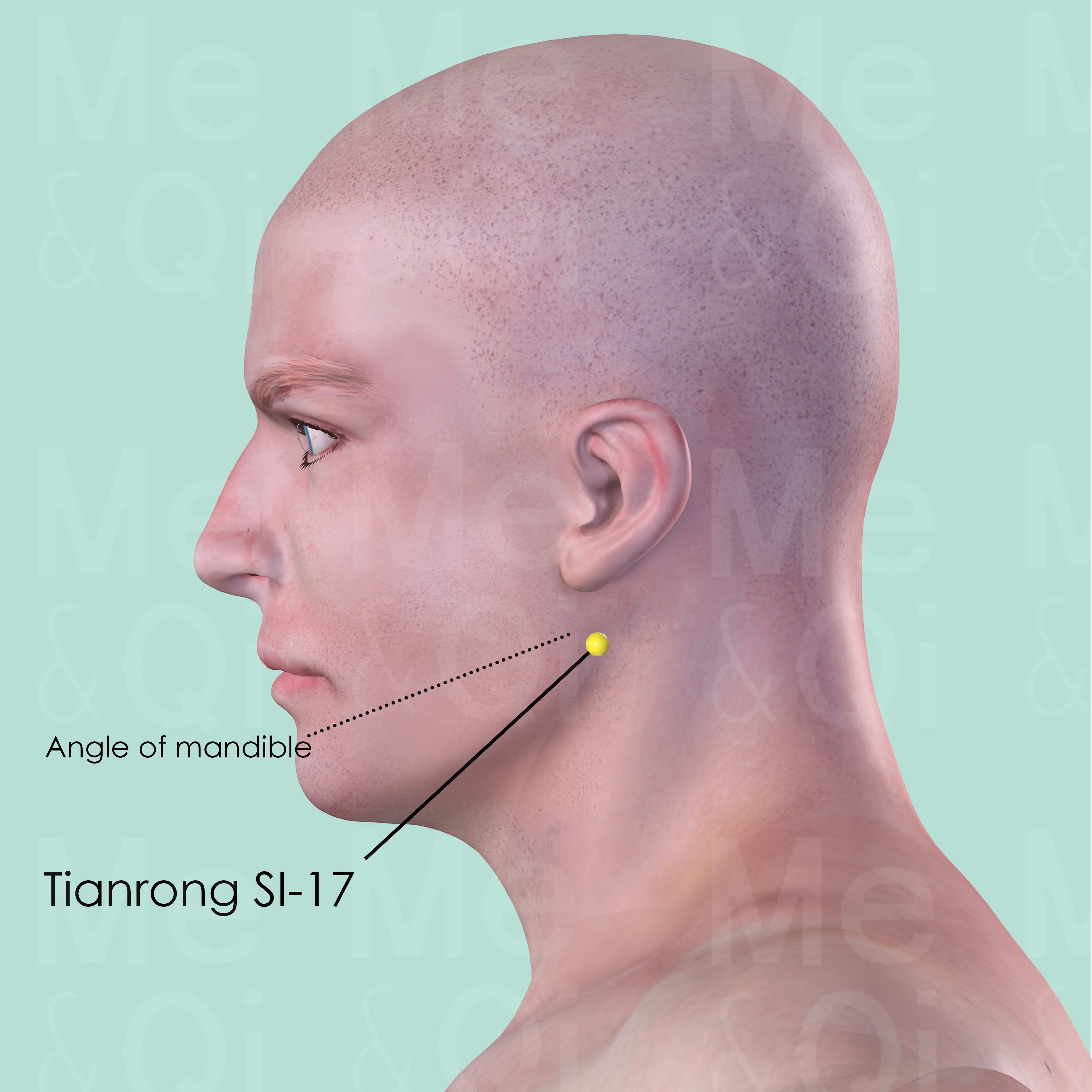
Tianrong SI-17
Posterior to the angle of mandible, in the depression on the anterior border of sternocleidomastoid muscle.
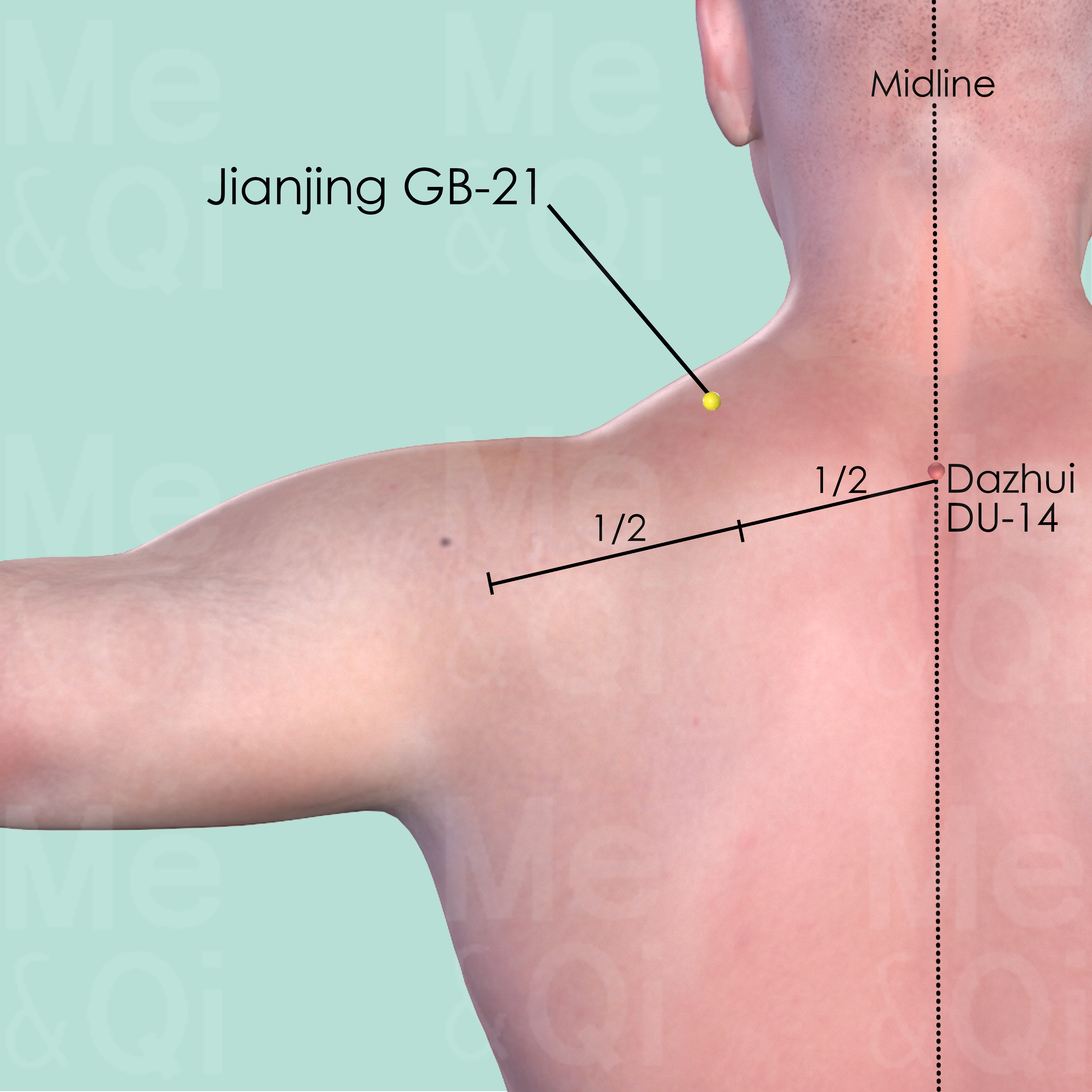
Jianjing GB-21
Midway between Dazhui DU-14 and the lateral extremity of the acromion, at the highest point of the shoulder.
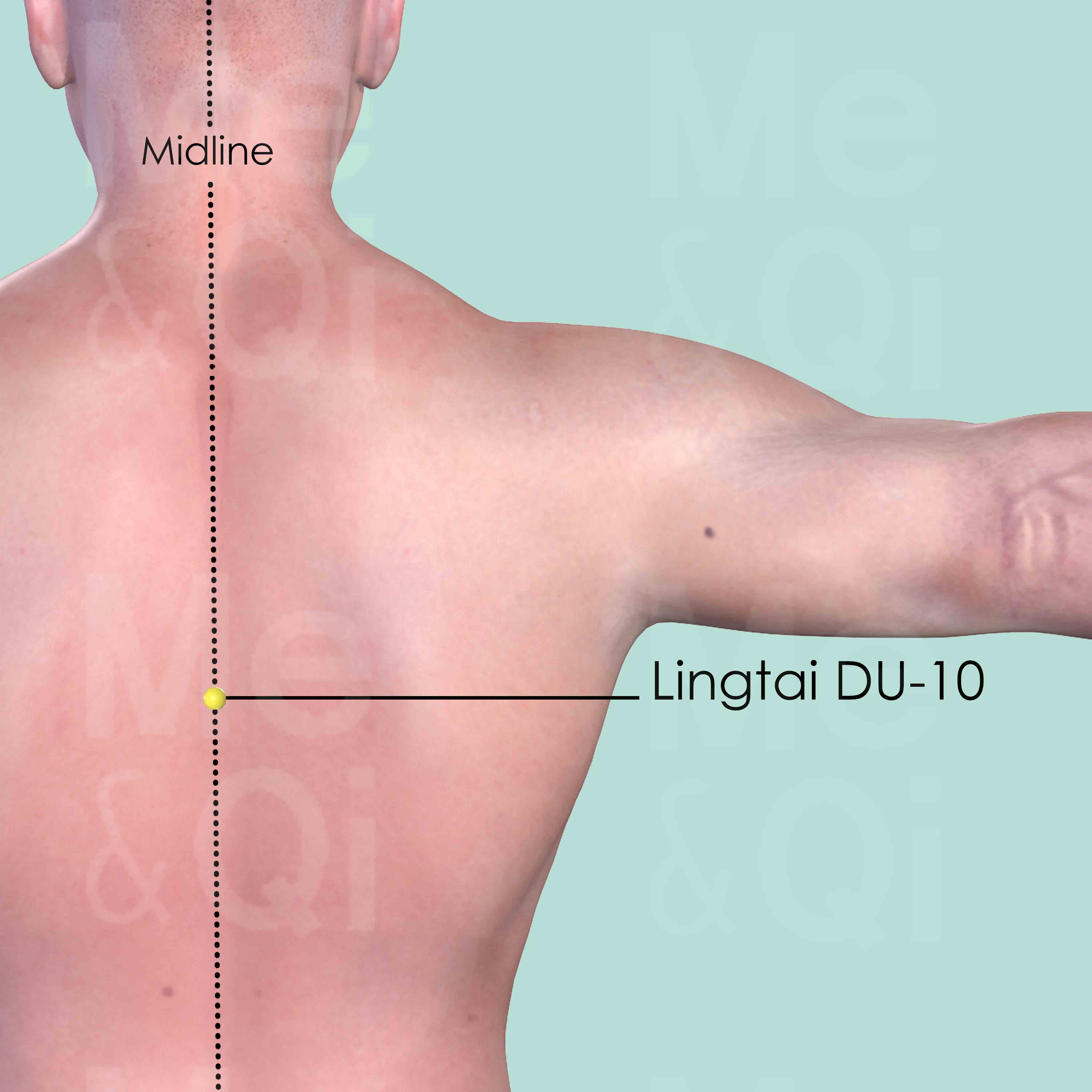
Lingtai DU-10
On the back midline, in the depression below the spinous process of the 6th thoracic vertebra (T6).
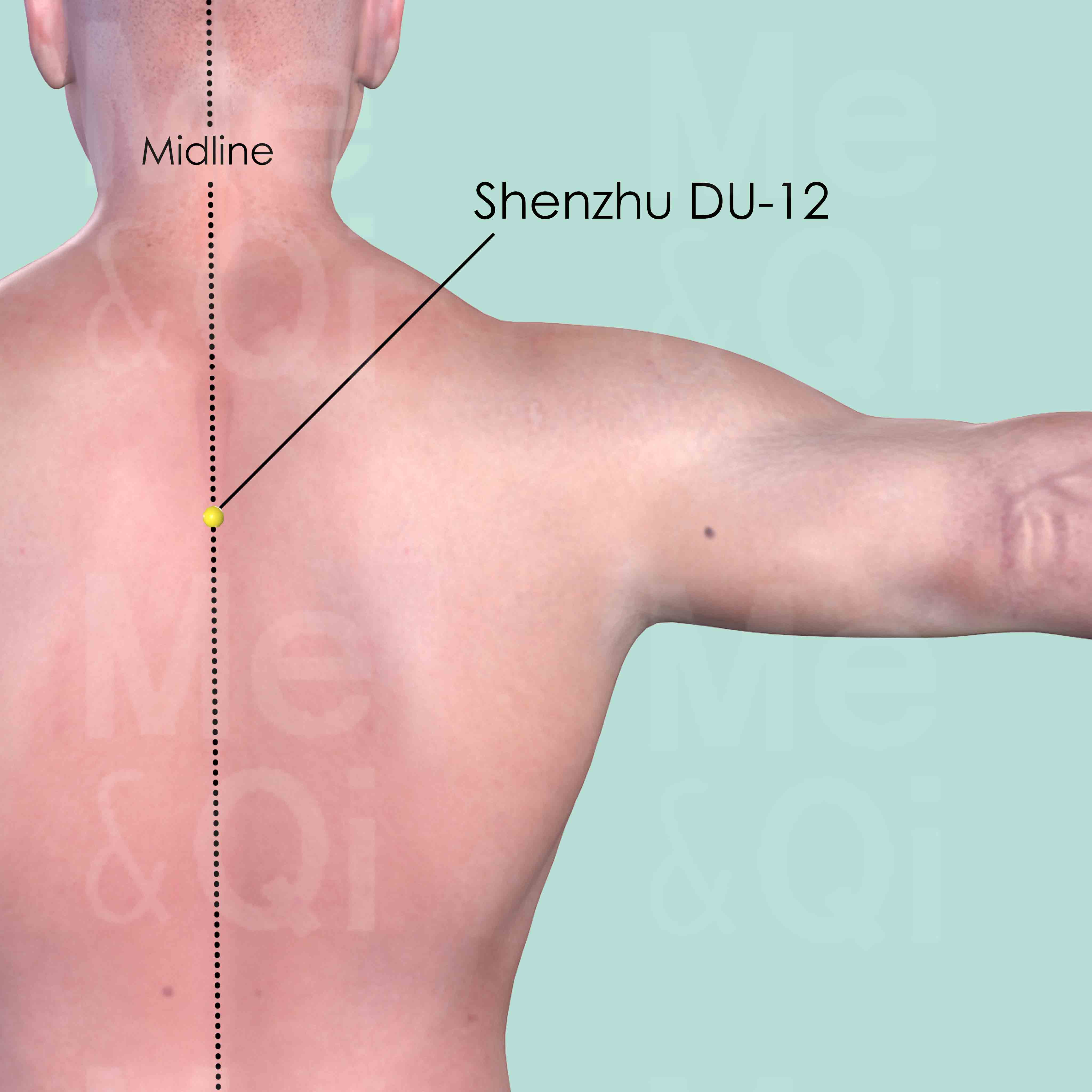
Shenzhu DU-12
On the back midline, in the depression below the spinous process of the 3th thoracic vertebra (T3).
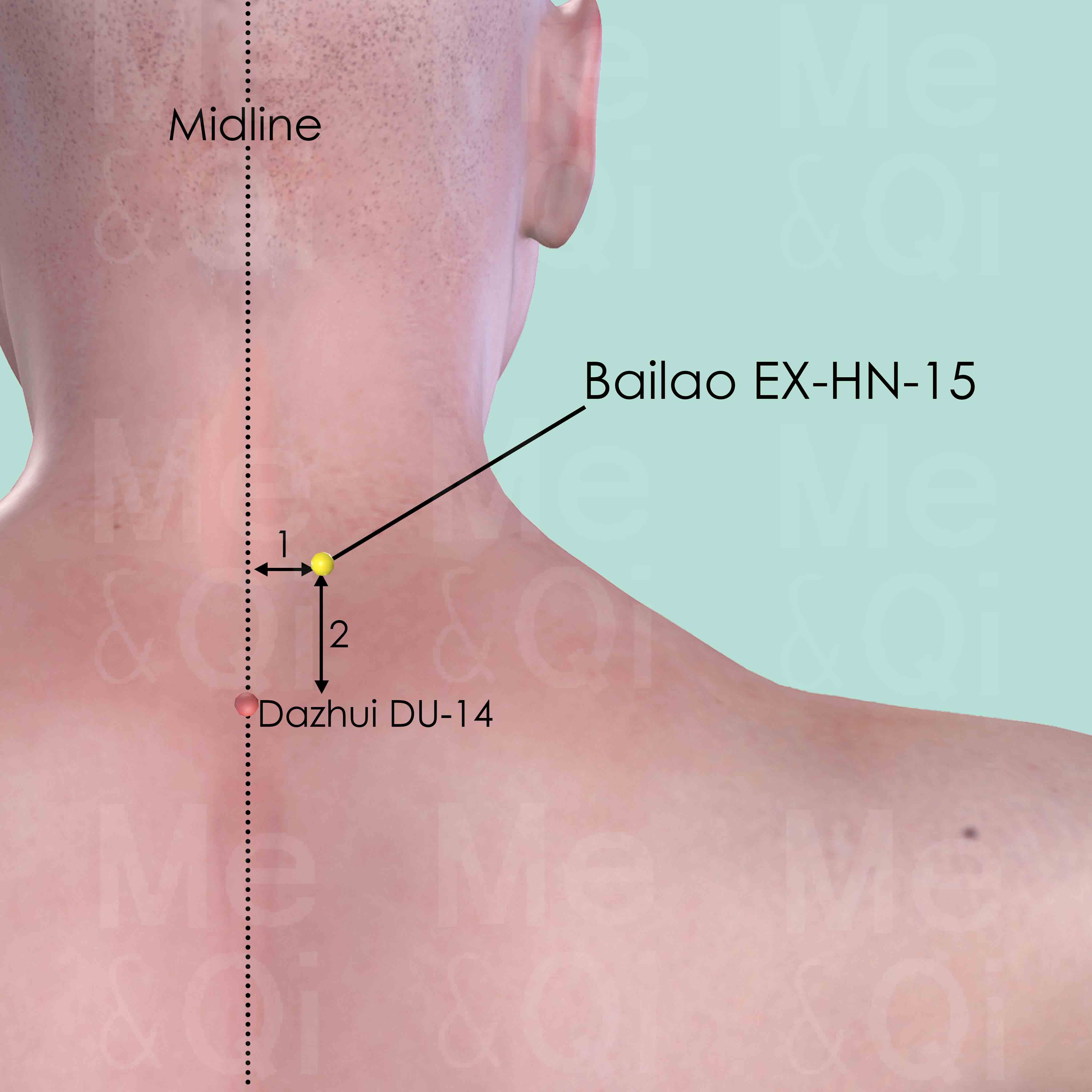
Bailao EX-HN-15
2 cun above the lower border of the spinous process of the 7th cervical vertebra (C7) and 1 cun lateral to the midline.
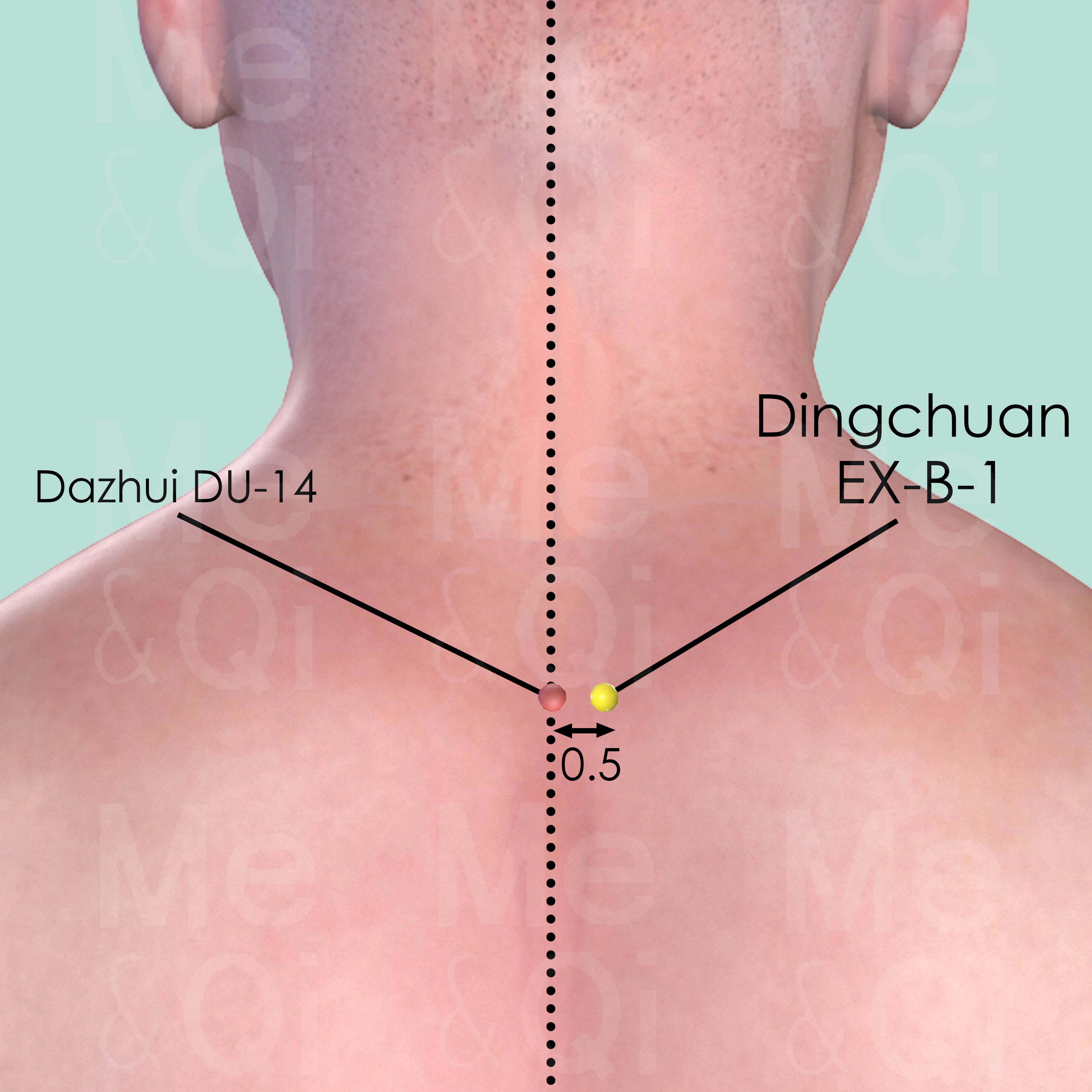
Dingchuan EX-B-1
0.5 cun lateral to the lower border of the spinous process of the 7th cervical vertebra (C7).
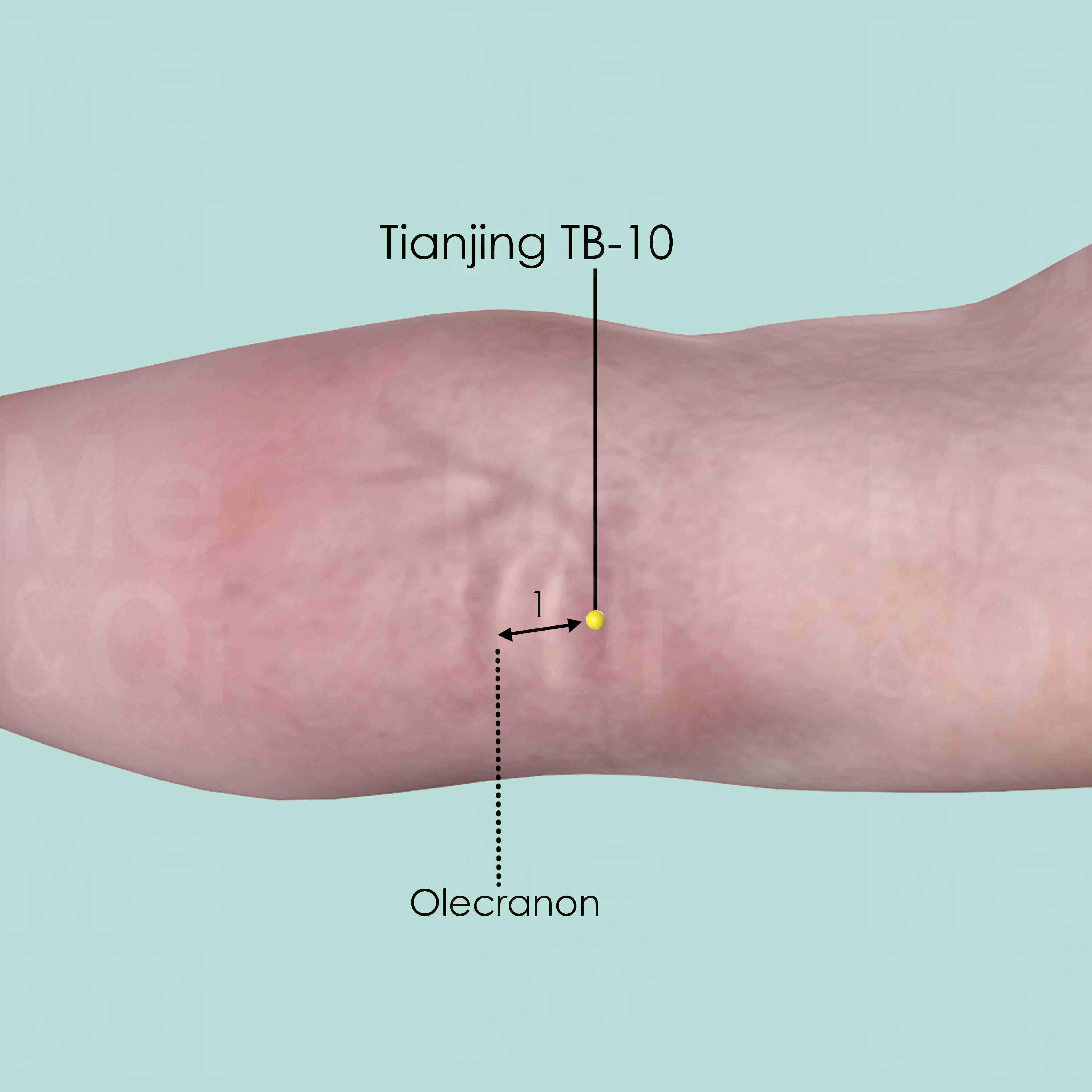
Tianjing TB-10
When the elbow is flexed, Tianjing TB-10 is in the depression about 1 cun superior to the olecranon.
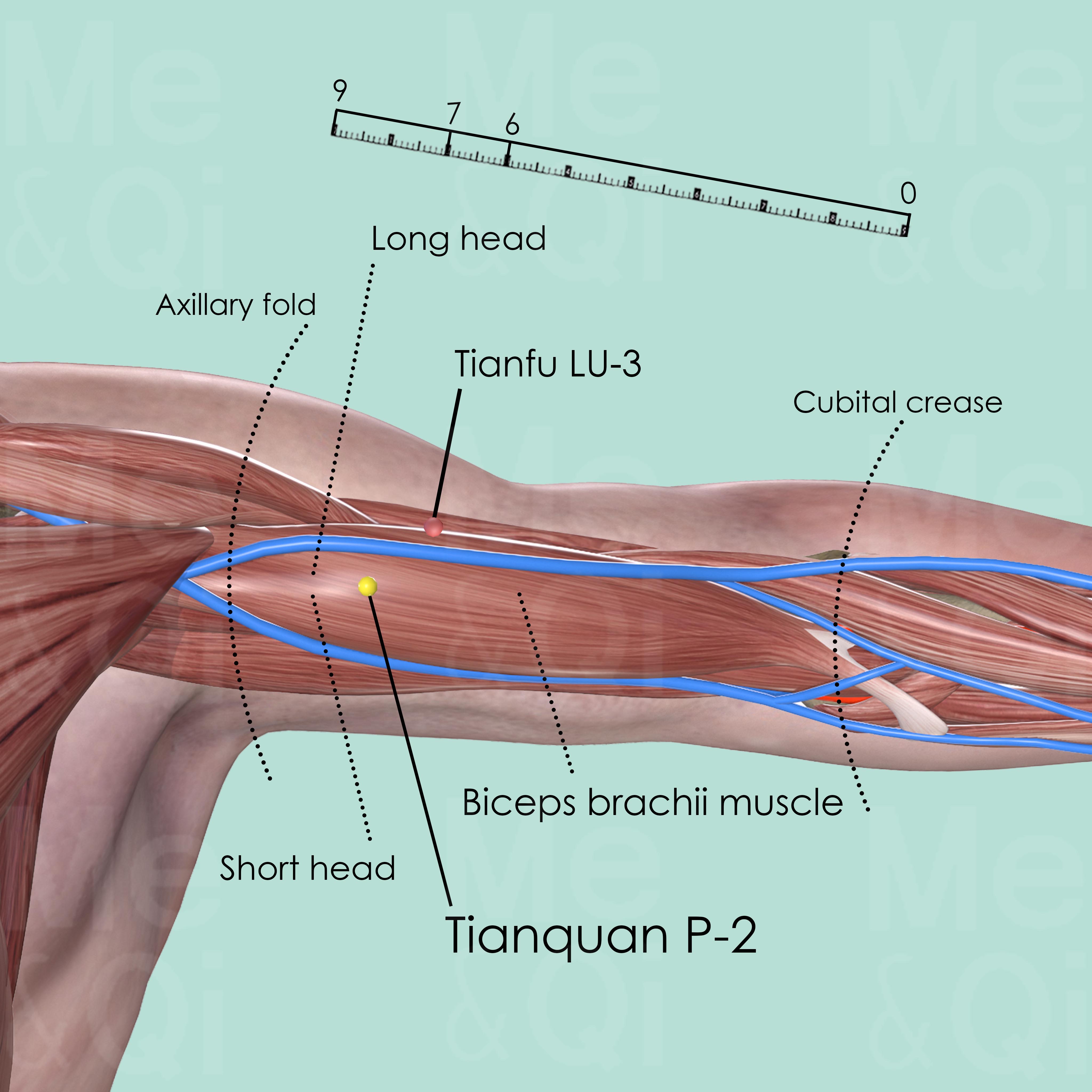
Tianquan P-2
2 cun below the end of the anterior axillary fold, between the two heads of biceps brachii muscle.

